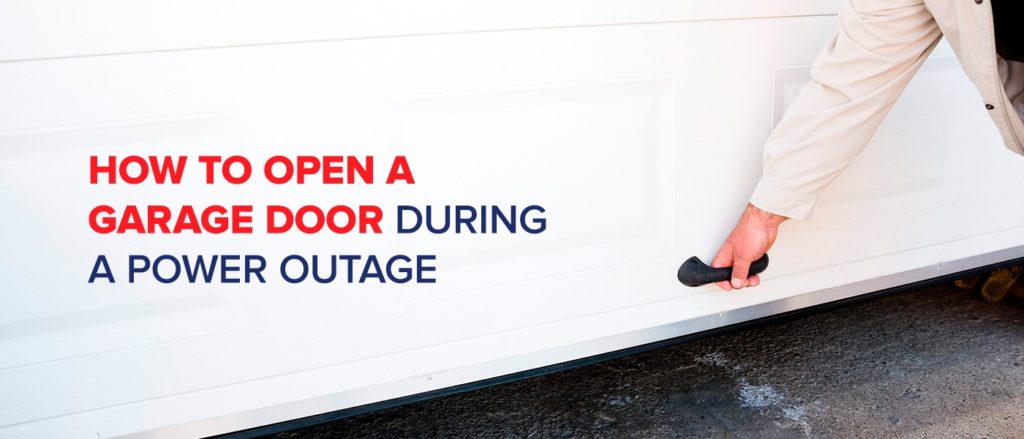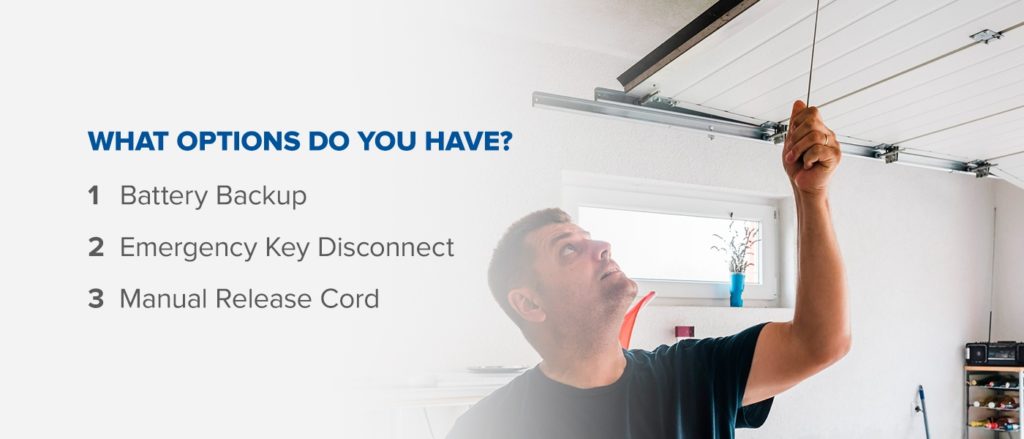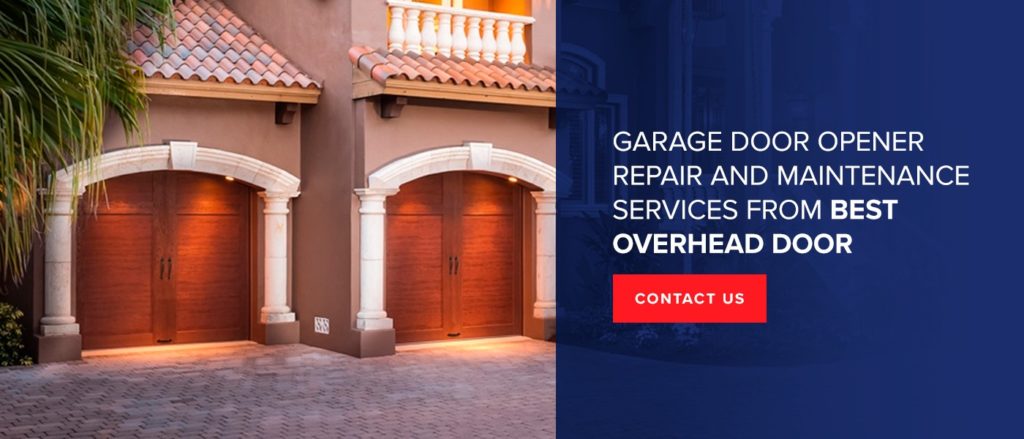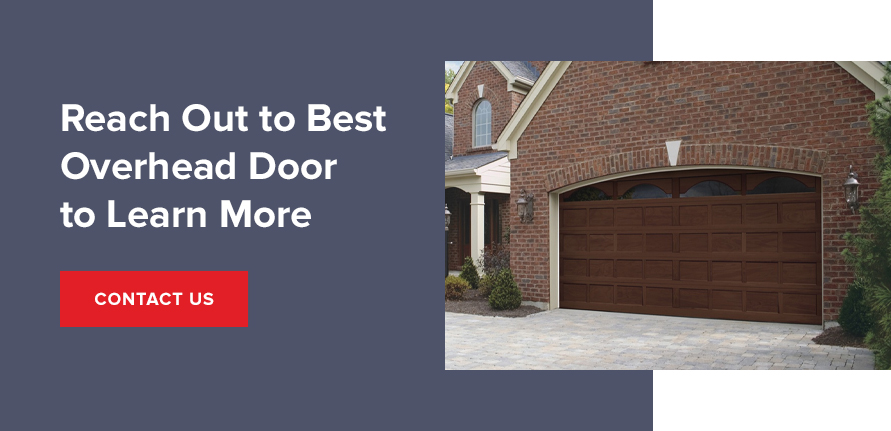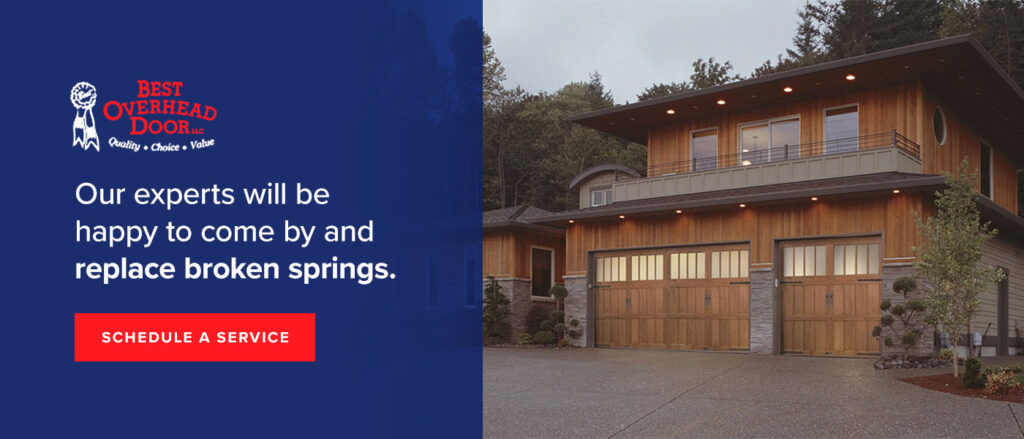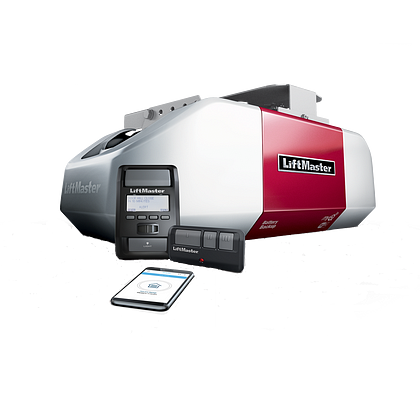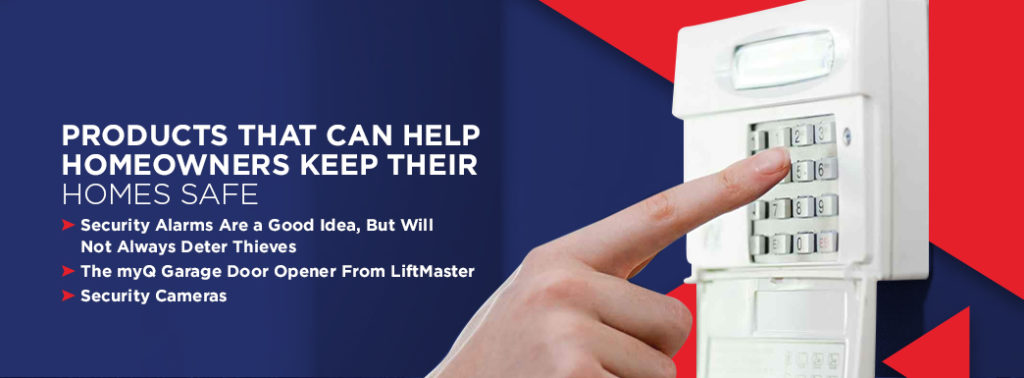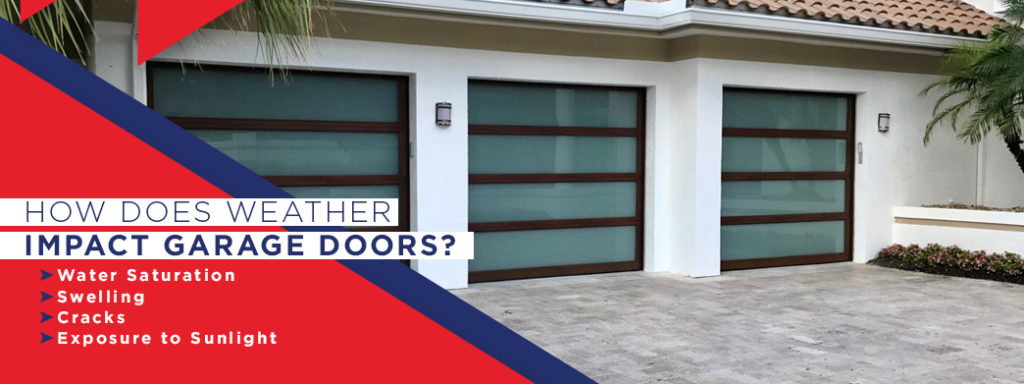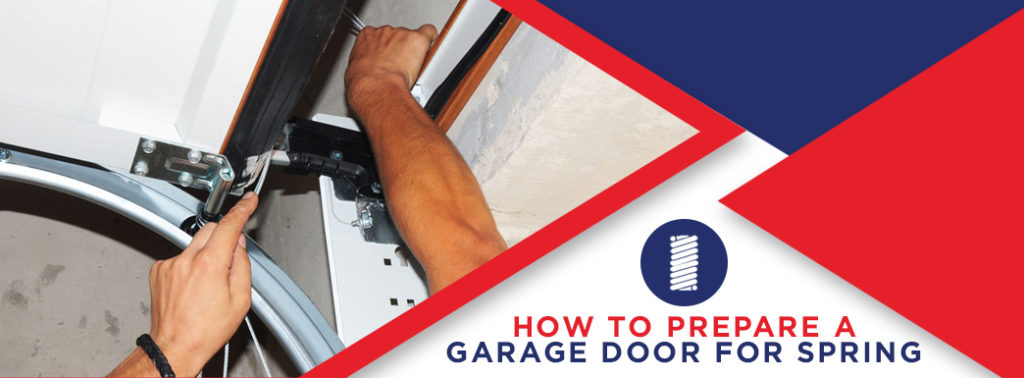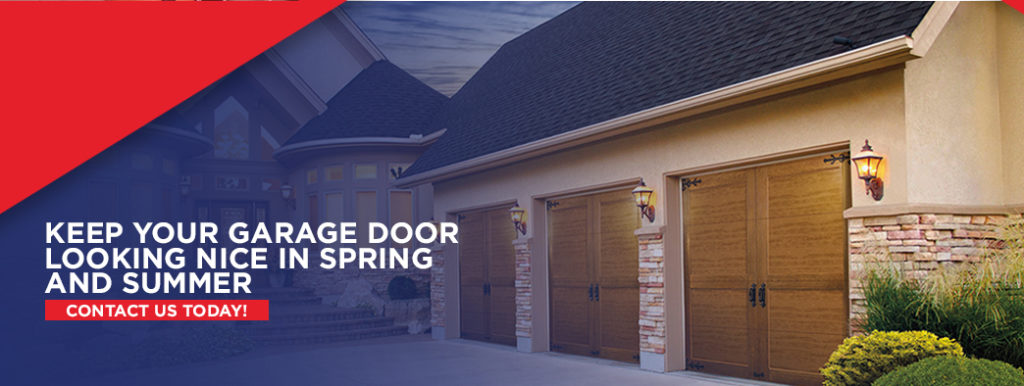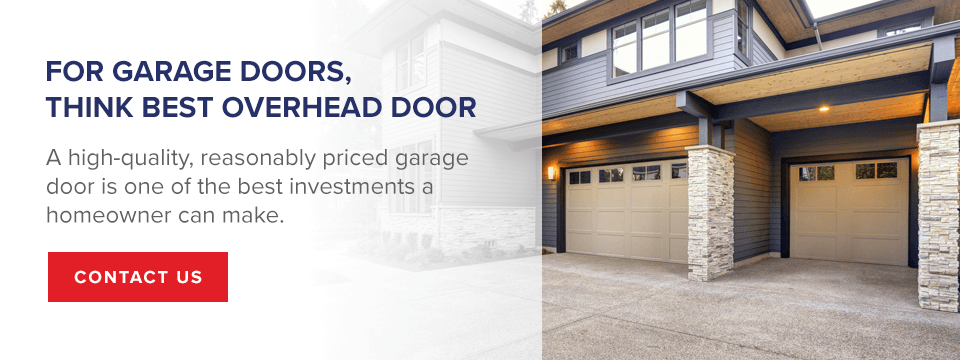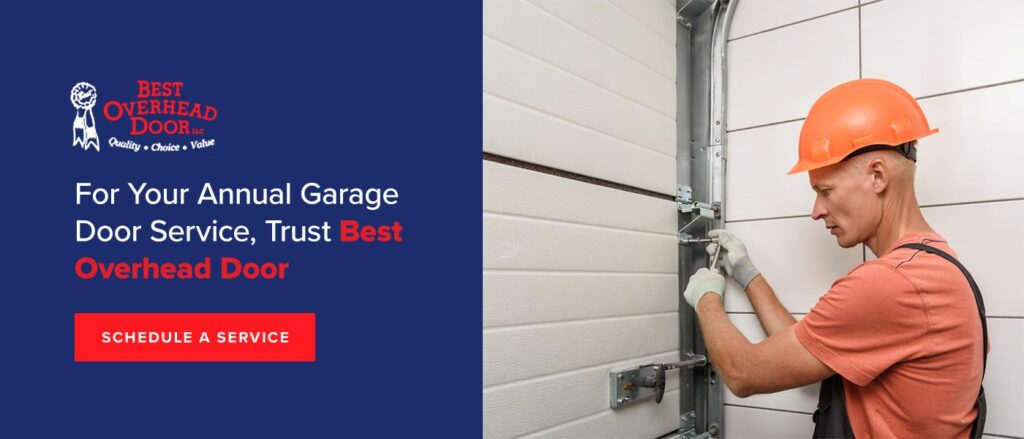How to Protect Your Garage Door From Heavy Rain
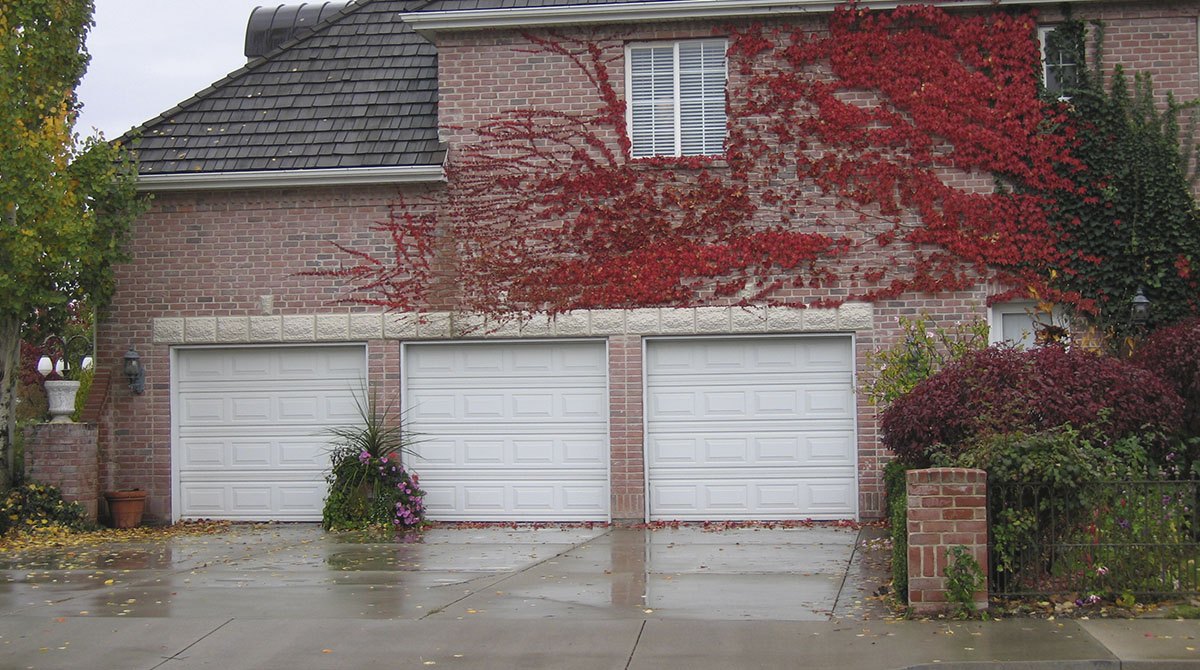
When a storm rolls through and brings a lot of rain, your house may be susceptible to water damage or flooding. The most vulnerable places that can experience water damage during heavy rain are your garage door and the inside of your garage.
Your garage door is the main protective barrier that keeps the items inside of your garage safe from the outdoor elements. If your garage door succumbs to water damage, it can impact the door’s integrity and potentially affect the belongings you store in the garage.
At Best Overhead Door, LLC, our experts know how to help you choose and install your doors, repair them and most importantly, protect them from heavy rain.
Why Is Water Coming Into Your Garage?
There are a few reasons water might be finding its way into your garage. It could be something as simple as the ground outside sloping toward your garage instead of away from it, or gutters that are clogged and overflowing. If the rubber seal at the bottom of your door is cracked or worn out, that can let water in, too.
Sometimes, small cracks in the concrete floor or walls give water an easy path inside, especially after heavy rain. If your garage door doesn’t close evenly or sit flat against the floor, that can leave just enough of a gap for water to come through. In some cases, it might even be due to a high water table or flooding in your area. A quick inspection or consultation with a professional can help you pinpoint the problem and stop water before it causes damage.
How to Stop Water From Coming Under Your Garage Door
If you don’t take the necessary steps to prepare your garage door for heavy rain and flooding, your door may experience damage or the inside of your garage may flood.
Take the best care of your garage door so it can last longer and protect the inside of your garage. Follow these helpful tips to prevent heavy rain damage to your garage door:
1. Replace Worn-Out Weatherstripping
You can weatherproof your garage door and the items inside your garage by replacing the weatherstripping on your garage door. People use weatherstripping on many outside entry points to prevent rain, snow and other outdoor elements from entering. The strip will make a secure seal on the bottom and sides of your garage door and prevent heavy rain from leaking inside.
If you have a newer garage door, ensure the weatherstripping is intact with no tears or rips. No worries if this all seems a little overwhelming. Best Overhead Door, LLC, can send a technician to take a look, as we provide many garage door services.
2. Test Your Garage Door’s Function
If a storm is coming your way and you know you’ll get a few inches of rain, make sure your garage door works properly. If you try to close your garage door before a big storm and the door is not working, the inside of your garage and all of your belongings can become soaked.
Start by testing its ability to open and close. Clean off the sensors and move any objects that might get in the way of the garage door closing. If something is off, you know to contact a technician to diagnose the problem and get your garage door back up and running.
With preventive maintenance services, you can avoid these issues and identify any problems with your garage door before they get worse.
3. Look at the Quality of Your Garage Door
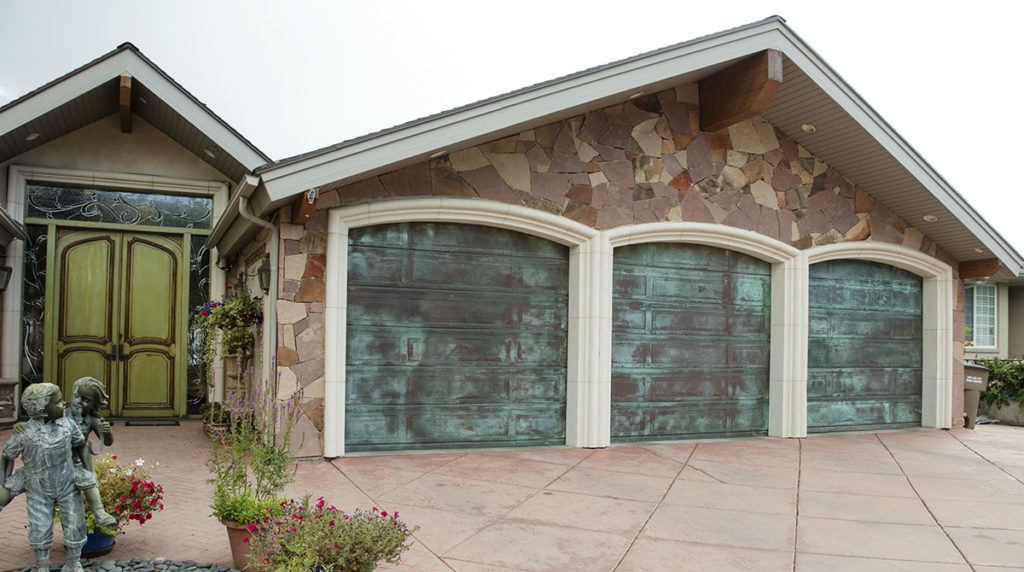
Look for any cracks or holes in your garage door that could let in water from a storm. The place you should pay extra attention to is the bottom of your garage door. If the panel has a crack or is warped and doesn’t align with the ground, rainwater can enter your garage. Our professional garage door technicians will show you how to seal the bottom of your garage door.
4. Add a Trench Drain
If the water flows toward your garage door, a bad rainstorm can quickly overwhelm your garage door with water. Installing a trench drain can help draw rainwater away from your garage and decrease the chance of it flooding or taking on too much water.
5. Clean Your Gutters
If you have rain gutters above your garage, check if you need to clean them out. You want water to flow away from your garage instead of falling down right on top of the garage door. If you don’t have gutters above your garage door, consider installing them to protect it.
6. Check the Water Path From Your Garage Door
Does the water flow away from or toward your garage door when it rains outside? If it runs toward the garage, make sure you have weatherstripping installed on the bottom or a trench drain to divert the water.
What to Do If Your Garage Door Gets Damaged or Flooded
If your garage door is experiencing flooding or water damage, here are the main actions to take:
- Clean up the water immediately to stop further damage.
- Start working on repairing the damage or contact a garage door service technician right away.
- Consider replacing your garage door if the damage is extreme.
Contact Best Overhead Door for Garage Door Service and Installation
When you need garage door service, you need help from the team at Best Overhead Door. We provide excellent maintenance, replacements and repairs and information on the best garage doors for residents in Washington and Oregon. If your garage door has water damage from a bad rainstorm or you want routine maintenance on your door, contact the experts at Best Overhead Door to schedule service. We offer 24/7 emergency service, so call us at 503-707-0848.
FAQ’s
How do you stop water from coming under your garage door?
If water keeps entering from under your garage door, there are a few things you can do to keep it out. Installing a threshold for your garage door is a simple way to block out rainwater, leaves and pests while creating a tighter seal at the bottom. For bigger issues like frequent flooding, you might consider having a professional check for cracks in the floor or foundation that need sealing.
What is the difference between weatherstripping, a trench drain, a rain deflector and threshold seals?
Weatherstripping is the flexible rubber or vinyl strip attached to the bottom of your garage door. It helps seal the gap between the door and the floor to block water, dirt and pests. Threshold seals are like a rubber bump or ramp that you can attach directly to the garage floor, just behind the door. When the door closes, it presses against the threshold to create a tighter seal.
Rain deflectors are small, sloped barriers installed outside the garage, just in front of the door. They’re designed to redirect water away from the entrance, especially during heavy downpours. Trench drains are long, narrow drains installed in the concrete in front of your garage door. They collect and carry away water before it reaches your garage.
How do you improve drainage to prevent rain from coming into your garage?
If rain keeps sneaking into your garage, it might be time to take a closer look at how water flows around your home. If water tends to collect right in front of your garage, a trench drain might be a good fix. It’s a narrow drain that sits just outside the door and catches rainwater before it can get inside. For areas with frequent runoff or soggy spots, a French drain can help move excess water away from your foundation.
How to Open a Garage Door During a Power Outage
We often take automatic garage door openers for granted, especially when they are working as they should. Garage door openers rely on electricity to operate the opening and closing of the door. But will the garage door open if you lose power? Without power to the opener, you may be stuck either inside or outside the garage.
If you’ve experienced this situation, you’re aware of the frustration and inconvenience it can cause. Fortunately, there are a few solutions to this problem, and it is possible to open the garage door when the electricity is out. In this guide, we’ll cover a few different methods for opening the garage door without power.
Using the Manual Release Cord to Open Your Garage Door From the Inside
Every garage door opener should have a manual release cord, so this may be the best way to open the garage door from the inside in case of an emergency. We’ll cover the basic steps for how to open a garage door manually from the inside using the release cord:
1. Make Sure the Door Is Down
Before you attempt to manually move the door, ensure the door is down or in the closed position. If the garage door is up or in the open position, pulling the manual release cord can be extremely dangerous. This is because it puts all the pressure on the springs. If the springs are broken or damaged, pulling the cord causes a higher risk of the entire door falling off the tracks and onto whatever is below. If you’re standing below the door, this could result in serious injury, as well as damage to your car and anything else in the garage.
2. Pull the Release Cord
As long as the door is down, you can pull the manual release. You’ll find the manual release cord hanging from the main opener motor unit. This cord is often colored red and may have a T-shaped plastic handle at the end that is easy to grab. Pull the handle on the release cord to unlock the door from the opening mechanism.
3. Manually Move the Door as Needed
At this point, you should be able to safely and easily push the door open. Move the door up and down as many times as needed during the emergency, but be sure to return the door to the closed position when you are done. This is an important step in order to return the cord to a safe position, resume normal function and ensure the release cord is in the right position the next time you need it.
4. Pull the Release Cord Back Toward the Door
This step allows for the trolley to be connected again and for the spring lever to return to the connected position as well. Simply pull on the release cord again, downward and towards the door, away from the motor.
5. Reconnect the Trolley and Opener Carriage
Next, you’ll need to connect the trolley to the opener carriage again, and there are a couple different ways to do this. One method is to manually push the door until the trolley and opener carriage reengage. An even easier method is to push the button on your remote or keypad, and the connection should happen automatically. You should hear a loud click as everything locks back into place. Then, the emergency release cord should be reset and waiting for the next time you need it, and your garage door should be able to function normally.
How to Manually Open an Automatic Garage Door From the Outside
If you arrive home and find that your garage door won’t work after a power outage, you can follow these steps to open the door safely:
- Find the cable for emergency release: The release cable is by a small lock near the center at the top of your garage door’s exterior. Use your key to open this lock and access the release cable.
- Take out the emergency cord: When you unlock and pull out the tumbler, you will find a cable that triggers the mechanism to allow you to open your door manually.
- Release the garage door: There is likely another lock on your garage door next to your door handle. Use your key to open the door and put the handle in a vertical position.
- Open the door: Grab the handle and pull your door straight upward all the way so it will remain in position before you or your car enters the garage.
- Shut the door: Once inside the garage, pull the garage door down until it is completely closed.
What Options Do You Have When There’s No Power?
If the power goes out and you need to open your garage door, do you know what to do? You may have a few different options to fix the problem. However, the best solution for you will depend on the specific brand and model of garage door opener that you have, and what special features are included. It can also depend on the situation you’re in — for example, why the electricity is out and if the opener is still functioning otherwise. Here are the three most common options for opening a garage door without power:
1. Battery Backup
Some models of automatic garage door openers come equipped with a backup battery. This allows you to open the door with your remote or keypad, even if the area experiences an electricity blackout. However, this function will likely not work if the opener is broken, malfunctioning or if the battery is dead.
Check your unit’s manual to see if you have this feature and if you should check to make sure the battery backup is charged and ready for an emergency. Note that this feature is often only included if the garage door is the only entrance and exit to the garage, and when there is no other door for people to use.
2. Emergency Key Disconnect
This is another emergency feature that is usually only included if the garage door is the only entrance or exit to the garage. If you have this feature, you’ll see a keyhole lock partway up on the outside of the garage door. You should have a key for this lock, which you can use to open the emergency disconnect.
When unlocked, the unit pulls a cable out that will disengage the lock on the opener motor, so you can manually open your garage door by pushing the door up. This method works during a power outage, and even if the opener is broken or malfunctioning.
3. Manual Release Cord
This feature comes standard with any automatic garage door opener on the market today. With normal functioning, the opener locks your door in the closed position as a safety feature, so someone can’t push the door open at any time. However, in an emergency situation, you can pull the manual release cord to disengage the opener lock, so you can open the door manually.
Garage Door Safety Tips
Before you begin trying to open a garage door manually, make sure that you and those around you will be safe. Some top safety tips include:
- Keep the automatic door opener unplugged: Unplugging the garage door opener before manually opening or reconnecting the door will keep you safe in case the power comes back on randomly. It will also prevent damage to your door, as the opener may try to open the door while disengaged, which can make it harder to reconnect.
- Make sure the door is closed before opening it manually: Don’t pull the emergency release cord when the door is open, as it can cause the door to come crashing down. If your door is open and the power goes out, it’s best to wait for the power to come back on or to call a technician for help.
- Don’t leave an open door unattended: After disengaging your door, nothing is in place to stop it from slamming shut, so it’s essential not to leave it unattended. Stay clear of the doorway and keep children away until you can close the door.
- Use a professional when needed: Know when it would be best to call a professional, especially if you notice the door shaking or uneven movement after reconnecting your door.
Garage Door Opener Repair and Maintenance Services
Now that you know how to open a garage door without electricity, you’ll be more prepared for the next power outage or other emergency. If you’re experiencing problems when the electricity is working and you need garage door opener repair or maintenance, contact Best Overhead Door for service. For nearly 30 years, we’ve been the go-to garage door opener service company for the entire Portland, Oregon, metro area, including Tualatin and Tigard, Oregon, as well as Vancouver, Washington. Give us a call at 503-620-1205 or contact us online to schedule your service today.
How Long Should a Garage Door Last?

When it comes to your home, you likely know how long certain elements will last, such as the roof, appliances and flooring. How long a garage door lasts, however, might feel like a mystery. By understanding the length of your garage door’s life span and following a proper garage door maintenance plan, you can ensure you get the most out of your door and save money while doing so.
Garage Door Life Span – How Long Do They Last?
Most garage doors last anywhere from 15 years to almost 30. One of the main components of a garage door that affects its garage lifespan is the extension and door springs. When closed, the torsion springs are above the door, and the extension springs are parallel to the horizontal tracks. If your spring breaks, it is typically a good time to look at other parts of your door such as the panels and sections. Based on their condition, you can get repairs or explore a replacement.
Factors That Affect Your Garage Door’s Life Span
A garage door could meet or exceed its anticipated life span, or you may need to replace it sooner than expected. Several factors can impact how long a garage door will last:
- Use: Your garage door experiences wear and tear each time you use it, and the more you use it, the faster it will wear down. For example, torsion springs last for about 10,000 cycles. When you open and close your garage door three times a day, that’s about 1,000 cycles a year, meaning you’ll need to replace it in 10 years.
- Maintenance schedule: Regular maintenance will extend the life span of your garage door. Your maintenance cycle may also include fixing issues and tending to door parts, which means your door can better withstand daily wear and tear.
- Climate: Weather plays a large role in your garage door’s life span, as high heat, storms and winds can weaken the door or cause damage.
- Material: Different materials have different longevity. For example, options such as steel last up to 30 years.
- Quality: Higher-quality doors are typically more expensive but can require fewer repairs to save you money.
How Often Should You Replace a Garage Door?
As your garage door gets older, it will likely need more and more repairs. However, it can be hard to determine whether another repair is worth it or if you should replace your garage door entirely. Some signs a complete replacement may be your best option include:
- Your door is at least 20 years old
- Your door has begun to sag
- Your door is very loud or noisy
- You often make extensive repairs
- If your garage door is wood and the wood has become warped, chipped or cracked
- If your garage door is aluminum and the door has lots of dents and dings
- The door doesn’t open or close correctly
- You want to improve insulation or boost your curb appeal
How Long Does a Garage Door Opener Last?
The life expectancy of a garage door opener is typically 10 to 15 years. Since openers are essential for opening and closing your garage door, you’ll want to perform regular maintenance to ensure the opener continues to operate at its peak. If you’ve been having issues with your motor, it’s best to call a professional as soon as possible so you can continue to use your door without any issues.
Most homeowners start replacing their motor before 10 to 15 years. As technology improves, motors continually evolve, with many newer models offering better features and longer life spans. For example, many newer garage door openers allow you to open them with a smartphone app for more convenient use. Regardless of whether you wait the entire life span or replace your opener sooner, ensure you follow proper maintenance guidelines to keep your opener in excellent condition.
Ways to Increase Your Garage Door’s Life Span
While many of the factors that impact a door’s life span are out of your control, you can take several steps to help it last longer:
- Examine safety features: Your door should have a sensor-activated auto-reverse mechanism to keep the door from crashing to the ground. Ensuring your garage door system has the correct safety features and verifying that they are working properly can help prevent door damage.
- Inspect hardware: The door’s springs, cables, pulleys, bolts and other hardware can loosen over time. Checking these items can help your door function correctly and lower the damage risk.
- Test the door’s balance: A properly aligned door will operate smoothly, reducing the likelihood of mechanical issues that could shorten its life span.
- Clean and lubricate moving parts: Well-lubricated components generate less friction, reducing the chance of premature wear.
- Wash the panels: Keeping the panels clean will prevent dirt and corrosion from harming the finish and causing the door to deteriorate faster.
- Clean the tracks: The tracks and rollers allow the door to move smoothly. Cleaning them regularly will contribute to a longer garage door lifespan.
- Care for the weatherstripping: The rubber weatherstripping at the bottom and sides of the door keeps dirt, debris and insects from entering the space. Ensuring that this feature stays intact — and replacing it when necessary — will help to preserve the door.
Do You Need a New Garage Door? Contact the Pros at Best Overhead Door
Are you a resident in Tualatin, Tigard, Oregon, or the Vancouver, Washington, areas in need of a new stylish and durable garage door? If so, We offer estimates via phone, email and video conferencing or we can bring our showroom to you with hand samples and brochures. We’re a local company with over 30 years of garage door sales, installation and maintenance experience. We’re open to all residents of the metro area and we stock a full selection of Clopay® garage doors — guaranteeing the best quality construction and modern design.
We can educate you so you make the smartest ROI for your house. To learn more about our products and services, complete our online contact form or call us today at (503) 620-1205 to speak to one of our specialists.
Related Posts
Does My Garage Door Need Regular Maintenance?
Home Improvement Projects With the Best ROI
How Often Should Your Garage Door Be Serviced?
High Cycle Garage Door Springs
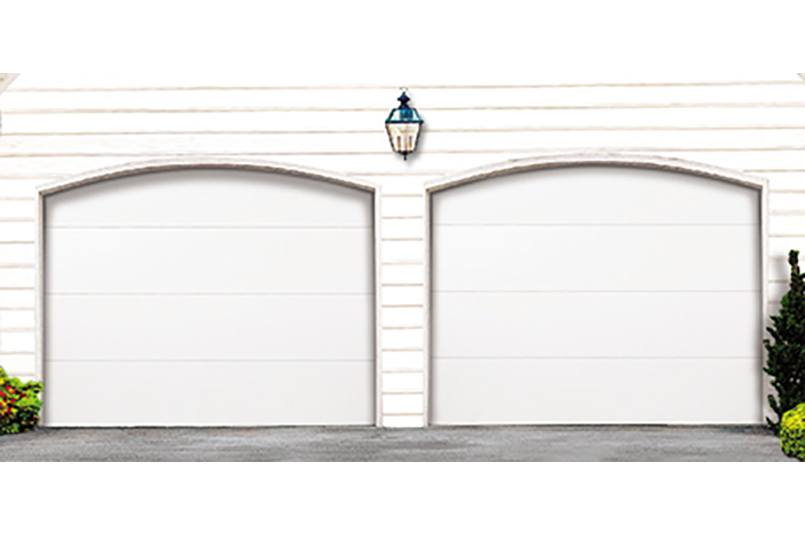
Your garage door consists of many different parts, with the springs being some of the most important. Many modern garage doors use a torsion spring, lasting about 10,000 open and closing cycles. So, if you use your garage door three times a day, your springs will last about 10 years.
Usage is not the only element affecting your springs’ life span. Weather and your maintenance routine can also cause your springs’ life span to shrink. Luckily, there’s an alternative with high cycle springs that allow you to get more out of your garage door.
What Are High Cycle Garage Door Springs?
High cycle garage door springs are an essential part of any garage door system because they hold the entire weight of your garage door and aid in opening and closing. As the garage door lowers, the springs become tightly wound. When you open the garage door, the springs unwind to provide the force to lift the door safely. The two types of garage door springs include:
Extension Springs
An extension spring is on either side of the garage door track and is around two to four feet long. Extension springs extend when the door moves to store the energy needed for opening and closing.
Torsion Springs
A garage door torsion spring mounts to torsion poles parallel to the garage door and uses weight and gravity to gain and release tension when the door is opened and closed. The main difference between an extension spring and a torsion spring is torsion springs twist one way when the door closes and another way when the door opens.
Why Garage Door Springs Break
Garage door springs can break for various reasons, making it essential to perform regular maintenance to identify potential issues before they become significant problems. Some reasons why a garage door spring may break include:
- Excessive use: Opening and closing your garage door multiple times per day creates tension on the spring coils, making them more likely to break.
- Worn out springs: Wear and tear is a common cause of spring breaking. Over time, the springs may become cracked and require repair or replacement to prevent a complete break.
- Corrosion: When you expose springs to excessive moisture, they can become rusty and eventually break.
- Sudden impact or force: Sudden impact, such as something falling on or hitting the door, can cause the springs to break.
- Incorrect installation: If you use the wrong type or size of spring during installation, it can cause the springs to wear down faster and lead to a sudden failure.
- Debris on the tracks: Grime and other debris can accumulate in your door’s track, which can impact the rollers and cause jams, adding stress to the spring. The added stress can shorten the time it takes for wear to accumulate and cause the spring to break.
- Extreme temperature changes: A cold snap or heat wave can put excessive stress on your springs and cause them to expand or contract, which leads them to become brittle and more prone to breaking.
How a High Cycle Garage Door Spring Will Benefit You
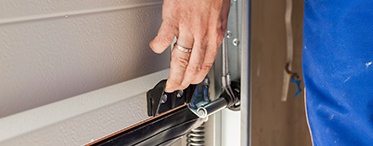
When a garage door spring breaks, it can trap your car inside the garage, meaning you could be stuck at home or even unable to get in your house. By upgrading to a high cycle garage door spring, you can double or even quadruple the lifetime of your garage door springs. A longer life span then helps you avoid extensive repairs and maintenance over time.
High cycle springs are particularly useful for anyone who uses their garage doors often, has had to replace springs often or is planning on staying in their current home for many years.
How Garage Door Professionals Can Help With Spring Repairs and Replacement
Torsion springs have a significant amount of force on them. Having the right tools to install and wind the spring is necessary. If you have not been properly trained, replacing or repairing garage door springs yourself could lead to severe and even deadly injuries.
Having the correct spring will also increase the garage door spring life cycle. Professional garage doors installers carry an assortment of springs on their trucks – this way they can put the correct spring on your door without the risk of shortening a spring’s life cycle. Spring issues can easily lead to the garage door suddenly crashing, which can cause significant injuries. Request professional service for spring repairs and replacements so the parts last long while you stay safe.
Contact Best Overhead Door for All of Your Garage Door Spring Needs
For over 30 years, Best Overhead Door has been providing the Portland Metro area, including Tualatin and Tigard, and Vancouver, Washington, areas with garage door repairs and replacement services. Whether you need your long life garage door springs repaired or replaced, our team of specialists looks forward to serving you.
Experience quality, choice and value at Best Overhead Door. Schedule service today.
Understanding Smart Garage Door Openers
When you need to leave your home in a rush, you might forget details like whether you closed the garage door. If you’re away from home, you may also want to know when the door was opened or closed. Smart garage door openers introduce innovative technology that solves these and other needs relating to your garage door.
What Is a Smart Garage Door Opener?
Smart garage door opener systems use your wireless internet connection and sensors on the garage door controller and rails to send data to an app. As for the role of smartphone apps in garage door operation, you can use your phone to see whether your door is open or shut and the last time it was used. Smart garage door openers also allow homeowners to control their garage door from their phones, no matter where they are. If you leave for the day and realize you left the garage open, you can close it from your workplace without driving back home.
The Advantages of Upgrading to a Smart Garage Door Opener
Smart garage door openers expand functionality. Here are a few reasons homeowners often upgrade to smart garage door systems:
- Convenience: You can open the garage door remotely, providing a space for deliveries or letting guests in, and close the door when you’re done. Another example of this convenience is Amazon Key. This service, when combined with a smart garage door opener, allows Amazon deliveries to be placed safely inside your garage, even when you’re not at home. This showcases how smart garage door openers can enhance your day-to-day convenience.
- Peace of mind: Your smart garage door opener lets you monitor your garage door from anywhere, so you always know it’s closed without returning to check.
- Security: See the incredible impact of garage door openers on home security when you enhance your monitoring capabilities with data about when the door was last used and set up alerts for when it opens or closes.
Selecting the Ideal Smart Garage Door Opener System
You have several options when you upgrade to a smart garage door opener. Here are a few factors to consider to narrow down your choice and get the ideal smart garage opener for your needs:
- Budget: Smart garage door openers come at various prices, so you should decide what you’re willing to spend and shop with that number in mind.
- Features: Different smart garage door openers have varying capabilities, so research available features before you commit to a certain model.
- Longevity: Depending on quality and technological capabilities, a smart opener may last a long time or have a shorter serviceable life.
- Installation: Consider whether you plan to install the system or use an expert — experts are generally a safer investment for more complex systems.
After considering these factors, decide whether you want a smart garage door opener as an add-on accessory to your existing system or an entirely new system. Then, you can begin looking at the top brands. A few popular choices include LiftMaster, Genie Aladdin Connect and iSmartGate.
Best Overhead Door’s Expertise in Smart Garage Solutions
We have served the Portland, Oregon, area with garage door installations for almost 30 years. Throughout our years in business, we have continuously developed our knowledge to suit new technologies and gained experience servicing these systems to meet your needs.
Make the Switch to Smart Technology
At Best Overhead Door, we can help you select the best garage door for your needs and provide a seamless installation and integration of garage door openers with smart home systems. Talk to us about the Lift Master Smart Opener, or contact our team online for more information about smart garage doors.
Elevate Your Curb Appeal With Our Garage Door Trends for 2024
Home design trends continually change, and 2024 is no exception. These shifts in taste impact every aspect of your house’s interior and exterior, including garage door styles. Explore the designs, colors and features on track to become this year’s popular options for transforming the look, feel and function of homes everywhere.
Introduction to 2024’s Garage Door Trends
Garage doors are a prominent feature of many houses, forming a substantial portion of their exterior. As a result, they’re key to your property’s overall visual appeal, security and access.
Best Overhead Door has over 30 years of experience helping Portland area builders and homeowners elevate beauty, safety and convenience. We’ll help you do the same with the industry’s most dependable garage doors and fully customized solutions.

Unveiling Top Garage Door Designs and Material Trends
The hottest design trends for 2024 include tailored approaches, a focus on environmental friendliness and contemporary materials.
Crafting a Unique Home With Custom Design
Every home and resident’s personality is unique. A customized garage door is perfect for expressing these differences with style. Today’s options allow for more configurations than ever, and the almost limitless combinations possible mean you can personalize your door to any taste.
Merging Style With Sustainability Through Eco-Friendly Door Options
Modern garage door designs go beyond looks and feature insulation to help minimize heating and cooling. Doing so results in less stress on climate control systems, lower resource consumption and a reduced carbon footprint. As a bonus, these doors also frequently save money on energy costs and HVAC service!
Exploring the Power of Glass and Insulated Garage Doors

Contemporary glass and aluminum garage doors like the Clopay® Avante® and Amarr® Vista effortlessly combine elegance with function, adding sophistication to modern home architecture. Insulated glass options mean boosted energy savings and sustainability, which is increasingly important in home improvement projects.
Popular Garage Door Color and Style Trends Defining 2024
The year’s likeliest color choices and style trends showcase a range of possibilities to inspire you.
Forecasting the Colors for Garage Doors in 2024
Two primary color movements are dominating homeowner preferences this year. Some choose timeless shades with neutral hues, from cool white to warm gray to soft black. Others use color to make a bold statement, opting for rich blues, vibrant reds or tropical greens that add unique flair.
Discovering What’s New in Emerging Design Trends
Today’s garage door options range from classic elegance to modern simplicity. Faux wood promises to be a popular choice, combining easy maintenance with the warmth of a natural wood look. Demand for contemporary-style doors remains strong this year.
Navigating 2024’s Garage Door Trend FAQs
Answers to our customers’ frequent questions about 2024 trends appear below.
What Other Door Design Trends Have You Identified?
Customized garage doors hold the top spot for 2024. Homeowners like you have many options to create unique curb appeal, from hardware design to window styles and colors to materials.
Beyond appearance, homeowners are seeking out other features in their garage door designs, including smart technology integration that simplifies access management. There is also an increased focus on more advanced security and safety to provide additional peace of mind.
What Are the Year’s Most Anticipated Trends?
We see 2024’s garage door trends evolving to meet overall homeowner values. Simple function is no longer enough — newer door designs blend aesthetics, sustainability, personalization, security and technology.
Enhance Your Portland Area Home With Best Overhead Door
Keeping up with the latest trends is ideal for creating superior curb appeal when considering a garage door upgrade or replacement. Best Overhead Door can help you install the perfect one with many different options to bring your vision to life. Simply browse our lineup of residential garage doors online, or experiment with our design tools for inspiration.
You can also contact us for design assistance or to request a quote on your personalized door.
What (Else) To Replace After a Garage Door Spring Breaks
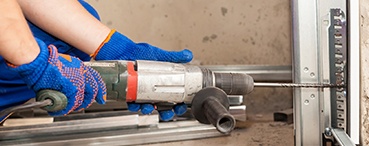
Most people do not realize that factory standard parts on a garage door have a life span of 10,000 cycles. This includes the springs, rollers, bearings, drums and cables. The spring is usually the first thing to go which gives you a sign that you had used your garage door at least 10,000 times. Some people just change a spring but this just causes more problems later on. It is best at this time to change the springs, rollers center bearing, bearing plates, spring shaft or tube and cables.
Why You Should Replace Your Remaining Garage Door Parts When Your Spring Breaks
When replacing a spring you should consider replacing the other parts that wear out as well, especially because Garage Door springs work together to ensure a smooth operation. Just because you can’t see the wear, doesn’t mean it is OK. It will cause further issues which will cost you more money from all the return trips and missed days of work. The life cycle of your garage door parts is about three years.
The question is, how often do you use your garage door? By the time a husband goes to work and comes home, a wife goes to work and comes home, kids go to school, take out the trash, go to soccer practice or go grocery shopping you can easily open and close your door 10 times a day which accounts to about 3650 times a year. If you’re one that uses your door about 10 times a day you might want to consider high cycle springs, nylon ball bearing rollers, new center bearings and end bearing plates and cables.
An example of this is a standard roller which will lift about 50 pounds and be good for about 10,000 cycles while an 11-ball bearing roller is good for 75 pounds at 15,000 cycles. The best roller, a 13-ball bearing 6200 Z sealed roller, is rated at 100 pounds and good for 100,000 cycles; the cost difference between the rollers is only a couple of dollars.
There are several types of drums to use- the standard one holds about 530 pounds. You do have options of drums that will hold 750 pounds and 1500 pounds. The grooves in the drums wear out from the cables and cause the cables two roll over themselves which in turn causes the cables to fray. This can cause major issues if the cable breaks and can be very dangerous.
Get Help From a Member of Our Team
The most common item on your door that breaks first is the spring, but it is a reminder to change everything else on your doors. Garage door springs are offered in a factory standard 10,000 cycles, 15,000 cycles 25,000 cycles or more. To get a high cycle spring, the wire size has to be bigger and the spring has to be longer in order to get the same IPPT, (Inch Pounds Per Turn). I know this sounds complicated, but trust me, you won’t be able to add or remove any turns on the spring. If you have any questions regarding spring size reach out to one of our technicians and they’ll be happy to help!
Here at Best Overhead Door, we are committed to fixing your door right the first time so you’re not left with any lasting issues. This is why we offer packages at discounted rates and routine maintenance services so you can come home from work every day knowing that your door will be quiet, reliable and work every time.
Tips for Keeping Your Garage Organized and Clean Year-Round

Despite most homes having a garage, many of these spaces don’t actually serve as useable spaces for storing vehicles. Instead of car parking, most homeowners find their garage is a mass of unorganized storage for old boxes, seasonal decor, home improvement tools and lawn and garden equipment. While cleaning out your garage may seem insurmountable, you can easily reorganize the space back into a garage in only a day or weekend.
To begin, sort through all of the items currently stored in your garage and begin placing them into three categories: keep, donate and throw out. Regardless of sentimentality, toss anything that the kids have outgrown or no longer play with along with broken items, expired chemicals and anything you haven’t used in the last two years.
Once you’ve donated and tossed the items you no longer use, you can begin organizing and cleaning.
Garage Organization
To begin finally organizing your garage, measure the dimensions of the space — including the size and location of windows, switches and doors — to help determine what type and size of storage you need. Also, take down the amount of space your car needs. To properly organize your garage, keep these garage organization tips in mind:
- Categorize similar items: For items you might use regularly that are similar, like yard tools and gardening chemicals, keep these close together.
- Use corners: The corners of your garage can become dead space, but they’re great for tucking large, bulky items like lawn mowers. In the corners, they can stay out of the way and avoid being knocked by the car.
- Frequently-used items: For items you use every day or very frequently, like recycling bins or bicycles, keep these near the door for easy access.
Tips for the Best Garage Storage Options
It’s beneficial to keep some garage organization ideas in mind. Once you’ve cleaned the space and determined which items are must-haves, decide on the best place to store everything:
- After categorizing similar garage storage items like yard tools, sports and recreational equipment, camping gear and seasonal decor, determine where each category should be stored. Think about how often you use those items and the space available.
- Use built-in cabinets and clear, modular storage instead of cabinets with doors. With open shelving and clear storage, you can quickly scan the items housed in each space. Plus, you’ll be discouraged from being disorganized by just hiding mess and clutter behind closed doors.
- For vertical storage, use a wall-mounted pegboard or wire grid, ideal for organizing tools, sports equipment and gardening tools.
- Don’t just let your overhead space go to waste. Instead, install overhead garage storage shelves that are mounted to the ceiling. This underused space on the ceiling is perfect for keeping infrequently-used items like camping equipment or seasonal outdoor decorations.
- Keep any items or storage containers off of the floor. This way, you can free up foot room and car space and avoid sloppy piles. If you purchase short shelves, make sure they’re on raised legs so you can easily keep the floor free.
After organizing your garage and properly storing all of your items, create a quarterly or biannual schedule to maintain your organization efforts. Also, after using items, make sure to quickly put them back in their storage location.
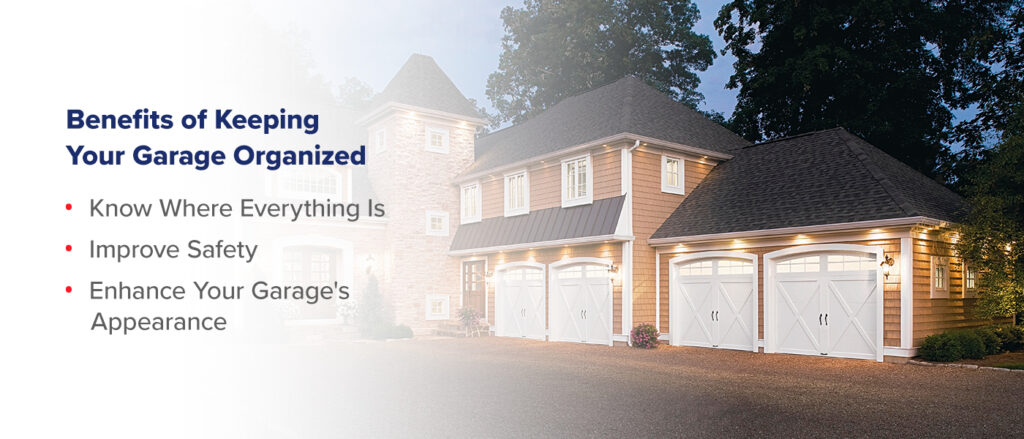
Benefits of Keeping Your Garage Organized
Even before you start your residential garage organization project, it can help to look at all the advantages so you can have some motivation going forward. You’re not just organizing your garage for the fun of it, after all — you’ll also be improving the safety of your garage, eliminating areas for pests to live and improving your garage’s overall appearance.
Know Where Everything Is
Organizing your garage will create an area that you’re familiar with. You’ll be able to find those old items you’ve been searching for and put them in a specific spot. Once you have everything in its rightful place, you can save a lot of time and energy that you otherwise would have spent searching for these hidden items.
Improve Safety
Garages can be home to tools like shears, saws and other sharp, potentially dangerous objects. By emphasizing garage door organization safety and moving those tools to one area, you can improve the safety of your home.
Enhance Your Garage’s Appearance
Once you’re done organizing, you can sit back and admire the clean, inviting atmosphere you’ve created in your garage. You’ll be proud of the job you did and will be happy to show it off to guests and neighbors.
Items to Avoid Storing In Your Garage
It’s easy for your garage to become a storage area for all kinds of different objects and materials. Try to resist the urge to throw anything in your garage — some of those objects could bring potential issues. Here are some items to avoid storing in your garage:
- Fridge: The large, roomy space of a garage might seem like the perfect spot for a fridge. Since the temperature is always changing in garages, however, you might be spending a lot of energy running that fridge to keep what’s inside cold.
- Paper and cardboard: Items made from paper or cardboard will easily break down in the climate of a garage. The remnants of these objects, aside from being a fire hazard, could also provide the perfect materials for rodents to start building a home.
- Food: Moisture is present in garages, making them poor places to store canned goods. Extreme temperatures will freeze and refreeze these products, forcing them to become inedible after a time. These wavering temperatures and humidity are also reasons why other goods like wine should not be stored in your garage.
- Hazardous chemicals: Be careful keeping hazardous materials in your garage. If they’re unneeded, it’s best to dispose of them promptly at your local hazmat disposal facility.
For All Your Garage Door Needs, Call Best Overhead Door Today
For nearly 30 years, Best Overhead Door, LLC has been helping residents of the Portland Metro area and Vancouver, WA, with all of their garage door sales, design and remodeling, repair and maintenance needs. We offer the finest and largest selection of Clopay® residential garage doors in the area and we welcome you to visit our storeroom to view our entire catalog. Schedule your garage door services today by filling out our online form or call (503) 620-1205 to speak to one of our specialists.
Related Posts
How to Paint & Maintain Your Custom Carriage House Garage Door
Home Improvement Projects With the Best ROI
How Do Garage Doors Improve Home Safety?
How to Tell if Your Garage Door Springs Are Broken
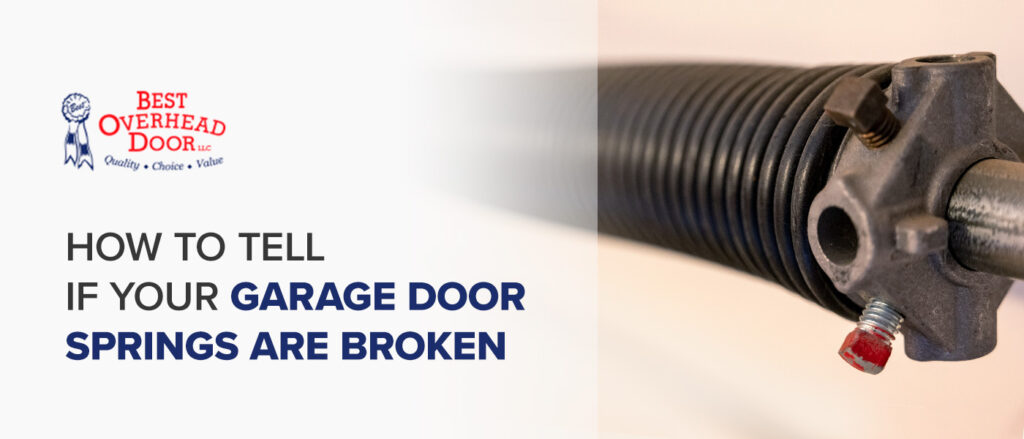
As you may be aware, one of the reasons your garage door may not be working correctly can be a broken garage door spring. However, you may be unsure of how to tell if a garage door spring is broken or know what to do if your garage door spring breaks. Here’s what you need to know about your garage door springs and what to do about them if they break.
Types of Garage Door Springs
Your garage door has one of three types of springs:
- Most residential garage doors have one or two torsion springs, which you will find above your garage door when it is closed.
- Some garage doors — usually those with limited overhead space — have two extension springs located at either side of the garage door along the rails that stretch when your door is closed.
- The third spring is a Torque Master exclusive only to Wayne Dalton garage doors and the spring is hidden inside a tube located above the door when it is closed.
All three types of springs have the same purpose — to work as a counterbalance to help lift a garage door that can weigh hundreds of pounds. When you close your garage door, your torsion springs wind up, generating powerful potential energy that they then use by unwinding to roll your garage door upon command. If these springs break, it will be very difficult or impossible to open your door.
Ways to Know if a Garage Door Spring Is Broken
The most obvious sign your garage door spring is broken is that it’s difficult or impossible to raise your garage door. Another is your garage door opener lifts your door about 3 inches and goes back down. However, if you still have one functioning garage door spring, your door may still work.
This is a very dangerous situation to be in because operating on one spring will put a lot of damaging stress on your door. More importantly, if someone pulls the emergency release while someone or something is under the door, it could drop suddenly, doing serious damage. If you have one spring on your door, the cables will not stay tensioned and look like they are broken.
For this reason, it pays to know if you are dealing with a broken torsion spring. One sign can be a loud pop coming from your garage with no other noticeable source. Another sign can be that one of your garage door cables has come loose, even if it does not appear to be damaged. The combination of both of these signs — or either of these signs with a door that is behaving erratically in some way — is a strong indication that you have broken a garage door spring.
How to Prevent Broken Garage Door Springs
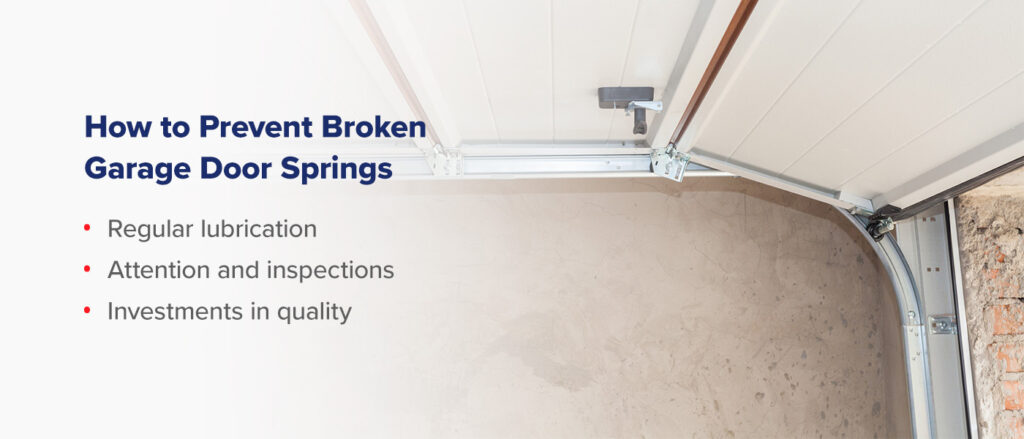
Although every piece in your garage will experience wear and tear, there are ways to prevent your springs from breaking and extend their life expectancy. The more attention you give your door, the fewer problems you’ll encounter with it.
You can help prevent broken garage door springs with:
- Regular lubrication: Rusted springs will quickly stop working. You should plan to lubricate your springs at least twice a year. If you live in a humid area, you may need to lubricate your door’s metal parts more often.
- Attention and inspections: Keeping a close eye on your springs can help you spot an issue early on. Pay attention to how your door opens and closes. If its movements are jerky or it seems to be straining, you should look at your springs. Additionally, you can start to open the door and stop it about halfway up. If the door continues to move, your springs probably need maintenance.
- Investments in quality: Always remember that you get what you pay for. It’s essential to look for repairs, parts and services from a trustworthy business. Choose pieces designed to last and opt for springs with longer life expectancies.
Typical Lifespan of Garage Door Springs
You can determine how much life your springs have left by the number of cycles they perform. Garage door springs typically last between 10,000 and 20,000 cycles.
On average, most springs last between 3 and 5 years. However, if you only use your garage twice a day — when you’re leaving and coming home — your springs will probably last longer. If you have multiple cars in your garage coming and going throughout the day, you may need to replace your springs sooner.
What to Do if You Suspect You Have Snapped a Garage Door Spring
If you think one of your garage door springs is broken, you should replace it as soon as possible. As mentioned above, operating on one spring can be extremely dangerous. You should hire a professional to replace the spring, as you are working with a part that is responsible for holding potentially hundreds of pounds in place, and this could present a safety issue to the untrained. Installing the wrong spring can also be very dangerous. Most important of all, DO NOT OPERATE YOUR GARAGE DOOR WITH A BROKEN SPRING.
If you’re located in the Portland, Oregon, metro area or in or around Vancouver, WA, our experts at Best Overhead Door will be happy to come by and replace broken springs. Just give us a call at (503) 620-1205 or contact us online to request service today.
Related Posts
How To Tell If Your Garage Door Hinges Wear Out
How Do Garage Doors Improve Home Safety?
Do Garage Doors Need to Be Inspected?
Benefits of Sealing Garage Doors
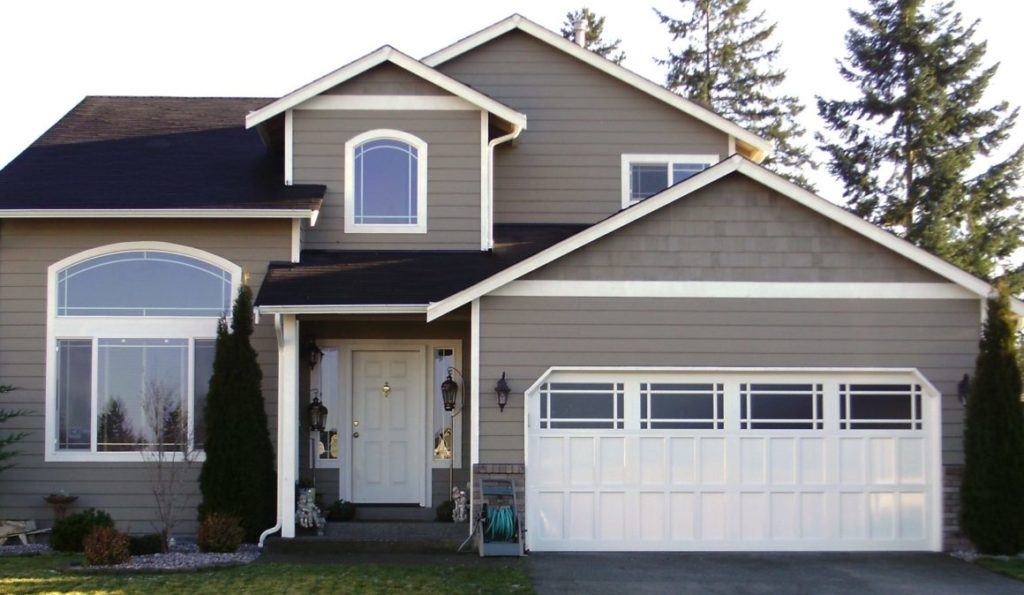
Your garage doors are your home’s largest access point, so if your garage doors have a faulty seal, your house risks exposure to the elements and unwelcome pests like insects and rodents. If you’re looking to save energy, reduce your heating or cooling costs, protect your garage from water damage and keep pests away, sealing your garage door can do all of the above. While all garage doors come with a weather seal, they wear out over time and need replacement. Weatherstripping your garage door provides you with peace of mind by ensuring nothing can get into your home.
What Is Garage Door Weatherstripping?
Weatherstripping seals air leaks around moving components of buildings, like windows, doors and garage doors. The seal improves energy efficiency and protects your home from invading pests and the elements, and these are only some of the benefits of weatherstripping on garage doors. According to the U.S. Department of Energy, when you weatherize your home by sealing doors and windows, you can save an average of $283 in annual energy costs. Garage doors with faulty weatherstripping pose a significant energy drain on your home through increased heating and cooling needs.
Garage doors come with weatherstripping on the bottom that should create an airtight seal against your garage floor. The seal helps keep your garage cool in the summer and warm in the winter, while preventing water and pests from entering your home.
As with most things, the seals on garage doors are susceptible to wear and tear with regular use. As the weatherstripping becomes worn, the seal is no longer sufficient, and you may notice water entering your garage when it hadn’t previously. A water leak is a sure sign that you need to replace your weatherstripping. If you don’t re-seal your garage door, the stripping will continue to wear away and will become even less protective over time. Bugs like ants or cockroaches and even larger pests like mice or rats can squeeze through poorly sealed garage doors and make themselves comfortable in your house, so it’s vital to ensure your weatherstripping is still doing its job.
Sealing Garage Door Benefits
The benefits of garage door weather seals are numerous and extend from lowering your energy costs to protecting your home from damage.
1. Offers Protection From Water and Flooding
Water damage often happens before you can react to it. Even average rainstorms can cause damage if your garage doors don’t have a proper seal. Water leaks underneath garage doors and can quickly spread over the ground, damaging anything you have on the garage floor. Then, once the water starts to evaporate, the condensation will struggle to escape and can damage any electronics or vehicles you have stored in the garage. The condensation can also gather around windows in your garage and may encourage mold growth over time. Mold can spread throughout your home and often requires extensive renovations to eliminate the health risks it poses.
Sealing your garage doors with weatherstripping will protect your home and possessions by creating a sturdy seal that will keep the rain outside, even if you’re facing heavy storms. Garage door weatherstripping is vital to keep your home safe from water damage.
2. Decreases Energy Bills and Increases Insulation
Cold air in the winter or hot air in the summer can enter through any cracks in your garage door sealing. These drafts cause your cooling and heating systems to work harder, which increases the associated costs. As time goes on, you may have to spend extra money on maintenance because your air conditioning unit cycles on and off more frequently than it should. Drafts can also make your garage uncomfortable to be in by creating temperature differences from the rest of your home.
By installing weatherstripping on your garage doors, you will only need to heat or cool your garage when it’s necessary. Drafts from outside will no longer penetrate your garage because a strong seal will be airproof. You should notice a decrease in your energy bills after sealing your garage doors.
3. Keeps Insects and Rodents Out
If you start to notice vermin such as insects or rodents in your house, your garage door sealing may be to blame. These pests can squeeze through any small imperfection in your garage door’s seal and infiltrate your home. Your garage door is your main line of defense against these creatures because once they’re in your garage, it’s easy for them to enter the rest of your home. Insects and rodents are prolific breeders, so what starts as a small problem can quickly lead to something much more devastating. Vermin can carry fleas and diseases into your home, damage your possessions and get in your food.
By sealing your garage door, you ensure that no pests will have access to your home.
4. Decreases Damage to Your Garage Door
When your garage door has reliable weatherstripping, it will require less frequent repairs than if the sealing was no longer sufficient. The weatherstripping protects your garage door from the pests and elements that most often damage garage doors’ structure and mechanisms. Water and vermin, in particular, can cause damage to your door that requires immediate repair. The weatherstripping also protects your garage door if it slams shut by offering a padded cushion. You prolong your garage door’s lifespan by sealing it.
Do You Need a Professional to Seal Your Garage Door?
You must seal garage doors with precise measurements and high-quality materials. If the measurements are off by even a fraction of an inch, your garage is still at risk of water damage, drafts and vermin. The materials used to seal garage doors should be of premium quality to withstand the constant friction and movement that garage doors experience.
We recommend having professionals complete this task for you. They can assess your garage door and create a comprehensive plan to seal it with the best materials for your specific garage. You may also need repairs to the garage foundation if there are any cracks in the concrete. If you apply weatherstripping, but don’t fix the foundation, your garage doors will not form a full seal. Professionals are experienced at handling garage sealing and will ensure your home has adequate protection.
How Long Does Weatherstripping Last?
V-shaped neoprene rubber strips attached to both sides of the garage door often seal the doors’ tops and sides. These strips do a great job keeping out dirt, vermin and water, but the rubber can dry up and begin to crack or warp over time.
Similarly, U-shaped rubber or vinyl tracks attach to the bottom of garage doors to create a seal at the garage’s foundation. The rubber will begin to warp and crack as it ages, which weakens the seal and exposes your garage to nature.
How long your garage door weatherstripping lasts depends on your location, climate and weather conditions. Your sealing may wear out sooner if your garage door often experiences extreme temperature fluctuations and frequent weather events.
You can expect your weatherstripping to last an average of two years with normal wear and tear.
Here are some warning signs to look for when deciding if it’s time to replace the sealing.
- Visible distortions in the stripping, such as cracks or color changes.
- The seal is no longer bouncing back into place and leaves a gap between the garage door and the floor.
- Water begins to enter your garage near the door.
- Pieces of the weatherstripping are breaking off when you touch it.
Contact Best Overhead Door to Seal Your Garage Doors
Why seal your garage door? Garage door weatherstripping protects your home and your possessions from water, wind and pest damage, so it’s vital to ensure that your sealing is doing its job. Daily wear and tear will have an impact on your garage door sealing and increase your utility bills. At Best Overhead Door, we can apply new weatherstripping to your garage door to create a durable seal, so the door can fend off anything that tries to enter your garage while lowering your energy usage. We service the following areas:
- Beaverton, Oregon
- Lake Oswego, Oregon
- Portland, Oregon
- Sherwood, Oregon
- Tigard, Oregon
- Tualatin, Oregon
- Wilsonville, Oregon
- Vancouver, Washington
If you notice your stripping is no longer working as effectively as it once was, please reach out today to schedule service. You can also request a free estimate online.
 How to Maintain a Wooden Garage Door
How to Maintain a Wooden Garage Door
Your wooden garage door adds warmth and style to your home’s facade. It accentuates your home’s originality and charm, elevating any architectural choices. If you want your garage door to look and function like it’s brand-new, you’ll need to keep up with regular maintenance. Some tasks you can take a few moments to do on your own — others may require professional service. Either way, simple preventive maintenance can save you a great deal of time and money in the long-run. Learn how to properly maintain your wooden garage door.
Why Should You Maintain Your Wooden Garage Door?
Maintaining your wooden garage door has both visual and practical benefits. It can improve the appearance and function of your door. When you keep up with regular maintenance, you’ll likely notice the following results:
- Keeps its nice appearance: Proper maintenance will keep your door beautiful, preserving its original look. Remember that your garage door makes up a large portion of your home’s facade. A clean, well-kept door will boost your home’s curb appeal and resale value.
- Increases the lifespan: Your door will have a longer lifespan with regular care and maintenance. You’ll be able to postpone repair and replacement much longer. Simple preventive care will save you time, energy and money in the long-run.
- Improves overall performance: Maintenance also ensures your door can operate as it should. When you take appropriate measures, your door will be able to withstand heavy use and exposure to the elements.
Difference Between Steel and Wooden Garage Door Maintenance
Steel and wooden garage doors require different maintenance. Both materials are sturdy and robust, but each has unique qualities. For instance, steel is prone to dents and corrosion, while wood is prone to cracking or warping under harsh weather conditions. To maintain your wooden garage door, you’ll need to sand and stain once every couple of years. You might also choose to reapply paint to perk up the appearance. In addition, you’ll need to replace any damaged parts, including panels or hardware.
How to Maintain Wooden Garage Doors
Keeping a wooden garage door like-new in appearance and function requires some maintenance. Follow all of these steps to keep your door in top shape. Some steps you can tackle yourself, while others are best left to the professionals. Before making any major alterations, like repainting or refinishing, contact your Authorized Dealer to ensure your warranty will stay valid. Here are some things you can do to maintain your wooden garage door.
1. Sand and Smooth the Wood
First, make sure to remove any peeling or chipping wood. Clear away any splintered wood pieces and paint chips. Use a paint scraper to remove loose or peeling paint. Rub sandpaper on the exposed surface. As you sand, try to apply even pressure. Otherwise, you may end up with gauges or dips, producing an uneven surface.
A smooth base will ensure an even coat of finish or paint. Resand the door at least once every few years or after an especially harsh season. Extreme heat, cold or humidity can degrade wood’s quality, which makes sanding necessary.
2. Keep the Door Clean
Built-up moisture, dust or dirt can cause warping or bending. Cleaning your door will make it look nicer, reduce damage risks and decrease how often you need to re-stain. A quick wipe-down is all it takes. When you clean the door, use regular dish soap and warm water, along with a cloth or soft sponge. Wipe down all components to remove dirt, dust and grime. If you notice mildew, use a special mildew-removing solution. You may want to wear gloves and a mask for your health and safety.
When you clean, avoid abrasive scrubbers, which may remove the wood’s finish. You should also refrain from power washing, though using a regular garden hose is usually fine. Use this method to clean your garage door at least once a year or so. If you live in a harsher climate, you might want to clean your door more often.
3. Add a Coat of Finish or Paint
You’ll want to reapply a durable, weather-resistant stain every few years. This refreshes your door’s appearance and helps protect it from the elements. A garage door faces exposure to every outdoor element — wind, rain, humidity, beating sun, snow, ice, as well as extreme hot and cold. It needs proper protection to withstand those conditions. Consult with the manufacturer to make sure you’re using a safe stain for your door’s wood. To refinish your door, follow these simple steps:
- Clean the door with soap and water to clear away any grime or debris.
- Let the door dry — you might need to give the door a day or two to dry off.
- Use a brush or roller to apply the stain onto the wooden surface.
- Let the stain coat dry.
- Go over the wood with a dry brush. This will remove any excess stain.
If you want to renew the look of your garage door, you may choose to repaint. You can choose a color that better suits your taste or fits modern trends. Like a coat of finish, a new coat of paint will offer added protection to the wood surface. If you lack the time or materials to repaint your door, you might consider hiring a professional service. To repaint your garage door, be sure to clean and sand the surface first. Use masking tape to cover any non-wood elements, and let the door dry between coats.
4. Lubricate Metal Elements
It’s important to apply a lubricant to all metal parts and hardware elements. This allows for smoother operation. If you notice any unusual noises or sticking as your garage door opens and closes, the metal elements may need lubrication. These effects can be annoying, but they also signify serious issues. Ignoring strange sounds or uneven movement can shorten your door’s lifespan.
Applying lubricant when needed allows for convenient, quiet operation and lengthens your door’s lifespan. The harsher an environment you live in, the more often you should take this precaution. You may want to ask the manufacturer what type of lubricant to use. Avoid thick grease, which can clog the tracks and result in built-up dirt. When you’ve chosen the right lubricant and you’re ready to apply it, follow these steps:
- Make sure all nuts and bolts are tightened. Replace any worn or broken metal components.
- Check your rollers to ensure they’re sturdy and aligned, not wobbly.
- Wipe the track clean using a damp rag.
- With the door open, lubricate the hinges, rollers and ball bearings.
- Lubricate the metal springs and plates, as well as the top of the rail.
- Avoid any nylon or plastic elements and wipe away excess lubricant as you go.
While many homeowners apply lubricant as a do-it-yourself task, you may opt to hire a professional service. This will ensure the use of the proper lubricant and minimize any risks. A professional tune-up will include reapplication of lubricant.
5. Inspect for Signs of Pests
A wooden garage door can be a target for wood-consuming pests. Termites, snails, slugs and beetles can wreak havoc on your door. Check for tunnels and holes in your garage door’s surface. If you notice signs of pests, you might use an insect repellent spray or poison trap. Be sure to keep these chemicals away from children and pets. You may need a garage door repair service to fix pest damage. It’s best to catch these issues as soon as possible before large sections of your door become compromised.
6. Inspect Working Parts
Check all of your door’s working elements, including hardware, sensors, openers and tracks. Open and close your door, watching for any snags and listening for unusual sounds. Whether or not you notice anything out of the ordinary, it’s a good idea to hire a professional service to examine the technical elements of your door. A preventive tune-up can save you from expensive repairs later down the road. A professional service will:
- Examine elements to ensure proper function.
- Re-tension springs.
- Tighten nuts and lags.
- Re-align the track if needed.
- Lubricate moving elements.
- Perform a safety inspection to make sure the door’s sensors are working.
Does Your Wooden Garage Door Need Repairs or Replacement?
While some conditions require nothing more than a little elbow-grease, others may necessitate professional repair or replacement. If you notice any of the following conditions, contact an expert garage door repair or replacement service:
- Warping
- Extreme cracking
- Aging materials
- Operational issues
In any of these cases, a professional may replace single elements or the entire door. Sometimes, you can resolve an issue by replacing just one panel or technical part. If the damage is too severe, however, you may need to replace the entire door.
Protect Your Wooden Garage Door With Proper Maintenance
Your wooden garage door adds to your home’s beauty and value. You want to keep it looking good and operating well for as long as possible. With regular maintenance, you can preserve the appearance of your door and extend its lifespan. Simple maintenance tasks yield long-term results. For all your garage door service needs, contact Best Overhead Door today.
How to Clean Your Garage Door
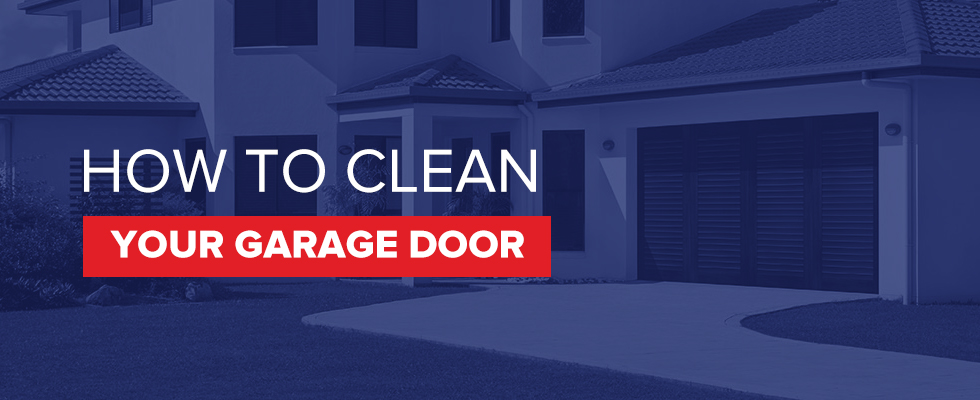
Your garage door is one of the most important and practical features of your home. Cleaning your garage door is a way to invest in that crucial amenity. The experts at Best Garage Door have created this guide to help you learn more about the importance of cleaning garage doors. Read on to discover how to properly clean your garage door.
Why Should You Clean Your Garage Door?
Here are a few of the reasons you should clean your garage door:
- Extend your garage door’s life span: Your garage door takes a beating throughout the year. Rain, snow, dirt and salt can do a number on your garage door, wearing it out prematurely. Clean your garage door to remove these harmful substances and keep your garage door working for years to come.
- Keep it looking great: When you pull up to your home, you want your garage door to enhance the beauty of your facade. Cleaning your garage door enhances your home’s curb appeal. This is important if you’re selling your home or thinking of selling it soon. Protect your garage door’s finish and prevent rust by cleaning your garage door. You can impress potential buyers and increase your satisfaction with your home’s visual appeal with a beautiful-looking garage door.
- Discover other issues: Cleaning your garage door provides a great opportunity to inspect it. After you clean all the dirt and grime from its surface, you’ll have a better view of the hardware, finish and other components. You may discover some areas that need attention. Use this time to inspect the rest of your garage door, including the rollers, roller tracks, cables and springs.
- Protect it from future damage: When it comes to garage doors, issues add up and can lead to costly repairs. A dirty garage door can contribute to other garage door issues down the road, so clean it to reduce your chances of more problems.
How Often Should You Clean Your Garage Door?
We recommend giving your garage door a routine cleaning session every spring and fall. Cleaning in the fall prepares your garage door for the impending harsh weather. Giving it some spring cleaning removes the built-up grime it accumulates over the winter. You could take it a step further and clean your garage door seasonally. We know life is busy, so try your best to clean your garage door at least every fall and spring.
You can take part in different garage door cleaning methods at different times of the year. Several tasks come together to give your garage door a complete cleaning over the course of the year. You may prefer giving your garage door a standard cleaning once or twice per year and save projects like repainting and re-staining for every other year. Find a regimen that works for you and your schedule. Over time, you’ll fall into a rhythm that will keep your garage door in great shape.
How to Properly Clean Your Garage Door
It’s essential that you clean your garage door the right way. Here’s how to properly clean your garage door:
- Use non-abrasive sponges: Think of your garage door like your car. You wouldn’t use a rough sponge or cloth on your car. Treat your garage door the same way. A non-abrasive sponge or cloth will protect your garage door’s finish while removing dirt and grime. With a soft cleaner, you can use extra force without worrying about damaging the finish.
- Mix the right cleaning solution: Use a solution of warm water and mild detergent to clean your garage door. This solution will be strong enough to remove grease and dirt, but it’s also gentle enough to preserve your garage door’s finish. Using this gentle cleaning solution with non-abrasive sponges is a great starting point for cleaning your garage door.
- Rinse with a gentle hose: After scrubbing your garage door with a non-abrasive sponge and mild cleaning solution, you’ll need to rinse it off. Connect your garden hose to a nearby spout and use the water to rinse off all the suds and dirt. No need to use any attachments, as the pressure from the hose should be enough to get the job done.
- Dry with a clean and soft cloth or towel: Make sure you dry your garage door after rinsing it off. If you’re researching how to clean a metal garage door, remember that water contributes to rust in metal garage doors. Wooden garage doors can absorb water, which can lead to bulging and warping. Drying your garage door with a clean and soft cloth is key toward keeping it clean and protecting it from other issues.
- Clean the inside and outside: Cleaning the outside of your garage door is obvious, but remember to clean the inside, too. Some of the dirt and grime from your garage floor can make its way to the lower section of the inside of your garage door. While you’re cleaning the outside of your garage door, remember to give the inside some attention.
What to Avoid When Cleaning Your Garage Door
To ensure your cleaning remains successful, take a look at the following garage door cleaning practices to avoid:
- Pressure washing: The force exerted by pressure washers is too much for your garage door’s finish. It could remove the paint or stain from your door, which does more harm than good. Remember that with garage doors, gentler is better.
- Abrasive sponges and cloths: Cleaning your garage door is all about protecting the finish. Abrasive sponges and cloths run the risk of scratching the finish. This can result in ugly scratches and scuffs on your garage door instead of the beautiful final product you’re seeking.
- Detergent and bleach solutions: Bleach is great when removing stains from white laundry. It is also an effective cleaning agent for some of life’s toughest messes. But when cleaning your garage door, bleach has the opposite effect. It can discolor your stain and even do permanent damage to wood. You’re better off sticking with the mild detergent and water mixture.
- Air drying: Water can contribute to rust on metal garage doors and warping in wooden garage doors. Make sure you have a soft drying cloth nearby to remove the water from your garage door after cleaning and rinsing.
Maintain Your Garage Door With the Help of Best Overhead Door
Cleaning your garage door is essential to improving its life span and its appearance. As you clean your garage door, you might realize it’s in need of some repairs. If you’re in the Portland or Vancouver area and need garage door maintenance services, Best Overhead Door is the company for you.
We’ve been in business for over 30 years, so we are experts when it comes to keeping your garage door in great shape. We even offer brand new residential garage doors if you think it’s time to invest in a new door that will last you for years to come. Contact us today to schedule a garage door service visit or learn more about our other services.
Tips for Maintaining Your Garage Door’s Warranty
Your home’s garage door is most likely the primary entry to your home, the first line of home security and an improvement to your daily functions and energy efficiency. Having a garage door warranty is essential and can protect homeowners from installation defects that could later cause property damage or personal injury.
Clopay® offers a one-year installation warranty, covering garage door replacement from one of their Authorized Dealers or Master Authorized Dealers. With an Authorized Dealer, Clopay is guaranteeing work completed by skilled, knowledgeable, honest and capable technicians. This warranty begins the day the installation was completed and is not applicable to new construction.
Having a garage door warranty is great assurance for homeowners to know they always have dependable repair or replacement services for the first year. However, voiding your warranty could mean paying out of pocket for replacement expenses that would normally be covered.
So the question is, how can you maintain your garage door warranty? Here are some good places to start:
- Your Clopay warranty will not cover damage related to or resulting from alterations or attachments to the automatic opener or photo eye sensor. They also won’t cover damage resulting from improper garage door use, like operations beyond the rated capacity or other abuses by anyone other than the Authorized Dealer.
- The warranty will be void if you decide to have your garage door installed by anyone but an Authorized Clopay Dealer.
- Your warranty will also be void if the installation is performed without using the supplied installation hardware or failure to properly install the opener reinforcement.
If you’re ever unsure about what is covered under your warranty or want additional information, reach out to your Authorized Clopay Dealers at Best Overhead Door, LLC. Also, to ensure you’re guaranteed warranty coverage, don’t forget to register your door through Clopay.
Additional Clopay Garage Door Warranties
With Clopay garage doors, you not only have the benefit of having a defective door replaced within one year of installation but with normal operation and good care and maintenance, Clopay also offers warranties for:
- Paint
- Hardware
- Springs
- Sections and Delaminations
- Windows
Depending on the style and design you choose, these warranties can range anywhere from three years to a lifetime. To guarantee you always receive guarantees, consult your Authorized Dealer anytime you wish to make any alterations to ensure it won’t violate the warranty. Then, have your technician perform annual maintenance to keep all parts and hardware in good working condition.
Have Questions? Contact Best Overhead Door Today
Maintaining your garage door’s warranty can be tricky, but with proper installation and care, you can be assured of coverage for the lifetime of your garage door. If you’re considering installing a new garage door, we offer a wide selection of durable and custom Clopay doors, all backed by their one-year installation warranty. Our reliable services are available for all residents throughout the Portland, OR, and Vancouver, WA, areas.
Reach out to us today to learn more about our offerings and warranties by completing our online contact form or calling our office at (503) 620-1205.
Advantages and Disadvantages of Smart Garage Door Openers
One of the most popular recent advances in garage door technology is the smart garage door controller. This is a feature for your automatic garage door that gives you much more control over the way your garage door opens and closes. If you’ve heard of a smart home, a smart garage door opener is another addition to the smart home system. With the developments of smart home devices such as smart thermostats, video cameras, security systems, voice assistants, etc., smart garage doors are the next step you can take in automating your home through your wifi-network.
What Is a Smart Garage Door Controller?
A smart garage door controller is a Wi-Fi-enabled garage door opener that allows you to control your garage door using a digital device like your phone or tablet after downloading the related app.
You may be wondering, why get a smart garage door opener if you already have a remote garage door opener that works fine? What can a Wi-Fi garage door controller do that my current remote doesn’t? Here are a few smart garage door opener benefits to consider.
What Are the Benefits of Smart Garage Door Openers?
Convenience is the most obvious benefit of having a smart garage door opener. Once your opener is enabled, you never have to worry about losing your garage door remote or having it run out of batteries at an inopportune moment. You will always be able to open your garage door as long as you have a Wi-Fi connection and your digital device.
An even greater benefit is home security. You can set the door to open just before you get home, so there’s no time spent waiting outside for the garage door to open. As soon as you get home you can drive right in. You will also always know when your garage door is opened, even if you aren’t home, thanks to an automatic alert on your device. Some smart garage door openers even have the added capability of connecting to your home security systems.
You can open and close your door remotely from anywhere, as long as you have power at home, so if you arrive at work or are headed out on vacation and suddenly realize you left the garage door open, you don’t have to return to close it. You can also use this feature to allow people access to your garage or home without giving them a key or passcode.
What Are the Disadvantages of a Smart Garage Door Controller?
There are not many disadvantages to having a smart garage door opener. There is the time and expense it takes to have it installed, but these are minimal compared to the benefits such a device can bring.
You also should not toss away your regular garage door remote entirely, as most smart garage door opener technology is designed with the idea that your primary method of opening and closing the garage door will still be the remote opener — unless you have it set on an automatic opening and closing schedule.
A common worry among homeowners is that if the garage door is wifi-enabled, will it still open without power? The answer is yes! Much like remote-operated garage door openers, these openers will have battery backups and other fail safes so you can still operate your garage door in case of a power outage emergency.
If you can tolerate these issues, you may want to take advantage of smart garage door opener technology for your home.
What Are the Best Smart Garage Door Openers?
If you’re sold on smart garage door openers, you may now be wondering which one to get. You actually have quite a few choices. As the popularity of this technology increases, the number of available systems is only growing. Here’s a brief smart garage door opener buying guide to some of the most popular opener systems to help you figure it all out.
MyQ Garage Door Opener (LiftMaster®, Chamberlain®)
When you install a new LiftMaster® or Chamberlain garage door opener system, you will definitely want to get it with MyQ, which is a leader in smart garage technology.
MyQ openers have all the features mentioned above, allowing you to set a daily schedule for when your garage door opens and closes, receive security alerts and open or close the door from anywhere you have a wireless connection. Another useful feature is that MyQ can be integrated with Amazon Key, which allows Amazon to deliver packages directly into your garage for your convenience. MyQ also has compatibility with platforms to provide connectivity between popular smart home platforms such as ring, another Amazon product.
Nexx Garage
People enjoy the Nexx Garage system for its simplicity. It plugs into a regular outlet and uses a wireless and a wired sensor to register when the door is open or closed.
It has all the standard smart garage features, like open/close notification, door open alerts and auto-open scheduling and is also compatible with Alexa and Google Assistant, which means your garage door can be voice-activated and serve as an integrated part of your smart home system. Pairing Nexx Garage with your home assistant is easy and happens basically automatically.
The most modern versions of Nexx Garage also feature geofencing, which is a feature you can enable that opens your door automatically when your smartphone enters the vicinity.
Genie Aladdin Connect
Another popular smart garage door opener is the Aladdin Connect, from Genie. This one works with a Bluetooth center statically attached to the door, so you don’t have to worry about the connection dropping. Like the Nexx Garage, the Aladdin Connect is also compatible with Alexa and Google Assistant.
Bonus features on the Genie Aladdin Connect include the ability to control up to three garage doors with the same system and an automatic setting called trigger that automatically closes the door if it has been left open for more than a set amount of time.
Although many garage door opener companies have their own smart garage door systems, you do not necessarily need to have a company’s garage door opener to use their smart garage door controller. Some smart garage door systems come with a new garage door opener installation, while others you can buy separately and install yourself.
Contact Best Overhead Door to Learn More
If your garage is located in Tualatin, Tigard, or anywhere in the Portland Metro area, Best Overhead Door is here to help you sort it all out. We can show you a range of new garage door openers with smart technology or help you select and install the smart garage door controller of your choice.
For more information about smart garage door technology and what it can do for you, read our recent posts or contact Best Overhead Door today. Reach out to us online or call us now at 503-620-1205.
How to Prepare Your Garage Door for the Winter
A good garage door should last you year after year, even through the change of seasons and multiple daily cycles (opening and closing). But there are threats to your garage door in winter that you may need to address.
Getting your garage door stuck is always bad, but when your garage door is stuck in winter, it can create all sorts of problems. Leaving a garage door open in winter allows warm air to escape your home, driving up energy costs and allowing anything in your garage, like your car, to be fully subjected to the elements.
To help you with your garage door winter maintenance, here’s what you need to know about why you should winterize your garage door and how to prepare a garage door for the winter.
How Does Cold Weather Affect Your Garage Door?
Why is winter such a problem for garage doors? There are several reasons. For one, cold weather can simply put stress on a garage door. Your garage door is made of a lot of moving parts that must work in tandem to lift a door that may weigh hundreds of pounds. If the lubrication dries out or the door becomes denser due to the cold, that’s more work for springs, rollers and other components.
Heat transfer is also a problem. If your door is not properly insulated, warm air can escape your home through the garage door. This means it is much harder to heat your home, and the energy costs can really add up during the winter.
Then there’s snow. Not only can snow collect on a door and make it harder to open, but snow means moisture, which can get into the various parts of your garage door mechanism, freeze and cause them to stick. Moisture can even damage the sensitive electronics in your keypad or garage door opener.
Why You Should Prepare Your Garage Door for Winter
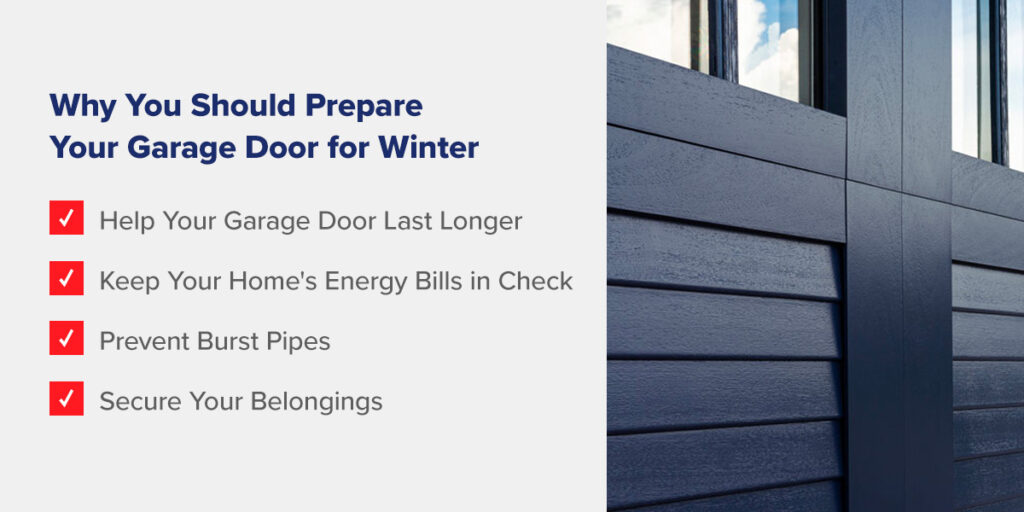
Winter brings cold, wet weather with it. Preparing your garage door before winter gets underway helps keep that cold, wet air out of your home. Think of winterizing your garage door as part of your routine maintenance tasks. A bit of effort today will pay off in the long run.
Help Your Garage Door Last Longer
You use your garage door daily, often multiple times a day. The more attention you give it, the longer it will last, which can help you save money in the long run. Instead of rushing out to buy and install a new garage door, you can enjoy the one you have had for years, then decide to replace it when the time is right.
Keep Your Home’s Energy Bills in Check
If your garage is attached to your home, ensure the door is ready for winter. A bit of winter prep can keep the cold air from entering your garage and seeping into your home. Your heating system won’t need to work so hard, so your energy bills won’t skyrocket. When your garage stays relatively warm, the warmth can transfer into your home through the shared wall.
Prevent Burst Pipes
Your home may have piping that runs through the garage. If the door can’t close and the garage becomes very cold, the water in those pipes can freeze, causing the pipes to break or burst. You may end up with a mess on your hands and a hefty plumbing bill. Winterizing the garage can prevent the pipes from freezing.
Secure Your Belongings
The garage is often an extra storage space full of your possessions. Winterizing the door makes you feel confident that your belongings are stashed away safe and sound, under lock and key.
Tips to Prevent Garage Door Damage in Winter
You can see how important it is to maintain and protect your garage door in the winter. Here are some garage door cold-weather maintenance tips to consider. Ideally, you should take these steps at the end of fall, just as winter is approaching, but if you haven’t done these things yet, you should go ahead and do them even if winter has already arrived.
1. Check the Weather Stripping
If you are trying to prevent snow, moisture and cold from getting into your garage, quality, intact weather stripping is critical. Even a small crack or gap in your weather stripping can render it basically useless. Take the time to examine the frame and bottom of your garage door and make sure the weather stripping is completely intact. If there are any cracks, gaps or loose pieces, call for repair immediately.
2. Lubricate All Moving Parts
Get some approved garage door oil and lubricate the springs, rollers, tracks and any other moving parts that require it. New lubricant is less likely to show cold weather effects like drying or freezing.
3. Get Rid of the Snow
If there’s ever any snow on or around your door, get rid of it immediately before it melts or freezes. Have a snowblower, shovel or other snow removal tools handy so you can quickly remove snow as soon as it appears.
4. Check Your Photo Eye Sensors
This is related to tip number three. One way that snow can affect your garage door is by covering up the sensors that tell your door if someone is underneath it.
This is an important safety feature, but if enough snow builds up on one or both of these sensors, they cannot make the connection that tells your door it is okay to operate. If your door is not coming down or appears to be going back up intermittently, make sure snow or other debris on the sensors is not the culprit.
5. Test the Door’s Balance
An unbalanced overhead door can strain the garage door opener, keeping it from operating as it should or causing unnecessary wear. You can test your garage door’s balance by disconnecting it from the opener, then opening and closing it by hand. Close the door halfway, then let go. It should stay in place. If it rolls closed or flies open, it’s unbalanced.
If your garage door is unbalanced, one of the springs might be loose or broken. Leave the repair job to a professional, as adjusting the springs on your own can be dangerous.
6. Seal Any Holes and Cracks
Cold air can seep into your garage through cracks in the door, windows or walls. Walk around your garage and inspect the walls and doors for visible cracks or holes. If you see any, fill them with caulk. You can also use steel wool to plug up larger holes. Sealing the cracks and holes will help to keep pests and rodents from making your garage their home for the winter.
Making Sure Your Garage Door is Winterized
While you can take steps right now to get your door ready for cold weather, there are also some long-term measures you can take so you don’t have to worry as much about your door every year when winter rolls around.
One of these steps is to get an insulated door. A door with quality insulation has many benefits. It gives you a more durable door, prevents warm air from escaping in the winter and keeps cool air in during the summer, meaning you save on energy costs all year long.
Best Overhead Door offers Clopay® garage doors with Intellicore® insulation, tough, great-looking doors with high R-value cores that effectively block or reduce the transfer of heat. We are happy to offer you an estimate on one of these doors, as well as to discuss installation.
If you do not have an automatic garage door opener yet, it is a good idea to invest in one that’s suitable for winter use. We have state-of-the-art LiftMaster® garage door openers that can resist the effects of cold weather. In addition, our garage door openers with MyQ® smart technology allow you to open your garage door from anywhere and even schedule your door to open automatically at a given time, meaning you never have to get out of your car prematurely and expose yourself to the elements.
Contact Best Overhead Door Today
Another excellent way to make sure your garage door winter preparation is sufficient is to schedule preventative garage door maintenance with a trusted professional. If you are in the Portland, Oregon, metro area or Vancouver, Washington, let that professional be Best Overhead Door. We have been providing these communities with great garage door service for three decades and are well-known for our commitment to customer service.
We’re happy to schedule regular garage door maintenance to prepare you for the change of seasons, with a full inspection, parts lubrication, debris removal and general steps to make sure your garage door gives you reliable service all winter long. To set up affordable, professional garage door maintenance now, contact Best Overhead Door today.
What to Do If Your Garage Door Opener Stops Working
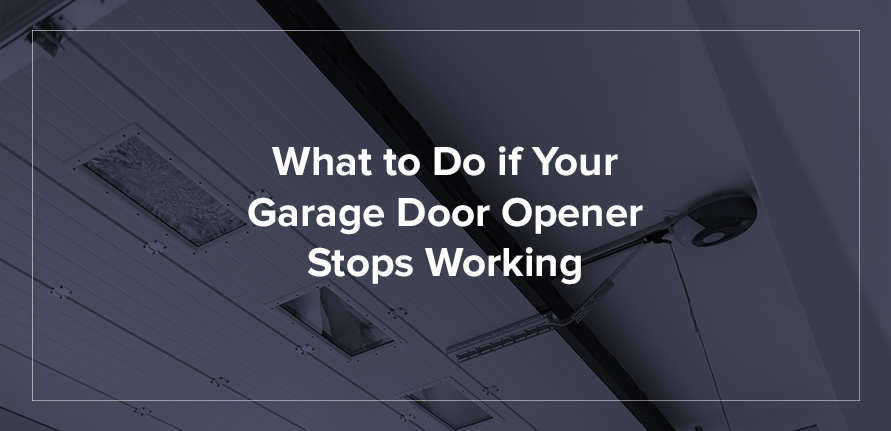
If you’re like most homeowners, you probably rely on your garage door opener to get in and out of your house. But if the opener stops working, it can be a real hassle. When it doesn’t function correctly, don’t panic — there are plenty of tips and tricks available to help.
From the photosensor to the antenna, there could be a few different culprits to blame. We are breaking down some easy DIY troubleshooting tips to help you get your garage door operating like normal. If these tips don’t work, you may need to turn to a professional for repairs or a replacement.
Learn more about what to do if your garage door opener stops working.
Troubleshooting Tips for Garage Door Opener Failure
While it’s possible that you could have garage door opener damage that requires expert repair, there are actually a number of reasons why your garage door opener may not be working that you can handle yourself.
Before calling a professional for help, try these easy fixes for troubleshooting garage door openers first:
1. Isolate the Problem
The first thing you need to do is make sure that the garage door opener system is actually the problem. Start by disconnecting the garage door opener and disengaging it from the power source.
If it is already off or disconnected, you may have solved your problem right away. If your garage door stops working while opening, then you might have another problem, so it’s recommended you try our other troubleshooting suggestions.
After disconnecting the garage door opener’s control panel, try to open and close the door manually. If you can, something related to your garage door opener system is the culprit. If you cannot, you have a different problem.
2. Deal With Any Unrelated Garage Door Problems
If the door will not open or close manually, the most likely culprit is a snapped torsion spring or cables. Examine your springs and cables carefully. If one is broken, it is not recommended that you try to replace it yourself, as untrained spring replacement could lead to injury. Homeowners that utilize their garage doors frequently should consider upgrading to high-cycle springs that are more durable and longer-lasting.
Other non-garage-door-opener-related problems may include debris on the track, a door that is off its track or damaged rollers. Clear off any debris you discover and call a professional to replace rollers or restore rollers to the track. This is a common reason why a garage door stops opening mid-way.
Taking a closer look at your entire garage door system before doing any opener troubleshooting can be beneficial in narrowing down your issue.
3. Check the Photo Eye Sensors
It is mandatory for modern garage door openers to include a photo eye system that retracts the door and will not allow it to come down if the connection between the sensors is broken.
If there is anything under the door while you are trying to close it, it should not close, so make sure the area is clear. Even if there is not, there may be dirt, snow or some other debris on one of the photo eye sensors itself. This will cut the connection and make the system think there is something underneath the door.
Cleaning the sensors can also help get your door operating correctly. Try using a microfiber cloth to gently wipe the lens like you would a laptop screen or a pair of glasses. If you still see dust or dirt on the lens, consider lightly moistening the cloth and trying again.
4. Check the Remote
If your garage door opener is not working when you press the remote button, test out the keypad on your door. Your remote is likely the problem if it opens. The first thing you should do is replace the batteries and try again. If the remote fails to open the garage door, you can either replace it or try to reprogram it.
5. Adjust the Sensitivity
Sometimes a garage door opener has its sensitivity settings too high or too low, which will prevent the door from opening. Consult your garage door opener owner’s manual to see how to adjust this setting.
6. Adjust the Limit Setting
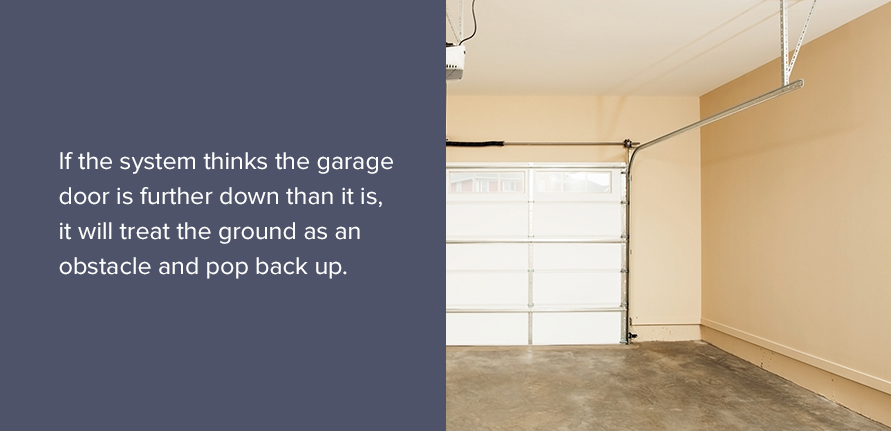
Another setting you may need to adjust is the limit setting, which tells the garage door system where the ground is so it can start lowering the door. If the system thinks the garage door is further down than it is, it will treat the ground as an obstacle and pop back up. Again, the owner’s manual can show you how to adjust this setting.
7. Check to See If There Is a Power Outage
If all the lights on the street are out, it might not be your garage door opener that’s the problem. Even a localized power outage could mean your garage door opener won’t work unless you have a battery backup. If it’s a local power issue, you will just have to wait it out. There are other methods for opening a garage door without power, such as the manual release cord or the emergency key disconnect.
8. Check the Antenna
The garage door opening mechanism has an antenna that reads a signal from your remote to tell it when to open the door. If that antenna is damaged or broken, it may not be able to pick up the signal.
What to Do If Troubleshooting Does Not Work
If you’ve tried troubleshooting on your own and things are not improving, it may be time to turn to a professional. Explore the following solutions to help get your garage door opener working again:
Garage Door Opener Repair
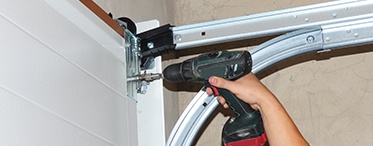
Unfortunately, if none of these solutions work, especially if you are hearing strange sounds coming from your garage door opener mechanism when you try to open it, you may be dealing with a professional repair situation.
A professional can also tell you if your garage door is off-balance and needs additional attention. If the door is imbalanced, it can stop it from opening and become a safety issue very quickly. You will likely need to reach out to a garage door technician for repair or replacement services right away.
Garage Door Opener Replacement
If you have a broken garage door opener that needs repair, and it has been some time since you purchased it, it is likely a good time to replace it with something new.
At Best Overhead Door, LLC we have smart garage door openers from all the best brands, including LiftMaster® and Genie™. Installing one of these systems can help you avoid many garage door opener problems in the future.
For example, with LiftMaster MyQ® smart technology, you can activate your garage door opener from any digital device via Wi-Fi and a mobile app. This means you will never have to stress about misplacing your remote or your remote’s battery dying ever again.
We can also offer you a garage door opener with a battery backup. With the battery backup in place, your garage door opener will still work even if you experience a neighborhood-wide or local power outage.
Our new garage door openers are safer, quieter and faster than older models, probably including the one you have now. If you are interested in finding something new, we can assist you in picking the right opener for your home.
Preventative Maintenance for Your Garage Door Opener
Don’t wait for your opener to stop working to care for it. At Best Overhead Door, we can help you keep your garage door opener operating at its best with preventative maintenance and repairs.
An expert technician should perform routine maintenance at least once a year to ensure your system is in top working condition. We can inspect your garage door and opener and share any necessary repair suggestions.
Our professional technicians will let you know if your garage door hinges are overly worn or if there is a misalignment with the track. We’ll check out every part of the system and hardware to maintain proper operation all year long.
Reach Out to Best Overhead Door to Learn More
At Best Overhead Door, we offer high-quality residential garage door opener repair, service and installation in the Vancouver and Portland areas. We can help you find the right system for your home and get it working as soon as possible.
Are you interested in learning more about our garage door openers and services from Best Overhead Door? Contact us or request an estimate today!
Home Security Tips: How to Protect Your Home From Thieves
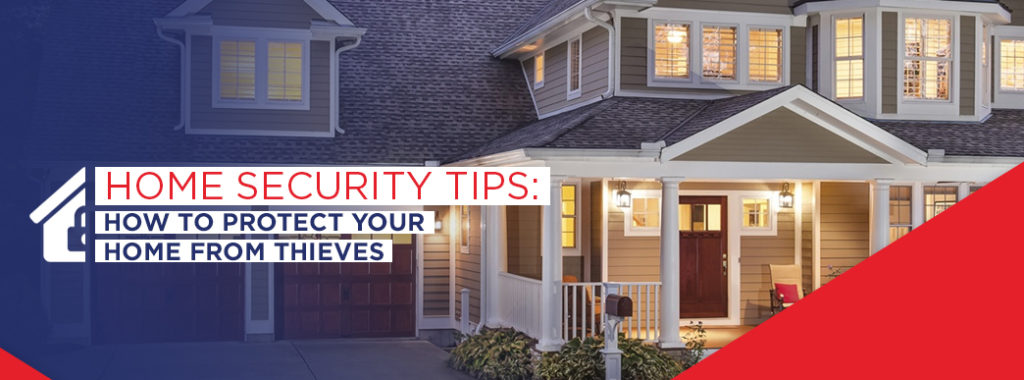 Before we start looking at ways you can protect your home from burglars, it’s important to understand one thing — if a thief wants to get into your home, not a whole lot will stop them. There’s a residential burglary happening somewhere in the United States about every 20 seconds. Only about 13% of residential burglars are caught. The deck would seem stacked against you. The idea behind home security tips is to find ways that you can prevent yourself from being one of those homes. Certain steps will greatly reduce the chances of your home being robbed, yet they’re steps many people never take. In fact, people often set up expensive security systems or elaborate ways to prevent people from entering their homes and yet forget to use these systems. For instance, the most common means of entry for burglars is, believe it or not, the front door — in about 32% of all residential robberies, thieves enter this way. Some burglars will just kick the doors in, and others will remove the hinges. In one-third of front door robberies, they entered the home through an unlocked front door. Think about that. Almost one-third of these kinds of break-and-enter situations happen because people don’t lock the front door. One of the best ways you can protect your home from a robbery is by being aware of all the different ways a thief can enter your home and thinking about how you can prevent them from doing so.
Before we start looking at ways you can protect your home from burglars, it’s important to understand one thing — if a thief wants to get into your home, not a whole lot will stop them. There’s a residential burglary happening somewhere in the United States about every 20 seconds. Only about 13% of residential burglars are caught. The deck would seem stacked against you. The idea behind home security tips is to find ways that you can prevent yourself from being one of those homes. Certain steps will greatly reduce the chances of your home being robbed, yet they’re steps many people never take. In fact, people often set up expensive security systems or elaborate ways to prevent people from entering their homes and yet forget to use these systems. For instance, the most common means of entry for burglars is, believe it or not, the front door — in about 32% of all residential robberies, thieves enter this way. Some burglars will just kick the doors in, and others will remove the hinges. In one-third of front door robberies, they entered the home through an unlocked front door. Think about that. Almost one-third of these kinds of break-and-enter situations happen because people don’t lock the front door. One of the best ways you can protect your home from a robbery is by being aware of all the different ways a thief can enter your home and thinking about how you can prevent them from doing so.
Table of Contents
- What Makes a Home an Easy Target for Break-In or Theft?
- Home Safety Tips
- Products That Can Help Homeowners Keep Their Homes Safe
Clear Nee is a researcher at the University of Portsmouth in the United Kingdom. She has been studying burglars and burglary for more than 20 years, and she has some interesting observations about what makes a home an easy target and what thieves are looking for when they enter.
1. Burglars Will Return Repeatedly to a Vulnerable Street or Neighborhood
If a burglar thinks there are easy targets in a particular neighborhood, they’ll return to that neighborhood repeatedly. Burglars think differently than a normal person. They’re basically “working” even if they’re doing noncriminal jobs or just walking the dog. Throughout the day, they’re constantly observing comings and goings, making mental notes about homes that look vulnerable, thinking about when those homes will be empty and considering the potential payoff. In fact, most burglars live near the neighborhoods they rob, so it’s easy for them to complete scouting missions without appearing out of place.
2. Thieves Will Pass out Fake Junk Mail to Look for Absent Homeowners
Burglars will place menus on a variety of homes in a neighborhood to see if someone is on vacation, learn the times of the day when they’re not home or see if people pay attention to small inconsistencies.
3. Most Experienced Burglars Are Not Interested in Large TVs or Heavy Items
Most thieves go to the master bedroom first when they enter a home. They’re looking for jewelry and other easy-to-carry items like credit cards, passports or cash. Another popular item is a weapon, particularly if the car out front sports an NRA sticker. One of the first places the individual will look is under the mattress. Then, they’ll head to the bathroom to look for prescription drugs they can sell. When they go downstairs, they’ll go to the living room to look under cushions and in vases for car keys, personal information or keys to a safe if the home has one. Then to the kitchen, where they’ll often check the freezer, a popular hiding place for people to put their valuables when they’re away.
4. Burglars Love a Secluded Backyard
Burglars don’t like to be seen. That’s why a secluded backyard is their dream come true. It’s easy for them to kick in a backdoor or even break a window because they know they won’t be seen and most likely won’t be heard. People often forget to lock their back doors as well, so sometimes thieves don’t even have to try hard.
5. Thieves Know They Can Break Into Most Garages With a Piece of Wire or a Coat Hanger
About 10% of all break-ins occur through people’s garages. In many cases, the garages are left unlocked, which makes it easy to enter them. In other cases, thieves will thread a piece of wire or coat hanger from the top of the garage door to pull the emergency open latch. Once inside, they’ll only need to close the door before having unlimited access to your home.
6. Summer Is the High Season for Break-Ins
Thieves know that summertime is the time when most families go on vacation, so the highest number of burglaries occur during the summer. The rest of the year, they’re aware that most people leave home around 8 a.m. and don’t get home till 5 or 6 p.m., so most break-ins happen between 10 a.m. and 3 p.m., when thieves can be relatively certain that homes are empty. These criminals will often watch a neighborhood or a home for weeks to learn people’s regular routines before the attempted break-in.
Home Safety Tips
So now that we’ve looked at a few ways thieves determine which homes to rob, here are some ideas about how you can prevent the situation.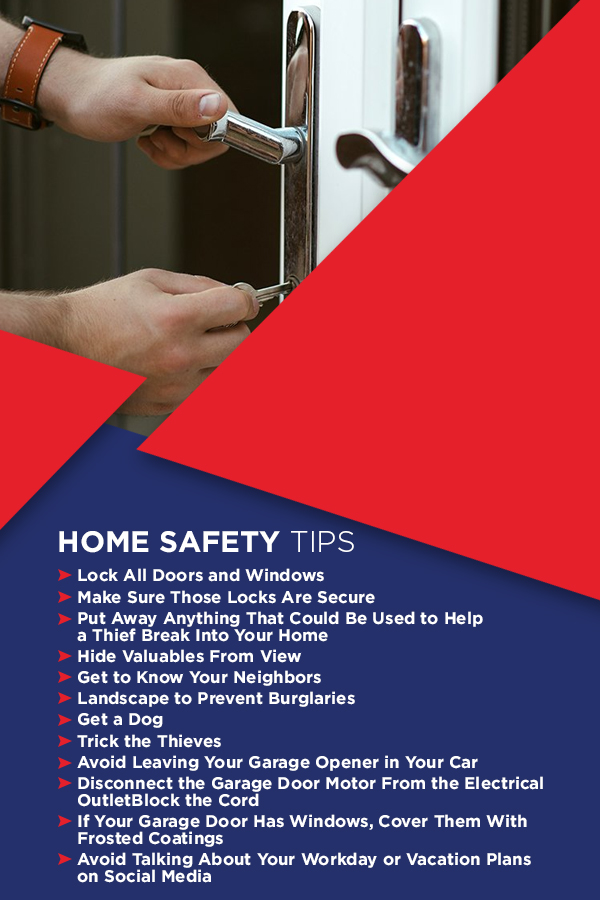
1. Lock All Doors and Windows
As noted above, many thieves enter a home through unlocked doors, garage doors and windows. Before you leave to go to your job during the day or take the family on vacation, make sure every door and window is locked.
2. Make Sure Those Locks Are Secure
If your home doesn’t have them already, install mortise locks so that the bolt slides into the doorjamb. These locks normally require a key to enter, so it doesn’t do a thief any good to break a panel on the door and search for a knob or a handle.
3. Put Away Anything That Could Be Used to Help a Thief Break Into Your Home
Don’t leave ladders, metal bars or garden tools lying around your home — such implements can be used by a thief to help them get into your home.
4. Hide Valuables From View
Never leave money, laptops, smartphones or jewelry lying near a window that can easily be seen into. In addition, never keep large sums of money in your home.
5. Get to Know Your Neighbors
This step is particularly important if your neighborhood has been the subject of a series of break-ins. Take the time to go up and down your street, say hi your neighbors and introduce yourself. Encourage them to keep an eye out for any strange activity taking place around your home when you’re not there. And don’t forget to do the same for them!
6. Landscape to Prevent Burglaries
Hedges planted near a home are amazingly effective at preventing burglaries. It’s also a good idea to look into shrubs or trees, like holly, gorse or Berberis, which all have particularly nasty thorns. Plant them near windows. These kinds of bushes and hedges are difficult to cut down and very painful to try to walk through or climb over. In a word, they’re a great way to deter thieves.
7. Get a Dog
A dog doesn’t need to attack someone — they just need to make a lot of noise when someone comes near the home. True, this behavior may be annoying at other times, like when friends come over — but it can also be highly useful in alerting you. If you’re not into the dog idea, you may want to purchase an electronic simulator that can make dog-like noises activated by motion sensors.
8. Trick the Thieves
Burglars often listen for the sound of voices coming from within a home, so a TV or a radio left on during the day can be a great deterrent. Make sure you leave the radio or the television on a talk channel so that the burglar only hears the sound of voices. Do not, however, leave a radio or TV on nonstop if you go on vacation. Doing so will become a sign for thieves that no one is home. If you put the radio or the television on a timer, make sure the timer allows you to set different times for different days. Most people don’t turn the radio or TV on and then off at the exact same time every day. The same is true of lights: If you have a timer to work with your lights when you’re away, don’t have the lights come on and then turn off at the same time every day. That’s a sure sign to burglars.
9. Avoid Leaving Your Garage Opener in Your Car
Don’t leave your garage door opener in your car attached to the windshield visor or sitting on the front seat if you park your car outside your garage. If you don’t lock your car, a thief can easily snatch the opener and then use it to get into the home when you drive off later. Get used to taking your garage door remote control into your home every time you get out of the car. Since 2017, you can now operate your garage door from your smartphone using LiftMaster myQ (see details below).
10. Disconnect the Garage Door Motor From the Electrical Outlet
If you’re going away for a long period of time, disconnect your door’s motor. That way, it’s impossible to use a remote cord or tamper with any kind of exterior keypad to lift the garage door.
11. Block the Cord
If you want to prevent thieves from using that wire or coat hanger to pull the cord that operates the emergency door opener on your garage, block it. You can do so by using a small steel plate that serves to block the opening through which thieves stick the wire. There are various types of plates that you can buy at your home hardware store. Remember, you may need to remove some models before you open your door.
12. If Your Garage Door Has Windows, Cover Them With Frosted Coatings
You don’t want people peering inside your garage. Buy some frosted plastic coating that you can apply to the windows. This coating will let light in but also keep unwanted eyes from peering in.
13. Avoid Talking About Your Workday or Vacation Plans on Social Media
Thieves are constantly trolling social media sites, especially neighborhood ones, where some homeowners may post their working hours or their upcoming vacation plans. Never talk about your workday hours online, and only post vacation photos when you return. Don’t post pictures from your vacation location — that’s a sure notification to thieves that you’re away from home.
Numerous products on the market — such as security alarm systems or the myQ garage door opener from LiftMaster — offer extra protection to your home.
1. Security Alarms Are a Good Idea, But Will Not Always Deter Thieves
When neighbors hear an alarm, they assume it’s a false alarm because about 95% of all alarms are false ones. The noise might spook an inexperienced burglar, but experienced thieves know most people don’t pay attention to alarms. Think of a car alarm — most people don’t do anything when they hear a car alarm because they believe it’s been triggered by mistake. It only takes a thief about 10 minutes to burgle your house. They know it takes a security company about seven minutes to verify that the alarm is real and then maybe another 10 minutes for the police to come. That’s more than enough time for thieves to go to those few places where they know most people hide their goods, then make their escape. Many thieves will be deterred if they know ahead of time that a home has a security system. Make sure that if you do get a home security system, you put up lots of signs in your yard and stickers on your windows. It’s not that it will always prevent thieves from breaking to your home, but in many cases, they’ll just decide to move on and pick an easier target. You can help make your security system work better by letting your neighbors or the police know when you won’t be home so that if they do hear an alarm go off, they’ll know it’s not a false one. Always be proactive about your home security.
2. The myQ Garage Door Opener From LiftMaster
The myQ garage door opener is a great example of how smart technology can make your home safer. myQ will work with your smartphone so that you’ll always know what’s going on when you’re away. You’ll never need to wonder if your garage door was left open again, and you can get notified when your door opens and closes. That way, you can let loved ones in as well as allowing delivery people to leave packages inside your garage or repair technicians to complete repairs inside. Best of all, you can do all this from anywhere. You could literally be in another country and allow someone to have access to your garage as long as you have internet access. You can also check the status of your garage door from any location to see if it’s open or closed. You can invite three friends, family members or guests to have access to your myQ garage door opener from their own myQ app. For even more security, you can get the LiftMaster 841LM. It’s an automatic garage door lock that features a deadbolt that reinforces the garage door automatically when the door is closed. It works in tandem with an opener, which means it will always lock and unlock when needed.
3. Security Cameras
Security cameras can warn you when someone approaches your home. Many security cameras will work with your smartphone so that you receive a warning anytime this happens. That way, you can determine if the visitor is welcome or not. LiftMaster offers motion detector garage door cameras that work with the myQ app and will let you see who is in your garage from anywhere.
When You Want Security for Your Garage Door, Contact Best Overhead Door
Serving the entire Portland Metro area and Vancouver, WA, area, we provide the very best garage door services. Whether you’re repainting, retrofitting, remodeling or even building a new home, when you want quality value and choice, contact Best Overhead Door for all your garage door needs. We offer estimates via phone, email and video conferencing or we can bring our showroom to you with hand samples and brochures. You can call us at 503-620-1205 or if it’s an emergency, call 503-707-0848. You can also contact us online to schedule service or request an estimate and a member of our team will get back to you as soon as possible.
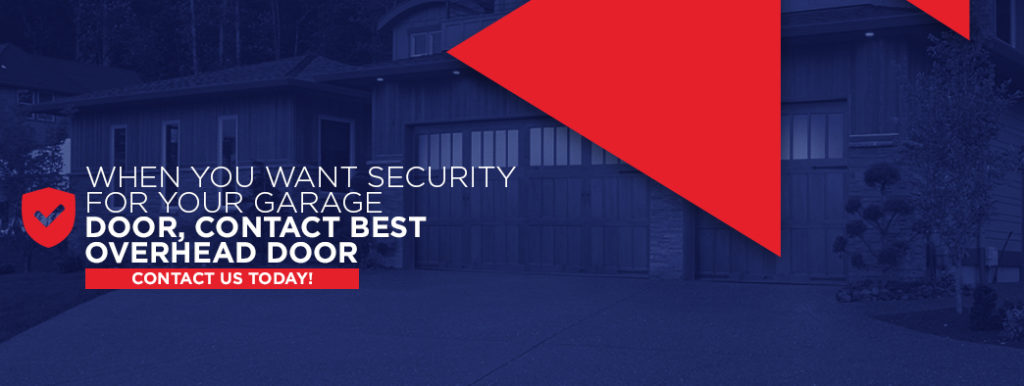
Related Posts
How Do Garage Doors Improve Home Safety? Can Your Garage Door Be Hacked? How to Choose a Garage Door Dealer Home Improvement Projects With the Best ROI
How to Prepare Your Wood Garage Door for Spring and Summer in Oregon
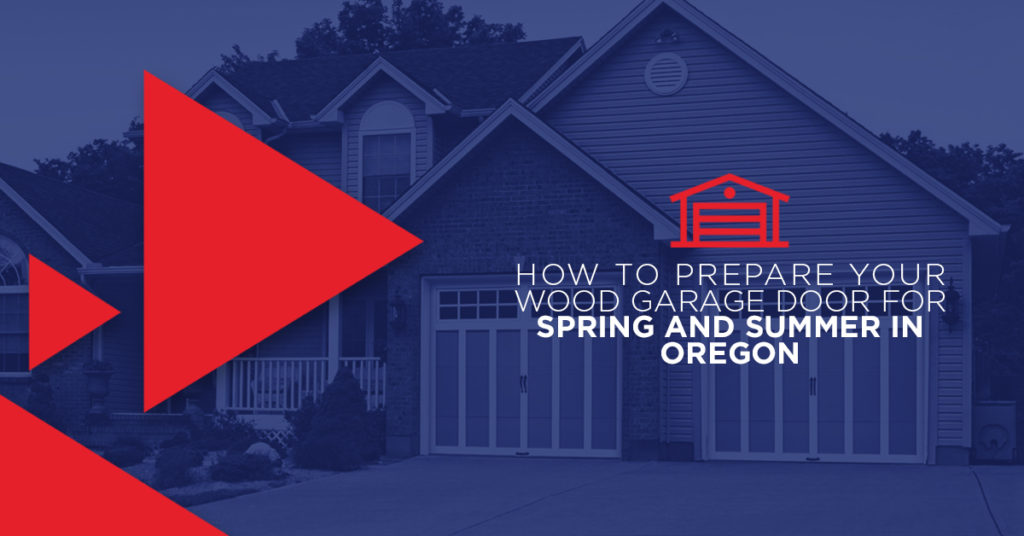
In springtime, a homeowner’s thoughts often turn to ways to spruce up their home. In the middle of all the landscaping and spring cleaning that often comes this time of year, there’s one home improvement project that often gets overlooked — garage door maintenance.
These days, the majority of people use their garage door as the primary entrance to their home. Because you use this door so much, it’s necessary to prepare your garage door for spring and the upcoming summer months as well.
If you have a wood garage door, then it’s even more critical to make sure you’re keeping a close eye on the condition of your door. Wood doors are a beautiful addition to any home, but in cold, moist climates like what we have in Oregon, if you don’t know how to keep a wood door from cracking, you could be in for an unpleasant surprise.
If your home has a wood garage door — or you’re considering purchasing one — it’s important to understand what’s involved with owning and maintaining these works of art. This article covers some of our top wood garage door maintenance tips.
Table of Contents
- How Does Weather Impact Garage Doors?
- Painting and Staining a Wooden Garage Door
- How to Prepare a Garage Door for Spring
Because they’re on the exterior of your home, garage doors will take a beating from the sun and weather your area experiences each year. In the Portland area, wood garage doors are particularly susceptible to water damage. Why?
1. Water Saturation
Wood garage doors absorb water. In wet climates, these doors are constantly exposed to moisture, and they absorb a lot of water. When a door absorbs a lot of water, it becomes heavier. Over time, the additional weight of a water-saturated door adds additional strain to the garage door springs, eventually causing them to stretch or even break.
2. Swelling
The water that wood garage doors absorb also causes the door to swell. When a door swells to be larger than the original size, it becomes more difficult to open and close. This puts a lot of extra strain on the garage door opener and, if left unaddressed, can damage the opener or cause it to wear out and need replacing sooner than expected.
3. Cracks
Wood doors are known to develop cracks as they age, especially if they aren’t serviced regularly. When a door has cracks, moisture can make its way into the cracks. If it’s cold enough for that water to freeze, the ice will cause the crack to expand. When cracks are left undetected over time, this cycle of freezing water and expanding cracks can lead to significant damage.
4. Exposure to Sunlight
In addition to the issues associated with living in a particularly moist climate, sunlight can also damage and affect wood doors, especially if they face east or west and get a lot of direct light during sunny days. Sunlight can trick your garage door sensors into thinking something’s in the way of the door, which causes the sensors to malfunction when you’re trying to put the door up and down. Warm weather combined with a humid coastal climate can also result in the door absorbing moisture more quickly than in drier climates.
Because wood doors are more susceptible to year-round problems in high-moisture areas like Portland’s coastal climate, it’s necessary to make wood garage door maintenance an annual part of your home maintenance routine. Checking the doors and identifying trouble spots is a simple thing to do. However, it’s essential to remember that a professional garage door company should perform most garage door service and repair. When you hire an experienced garage door professional, they can give your door a thorough inspection, identifying any areas of concern that need to be addressed before they become a big problem.
Painting and Staining a Wooden Garage Door
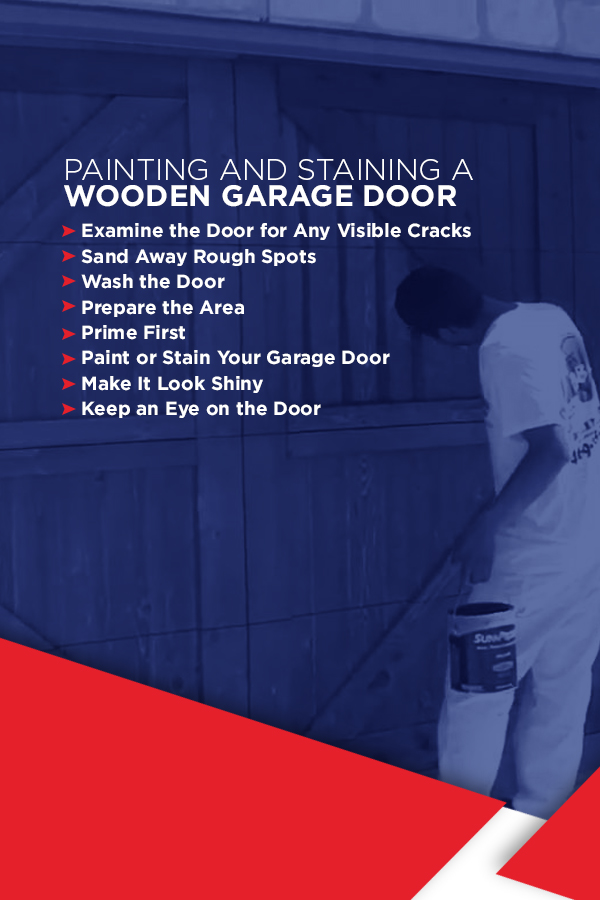 Besides regular maintenance, one of the best ways you can protect and preserve your wood garage door is to paint or stain it regularly. Whenever we mention this to customers, their first question is, “How often should I paint my garage door?”
Besides regular maintenance, one of the best ways you can protect and preserve your wood garage door is to paint or stain it regularly. Whenever we mention this to customers, their first question is, “How often should I paint my garage door?”
There’s no hard and fast number when it comes to frequency. If your garage door faces north or south — meaning it doesn’t get direct sunlight — you’ll probably only need to repaint every five to six years. But, if your door gets direct sunlight throughout the day — faces east or west — then it may be more susceptible to fading, cracks or other weather-related damage. It will need to be repainted more frequently to prevent moisture from breaching the seal of the stain or paint. If you’ve opted to stain your garage door instead of painting it, you should plan to stain and seal your garage door once each year.
Now that you’ve bumped this critical project to the top of your home maintenance list, it’s time to get started. While there are many similarities between the process of painting and the process of staining a garage door, there are also some meaningful differences that you’ll want to be aware of before you get started. Be sure to read through the entire process before you begin.
1. Examine the Door for Any Visible Cracks
If you find any cracks, caulk them, and then allow the caulk to dry completely before painting. While you’re doing this, you can also scrape away any peeling paint or rotted wood on the door. If you need to remove a small piece of wood rot, you can repair it with wood filler. Please don’t skip this step. This preparation process is crucial because it improves the integrity of your door and guarantees a smooth finish after you’re done painting.
2. Sand Away Rough Spots
Once the caulk and wood filler dries, use an electric sander to smooth out any bumps or rough edges left behind. The sander is also a great tool to use if your door has large patches of peeling paint since it might take too long to scrape off large patches by hand.
3. Wash the Door
Apply a degreasing cleaner to the door, and then scrub it down using a large sponge or brush. If you find any patches of mildew on the door, apply a mildewcide as well. Then, rinse the door with a hose and allow it to completely dry. Yes, we do recommend using a garden hose rather than a power washer. Even though your door is made of solid wood, it’s important to protect it and avoid the powerful streams of water that you’ll get on most of the power washer’s settings.
4. Prepare the Area
Once the door is dry, use painter’s tape and masking paper to cover any hardware or windows on your garage door. You’ll also want to lay a drop cloth down along the ground and tape masking paper on the walls alongside the garage door to prevent paint or stain from coming in contact with your siding.
You’ll also want to prepare yourself. When using a paint sprayer, it’s a good idea to wear a mask to prevent from inhaling particles of paint and disposable gloves to make your clean up easier later.
5. Prime First
If you’re staining your garage door, then you can skip this step. If you’re painting, priming is necessary.
The best tool for this job is a paint sprayer. They’re relatively inexpensive, so if you don’t already have one, it’s worth the investment. Fill the sprayer with primer, then apply to the door using a back-and-forth motion, overlapping your previous strokes so there aren’t gaps in between. This will work best if you hold the paint sprayer about one foot from the door. Consult the manufacturer’s directions on the primer to determine how long primer should dry before you move on to paint.
While the primer is drying, remember to clean out your paint sprayer so that the primer doesn’t get mixed in with the paint you’re about to use. After all, you don’t want it to dilute the color you’ve chosen.
For new doors, it’s best to prime all six sides of the door to keep water from seeping in, so keep this in mind if it’s the first time your door has been painted.
6. Paint or Stain Your Garage Door
Once the primer is dry — or you’ve skipped that step because you’re using stain — it’s time to apply paint or stain to your garage door. Using the same back-and-forth technique you used when you were priming, apply an even coat of latex paint or oil-based stain to the garage door. Once it’s covered, allow it to dry. Then, if needed, add another coat to achieve the shade you want. If you’re using stain, you’ll likely only need one coat, but paint may require an extra coat or two to achieve the color you want.
Also, while we do recommend using a paint sprayer for this task, you can use a roller or brush. Just be careful to apply even brush strokes and take your time so that it looks good when you’re done.
7. Make It Look Shiny
If you’ve applied stain to the door and you want it to have a glossy look, you can apply a layer of polyurethane or exterior varnish. Just be careful because these products will peel over time, which means you’ll need to stain again even sooner.
8. Keep an Eye on the Door
Once your garage door is dry, you’ll want to keep a close eye on the paint or stain to see how it wears over time. In general, staining requires more maintenance than a paint job, so plan to refinish your door once each year to keep it looking nice and new. Since wood doors tend to crack in the heat and sun, it’s a good rule of thumb to plan to stain your door in the spring after the rains clear but before it becomes too hot. That way, your door will be ready to withstand the sunshine and heat of summer.
Besides staining or painting, you can plan to perform seasonal garage door maintenance to keep your garage door in good shape and prepare it for the warm weather and sunshine that accompany spring and summer.
1. Inspect the Door and Its Opener
Take a few minutes to look over your garage door. Take note of any cracks, dents or dings that might allow moisture to worm its way into the wood. Also, note any places in the existing paint or stain that seem to be wearing or peeling.
Once you’ve inspected the door, take some time to look at your garage door opener. Inspect the tracks and springs to make sure they’re operating smoothly. You can even run the door up and down a few times, listening for any noises that might indicate that it’s not moving as smoothly as it should.
2. Replace the Batteries in Your Garage Door Opener
Your garage door opener is most likely wired into your home’s power supply, but some models have a battery backup feature in case your home loses power. As you’re inspecting your door, make a point to check to see if your backup batteries are charged and change if needed.
3. Clean Your Garage Door
Even if it doesn’t need a fresh coat of paint, make a point to clean your garage door each spring. Garage doors are subject to dirt and rain and debris on an ongoing basis. Keeping them clean prevents the debris from getting stuck in the garage door opener’s track or doing damage to the door itself over time.
4. Add Lubricant to Moving Parts
Repairing a garage door or opener can be dangerous if you don’t know what you’re doing. But lubricating the moving parts of your garage door opener helps prevent the need for repairs in the first place. Apply a lubricant to the hinges, spring, rollers and bearings to keep everything operating as it should. Of course, if you aren’t sure where these are — or you aren’t comfortable doing it yourself — then it’s a good time to schedule a service call with an experienced professional.
5. Know When to Call a Professional
DIY home improvement projects are on-trend right now, but when it comes to your garage door, it’s dangerous to do repairs and maintenance yourself if you don’t have experience working with garage doors. Yes, painting and staining a door are things that homeowners can do without much trouble. But, if you suspect that your door is broken or the garage door opener needs repair, it’s time to call a professional garage door company for help.
Even if your door appears to be in good working order, it’s not a bad idea to have a garage door company you can call with questions, like, “How often does my garage door need to be serviced?” or “What do I do if my wood garage door cracks?”
Keep Your Garage Door Looking Nice in Spring and Summer
Even in our area, many people aren’t aware of how humidity affects wood garage doors. It can be a challenge to keep them looking nice and new, but their classic beauty is worth the effort.
When it comes to seasonal garage door maintenance, a little elbow grease is all it takes to keep your door in working order. But, sometimes things happen, and you need to call a professional garage door company for a repair. Best Overhead Door is the premiere garage door company in Portland, Ore., specializing in sales and repair of residential and commercial garage doors. A Portland fixture for nearly three decades, Best Overhead Door offers experienced service at reasonable prices. And, if your door can’t be repaired, then we’re here to walk you through the process of selecting a high-quality, long-lasting replacement.
If your garage door needs a tune-up or you’re in the market for a replacement, look no further than Best Overhead Door. We offer estimates via phone, email and video conferencing or we can bring our showroom to you with hand samples and brochures. Schedule service or request an estimate online or by calling (503) 620-1205.
Related Posts
Does My Garage Door Need Regular Maintenance? Do Garage Doors Need to Be Inspected? How to Paint & Maintain Your Custom Carriage House Garage Door Tips for Keeping Your Garage Organized and Clean Year-Round
How Do Garage Doors Improve Home Safety?

Garage doors, from the outside, look like an impenetrable force to prevent home burglaries. And as long as only family members have remotes or keypad codes, intruders can’t enter your home, right? Garage doors can provide excellent security for your home as long as they’re not accidentally left open and are properly maintained. Many intruders can take advantage of your home’s lack of security by either copying your garage door opener’s frequency to their own remotes or even being able to lift roll-up garage doors.
Tips for improving your home’s garage door security include:
-
Closing Your Garage Door: A simple solution, by keeping your garage door closed, you reduce the chance of inviting unwanted visitors into your home.
-
Adding Surveillance: Home security cameras are now fairly inexpensive, and installing these cameras and motion sensor lights can deter breaking and entering.
-
Upgrading Your Garage Door Opener: With today’s technology, many garage door opener models can control the garage’s lights, have rolling opener codes, vacation modes for when you’re out of town. They also have a “timer to close” settings that can automatically close itself without having to push a remote button. They also can be integrated with home security systems. LiftMaster has an Amazon Key where packages are delivered inside your garage and you are notified when this happens.
-
Perform Regular Maintenance: It’s recommended that a professional look at your garage door system at least once annually. Proper maintenance ensures your door and opener are all functioning properly.
-
Replace Garage Door Opener If Damaged: While not the most enjoyable purchase, if your garage door opener is damaged or broken, then replace it. An improperly functioning garage door can be an easy opportunity for thieves.
Garage Door Technology to Improve Home Security
At Best Overhead Door, we offer a wide variety of garage door openers, many utilizing the latest technologies to improve your home’s security, including rolling garage codes and light control. Most of our LiftMaster garage door openers are enabled with MyQ technology. MyQ is a free smartphone app that gives users total control over your garage from anywhere. With this technology, you can receive real-time alerts to your phone letting you know whenever your garage door is opened or closed. You can also open or close your door remotely and link your MyQ opener to a Nest Cam or achieve XFINITY Home Integration.
Other technologies you can incorporate into your garage door setup include:
-
LiftMaster 821LM: This device is compatible with virtually all garage door openers manufactured after 1993 and can control two garage doors. Like later technology with MyQ installed in the machine, this separate device can open and close remotely, control lights and be incorporated with Nest Cams.
-
Magic Closer Automatic Garage Door Closer: This device is easy to install and works with all opener brands and models made after 1993. With this device, you can program your door to close after five or 15 minutes, or six hours.
-
LiftMaster Mini Remote Control: Compatible with LiftMaster and Chamberlain models, this small remote allows you to keep your opener remote with you at all times, connected to your keychain, preventing theft.
-
Add Lock: While not the most convenient during busy days, a lock can be installed to the inside of your garage while you’re away to prevent entry.
-
Shield Emergency Release: By prying the top of your garage open, thieves can insert a coat hanger through the gap and trigger your garage door’s emergency release, allowing them to open the door from the outside. This shield attaches to the emergency release bar, blocking the handle from being tampered with.
Call Best Overhead Door Today!
To improve your home’s garage door safety, call the experts at Best Overhead Door today. We have a wide variety of security solutions for your home, including the latest garage door opener models from LiftMaster and Chamberlain, featuring MyQ technology. We offer estimates via phone, email and video conferencing or we can bring our showroom to you with hand samples and brochures. Our technicians are here to answer any questions and make recommendations for your home. To learn more, call us today at (503) 620-1205 or schedule an appointment with our online form.
Related Posts
Can Your Garage Door Be Hacked?
How to Choose a Garage Door Dealer
Home Improvement Projects With the Best ROI
Home Improvement Projects With the Best ROI
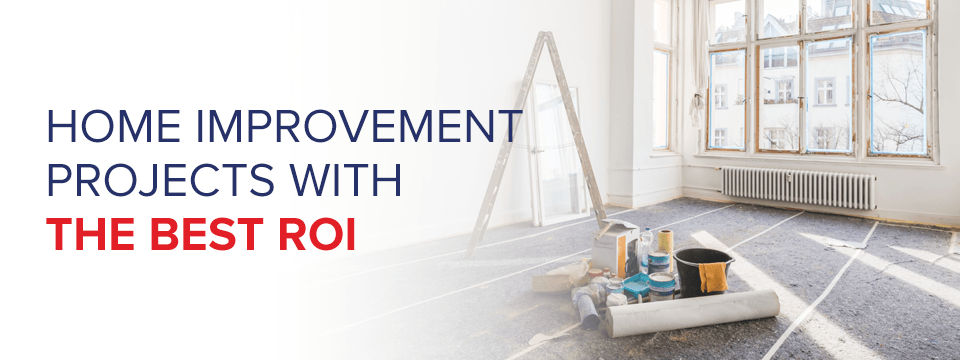
These days, television is filled with home improvement shows featuring remodeling and decorating on both a large and small scale. Everyone is talking about installing new hardwood floors, knocking down walls and replacing old pipes. It all sounds great, but most people don’t have the luxury of renovating their entire home all at once. And, the truth is that this approach to home improvement isn’t always the smartest.
Whether you’ve recently purchased your home or you’re contemplating a move, it’s important to weigh the renovations you want to do with their potential for return on investment (ROI). What does that mean? The ROI is the amount of value any given renovation or repair will add to the overall value of your home — either in equity or when you decide to sell it.
While some renovations can — and should — be done simply because they are meaningful to you and your family, if you have multiple projects to tackle, you should prioritize them to make the most of your time and money.
Reasons to Invest in Home Improvement
Homeowners tackle improvement projects for many different reasons. Some projects have short-term benefits while you won’t see a return on others until you sell the house. Here are some of the most common reasons for investing in home improvement.

1. Maximize Curb Appeal
A home’s curb appeal is how it looks on the outside. There are a lot of elements that play into curb appeal, but generally, the three things that are the most important to consider when you’re improving your home’s curb appeal are the front door, the exterior materials such as siding and the landscaping that surround a home. This can also include your garage door if your garage is attached to your house and visible from the street.
Many people wouldn’t think twice about the appearance of their front door or how many bushes they have in the yard. But when it comes to a home’s value, first impressions can make or break the sale of a home. Not only that but even if a potential buyer is willing to give a home with less-than-desirable curb appeal a shot, they may not be willing to pay as much for it.
Of course, one of the more immediate benefits of curb appeal is that you can enjoy the beauty of your home’s exterior every time you drive up after a long day of work or on the weekends relaxing on the porch with a glass of lemonade. There’s nothing like pulling into your driveway and immediately relaxing as you take in beautiful bushes, high-quality siding and a well-chosen paint color.
2. Improve Resale Value
Curb appeal is just one way to improve your home’s appeal to potential buyers if you’re ready to put it on the market. However, you shouldn’t wait to think about improving your home’s resale value until the For Sale sign is in the yard — by then it’s probably too late. The perfect time to make improvements to your home is on an ongoing or as-needed basis. After all, if you’re going to put money into renovations, you should be able to enjoy them yourself.
While any improvement you make to your home will add what’s called “intrinsic value,” which is a personal value you place on that specific feature or improvement, not all upgrades will add monetary value to your home. As you make changes and improvements, do your research and make sure you know which projects are more likely to yield results when you go to sell your home.
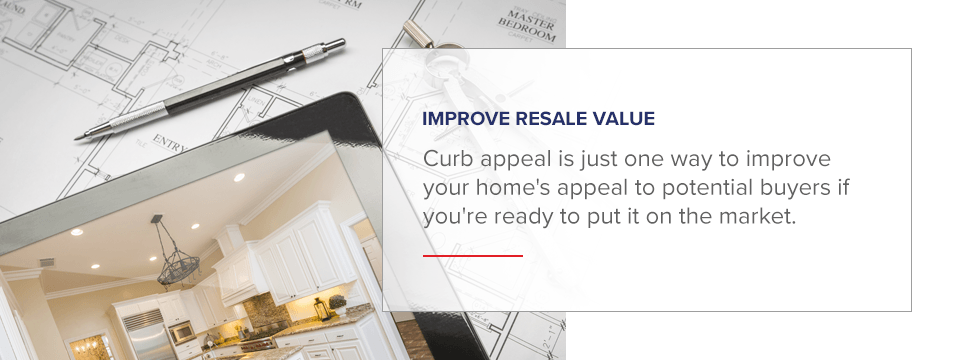
Many homeowners get confused by this because they mistakenly believe that their own personal preferences reflect the preferences of other people. For example, many people believe that adding a pool to their backyard is a great way to improve a home’s resale value. However, this just isn’t true.
Yes, there are other people out there who would like to own a home with a pool. But, for other potential buyers who may not want to deal with the upkeep or have the time to swim, it may be a burden and turn them away from your home’s potential. We aren’t saying avoid pools — if your family will enjoy it, then go for it. Just make sure you have realistic expectations when it comes to how different projects affect the way other people see your home.
3. Improve Efficiency
Improving your home’s overall energy efficiency can give you both short- and long-term benefits. In the short term, it will reduce your monthly energy costs. When you improve your home’s energy efficiency by adding insulation or replacing old windows, you’ll also make your home more comfortable. After all, there’s nothing worse than freezing your way through winter because your windows are 50 years old.
Today’s home buyers are also more interested in eco-friendly home features. If you’ve put money into new windows, doors and insulation, you’ll definitely pique the interest of potential buyers. However, if you haven’t paid for upgraded windows, don’t worry just yet. There are some basic things you can do to improve your home’s energy efficiency in the short-term. Have your heater and HVAC serviced to make sure they’re running at optimal condition. Consider upgrading your thermostat, adding weather stripping around your windows and doors, improving your home’s insulation or even installing a new insulated garage door. Any of these options will be cheaper than new windows, but push down your home’s energy costs — all while making you more comfortable.
4. Build Equity
Equity is the market value of your home minus whatever you still owe on it. While you don’t have control over market values, you do have control over the value of your property. Think of it this way — having a mortgage is like having a savings account you can’t touch. That means it’s going to build up over time because you aren’t constantly tempted to take money out of it. If you are simultaneously paying down your mortgage while you make improvements to your home, over time, this will improve your home’s equity because its value will increase while the amount you owe will decrease.
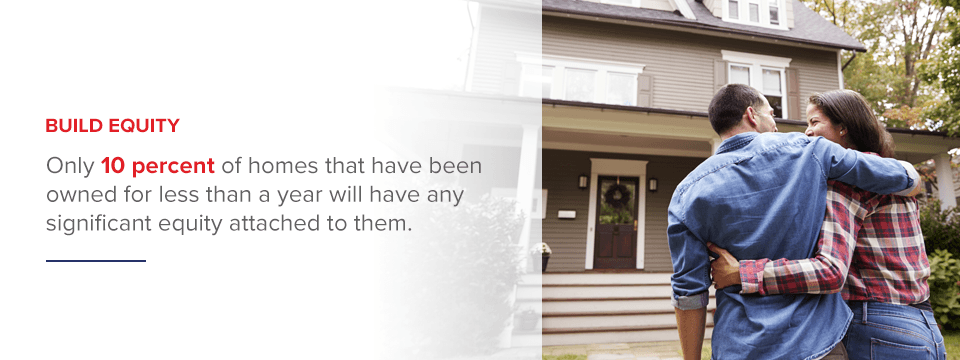
This can be an especially valuable strategy for first-time home buyers and those who have purchased a home that needs a lot of repairs, however, it’s important to remember that building equity in a home is a long-term strategy for financial success. Only 10 percent of homes that have been owned for less than a year will have any significant equity attached to them. But, if you’re invested in staying in a house for several years and making improvements along the way, you’ll likely see some equity build up over time, assuming there aren’t any significant changes to the real estate market in your area.
Home Improvement Projects That Pay Off
As any homeowner can tell you, when it comes to home improvement projects, the work is never done. There’s always something that needs to be repaired, updated or replaced. How is a homeowner supposed to preserve their sanity and their bank account when there’s so much work to be done?
The key to a successful home improvement strategy is to prioritize. Figure out what’s important. Obviously, you need to make your home comfortable for you and your family now. There’s no reason to put off improvements that will significantly contribute to your overall comfort and happiness while you live in your home. But, once you’ve met your family’s needs, the best way to prioritize your projects is to look at those that will help you build equity into your home and ultimately get you the best ROI when you do put your house on the market in the future.

It’s also important to note that when you’re looking at the statistics on home improvement projects and their ROI, the percentages are based on the amount spent on the project. It’s important to understand national averages, as well as what’s common in your area, because these will ultimately impact your home’s own ROI.
1. New Garage Door
In 2018, REMODELING Magazine reported that replacing a garage door can net a homeowner a 98.3 percent ROI at a $2,000 cost. In some locations, homeowners who opted for a new upscale garage door even found themselves recouping more than 100 percent of their expenses. Why is a garage door such a big deal? Curb appeal is a big part of it. When a home has great curb appeal, it makes potential buyers more interested in what’s on the inside and more willing to pay what the home is worth. A beautiful garage door can be a great way to hint at a beautiful interior. Not only that, but a garage door is a relatively inexpensive home improvement to make, which makes it more feasible for many homeowners.
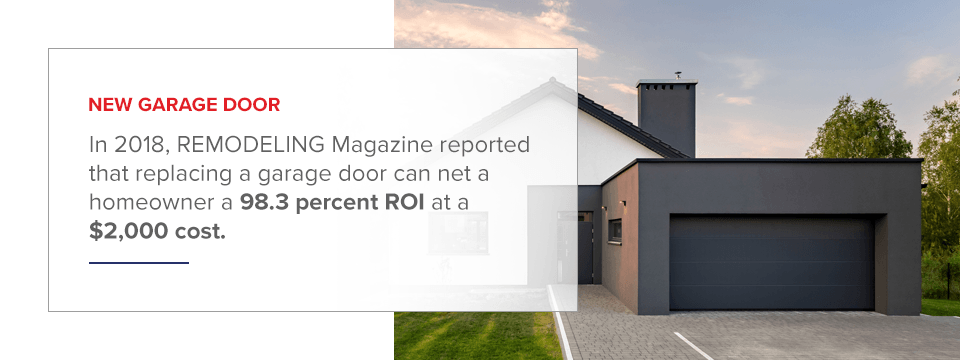
If you’re replacing your garage door, make sure you choose one whose design and price point are in keeping with your home. An upscale door is a beautiful feature to add to any home, but if you own a mid-century ranch, you probably ought to avoid a door that looks like it belongs on a Victorian carriage house. Consider working with an experienced garage door company to determine which door and price point will provide the most value and appeal for your home.
2. Siding
Giving the exterior of your home a fresh new look can spruce up curb appeal and add equity all at once. Yes, siding can be an investment, but it’s one worth making because it will give you a strong ROI when you go to sell your home. Vinyl siding has been found to have a 75 percent ROI at $10,000, with its fiber cement cousin cashing in at a whopping 83 percent ROI.
Not only does siding give you a high ROI when you go to sell a home, but you’ll save on maintenance costs over time. Vinyl siding doesn’t need to be painted, so as long as you choose a good quality product, it’s going to give your home a clean, fresh look for a long time. Fiber cement siding is more expensive up front, but one of its biggest benefits is that it has a high-quality appearance that can be appealing to a lot of people. Vinyl siding has come a long way and can make your home look very nice, but fiber cement siding adds an extra “something” that can be irresistible to buyers.
3. New Roof
No one wants to spend a rainy day getting cozy with their mop and wash buckets. But if you neglect your roof, that’s exactly what’s going to happen. The lifetime of a roof varies, depending on what it’s made of, but if your roof is approaching the 20-year mark, it may be time to start planning for a new one. The good news is that the average ROI on a new roof is 109 percent at a project cost of $8,150. No one is going to buy a leaky house, but buyers are willing to pay for a home that’s being protected by the elements.
While most roofs are designed to last 20 to 25 years, it can be challenging to figure out when it’s time for a new one, especially if you don’t know when the current roof was installed. With a little detective work, you can easily spot potential problems and then determine whether or not it’s time to call in a professional. Your home may be ready for a new roof if:
- Shingles are missing, misshapen or covered with moss.
- Your energy bills have gone up.
- You can see sunlight shining through into your attic.
- You find stains on your ceiling or walls.
4. Insulation
If you find yourself sweating profusely while your air conditioning is running or spending the winter wearing your parka and gloves indoors, it may be a good idea to improve your home’s insulation. Many homeowners often overlook this one because you can’t see insulation. But we guarantee it will make a difference in your home’s overall energy efficiency. Redoing or improving your home’s insulation will result in an average 76 percent ROI at $2,000. That’s appealing to potential buyers and, as the current homeowner, it’s guaranteed to immediately save you money on energy bills.
5. Flooring
If you’ve watched even just one home improvement show on TV, then you’ve heard the hype surrounding hardwood flooring. And with good reason. Hardwood floors are a widely appealing feature because it can make even a simple home look “high end.” It’s also easier to keep clean than carpet and, if you have family members with allergies, hardwood floors make it easier to keep allergens at bay and your loved ones comfortable.
Not only are hardwood floors widely viewed as one of the most practical flooring options on the market today, but their ROI for homeowners is huge. If your home has existing hardwood floors and you opt to have them refinished, you’ll likely see a 100 percent ROI when it comes time to sell. If you have old flooring replaced with new hardwood floors, you can expect somewhere around a 91 percent ROI. Flooring is a project that some homeowners tackle themselves, which can also save money in the short-term. Whether or not you should tackle a new floor on your own will depend on your budget and your abilities.
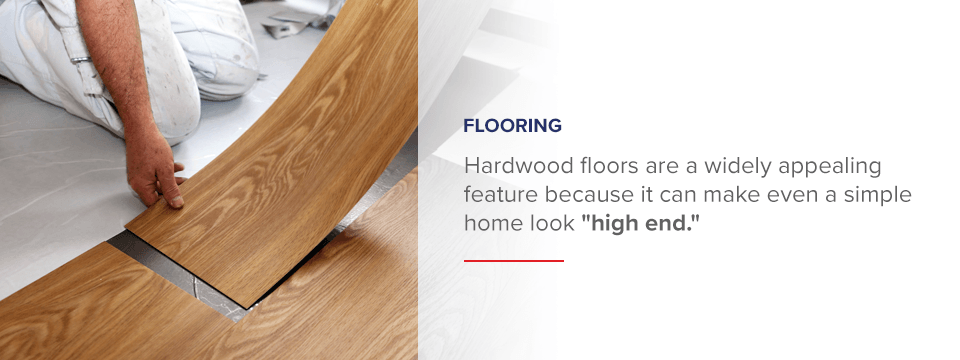
These five suggestions are some of the most highly recommended home improvements you can make if you’re looking to maximize your ROI when it comes time to sell. However, it’s certainly not a comprehensive list. In addition to these big-ticket items, homeowners should also consider replacing their front entry door, tackling mid-range kitchen remodeling projects, adding or updating a wooden deck, a two-story addition or a basement remodel. All of these projects have been found to average over a 70 percent ROI for homeowners.
Should I Hire a Contractor or Try to DIY?
While some of these home improvement projects are relatively straightforward, taking on projects can quickly become overwhelming, especially if you aren’t the next Bob Villa. Even projects that are less expensive can quickly add up and put a strain on your wallet if you aren’t careful. So what’s a homeowner to do?

Some projects will make more sense to tackle yourself. However, everyone has different skills and abilities. Not only that, but some projects should never be done on your own.
As a general rule of thumb, you should always hire a contractor if:
1. The Job Could Destroy Your Home
For example, if you have a leaking pipe and you attempt to repair it yourself, you could potentially make the leak worse, leading to serious water damage in your home. If you hire a plumber, they’re experienced and licensed, meaning they should be able to fix the problem without creating a bigger problem. And, even if they do make a mistake, they would be financially liable for it — not you.
2. The Job Requires a Permit
If your locality requires a permit to tackle the home improvement job you have in mind, then it’s best to call in a professional. This could include building an addition on to your home or dealing with anything linked to your home’s utility lines.
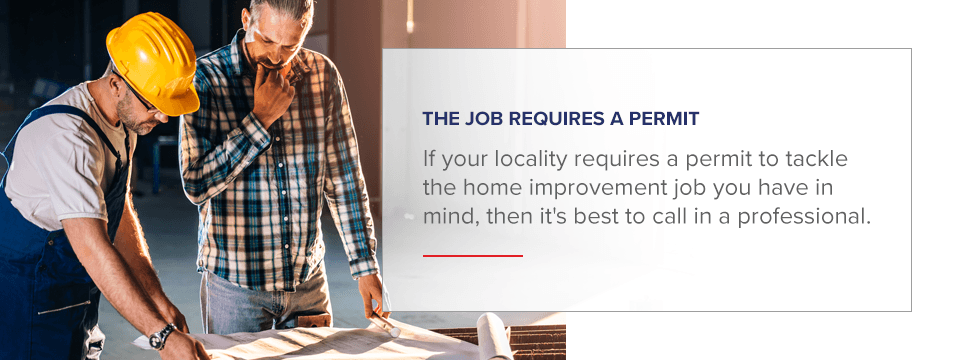
3. The Job Could Be Dangerous
Projects that involve electrical work, roofing or something with the potential to be hazardous to you. As a general rule of thumb, you should call in a professional for:
- Garage door installation and repair
- Structural repair, including drywall, foundation, roofing and anything that alters your home’s architecture
- Electrical and plumbing, including repair and replacement of wires and pipes or installing major fixtures like tubs
- Renovations, including new doors and windows or putting up or taking down walls
- Restoration, including clean up after water or fire damage
While there are home improvement projects that require a knowledgeable professional, there are plenty of things a homeowner can do on their own to improve their property. Not only that, but they don’t have to be things you already know how to do. You can watch videos online, talk to a knowledgeable friend or family member or visit your local hardware store for tips and training. The amount of work you can take on will certainly depend on your time and abilities, but in general, homeowners can tackle projects including:
- Painting, sealing and refinishing, including indoor and outdoor paint, refinishing decks and other wood finishes
- Landscaping, including planting and maintaining grass, shrubs, flowers and tree trimming
- Outdoor upkeep, including window washing, cleaning out gutters and cleaning debris off of the roof and yard
- Installation and maintenance of sprinklers and drains, which keep your landscaping alive and direct excess water away from your foundation
Owning a home is about having a warm, comfortable place to make memories with your loved ones. Nothing beats the excitement of updating and improving the place you raise your children, celebrate holidays and come home to after a hard day of work. Being a homeowner isn’t always easy and, if you lose sight of what’s important, you may become more focused on the work and money than what really matters.
At Best Overhead Door, our goal is to take the stress out of garage doors. We are your one-stop shop for garage door repairs and installation. Serving the Portland metro area, as well as Vancouver, we’re dedicated to walking with you through the entire process of purchasing a garage door — from choosing the design and color that best suits your home all the way to installation and maintenance.
A high-quality, reasonably priced garage door is one of the best investments a homeowner can make. If you’re ready to make this investment, we’re ready to help. Request an estimate or contact us today for more information.
Related Posts
How to Choose the Perfect Garage Door for Your Home
How to Choose a Garage Door Dealer
How to Paint & Maintain Your Custom Carriage House Garage Door
How To Tell If Your Garage Door Hinges Wear Out

Although small and somewhat easy to ignore, your garage door’s hinges are an essential component, guaranteeing the proper opening and closing of your garage door and allowing your door to accurately follow the track to eliminate any swinging. If the garage door hinges wear out, it may be extremely difficult or impossible to safely open your garage door.
Whenever your garage door operates, many parts are under a great deal of tension, weight and pressure — including the hinges. Garage door hinges can often wear or become broken as a result of being damaged — for example, by a car impact or improper maintenance. You can typically determine your hinges are wearing out if there are loose or missing screws, the roller shafts do not slide side to side, rust buildup, a squeaking noise whenever you operate the door, or if the hinge looks bent in anyway. This can cause drag on the door causing the door and opener to wear out sooner. Once you suspect your hinge is wearing out, or if the hinge has already broken, it’s best to go ahead and replace the hinge with a newer, sturdier, heavy steel option.
Whenever you need garage door repair or maintenance, it’s always best to trust a professional. It can be very tempting to get a garage door hardware kit from your local big box retailer but DIY repairs put you at risk of avoidable injury. Our technicians at Best Overhead Door have the necessary tools and knowledge available to safely make repairs without risk of personal injury.
Trust Us for Preventative Garage Door Maintenance
Once you’ve replaced your garage door hinges, conduct routine maintenance to ensure they’re always in good working shape. The best way to ensure the lifespan of your garage door is to trust a professional to perform maintenance at least once every year. During maintenance, a professional will check all moving parts and ensure everything is properly lubricated. This includes checking on the functionality of the dooor hinges and torsion springs. As needed, they will make any repair recommendations or upgrades to ensure your garage door is always operating properly and safely with all the necessary hardware.
For Garage Door Repairs, Trust Best Overhead Door, LLC
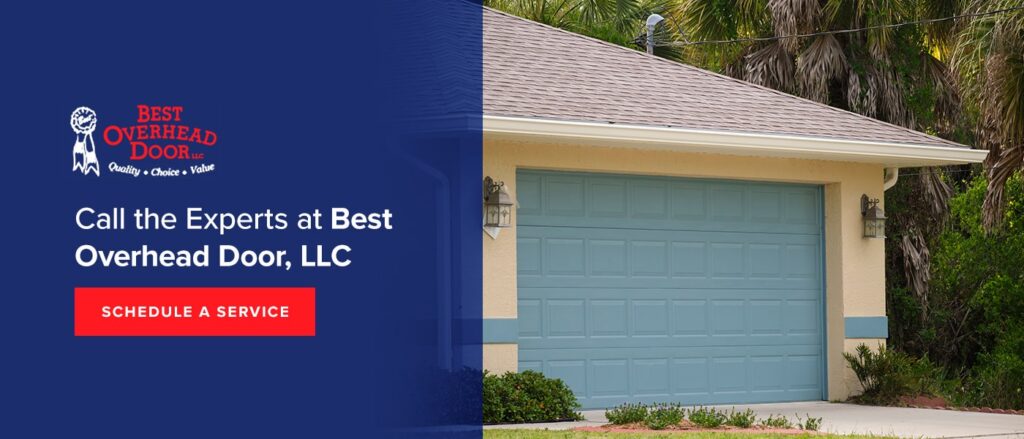 For all your garage door repairs, it’s best to trust a professional to guarantee safety and proper repairs using quality tools and equipment. For nearly 30 years, Best Overhead Door has been the premier garage door installation, maintenance and repair company for Portland, OR, and Vancouver, WA. If you’re ever stuck with an improperly functioning garage door, call our technicians, who are available 24-hours a day, and can promptly and reliably repair your garage door.
For all your garage door repairs, it’s best to trust a professional to guarantee safety and proper repairs using quality tools and equipment. For nearly 30 years, Best Overhead Door has been the premier garage door installation, maintenance and repair company for Portland, OR, and Vancouver, WA. If you’re ever stuck with an improperly functioning garage door, call our technicians, who are available 24-hours a day, and can promptly and reliably repair your garage door.
To learn more about our services, complete our online contact form or speak to one of our team members today at (503) 620-1205.
Related Posts
How to Tell If Your Garage Door Springs Are Broken
How Do Garage Doors Improve Home Safety?
Do Garage Doors Need to Be Inspected?
How to Choose a Garage Door Opener

If you don’t have an automatic garage door opener for your garage, or your existing garage door opener is worn out or you just need an upgrade, it will be important for you to know how to choose a garage door opener to replace it. You can choose from many different types of garage door openers, and knowing which one is right for you will depend on a variety of factors.
Here are four of the main factors to consider when you’re wondering how to choose a garage door opener.
Type of Drive
Your automatic garage door opener can be belt drive, screw drive or chain drive. This refers to the mechanism the opener uses to pull the garage door along the track.
If you choose a garage door opener with a chain drive, you will find this to be an economical option but Chain drives tend to be the loudest garage door openers. So if garage door noise is an issue for you, you may not want to go with the chain drive.
A screw drive garage door opener is a little quieter than a chain drive, but usually a little more expensive and are becoming much less popular.
If you really need quiet when it comes to your garage door, get a belt drive garage door opener. These are easily the quietest, and they are also very reliable.
AC motor VS DC Motor: The DC motor has a slow start and slow stop which is easier and less wear and tear on the door helps it to be the very quietest of all garage door openers.
The door is a big part of a noisy garage door opener. If the garage door is tuned up properly then the opener will sound quieter and have to work less. Another way is to replace your bearings and your steel rollers with nylon ones.
Size (Horsepower)
The next consideration is what horsepower opener you need for your garage door opener. Garage door openers come in ¼, 1/3, 1/2, ¾HP and 1-1/4 HPC (a DC Motor).
A ½ HP motor is by far, the most common and is generally sufficient for a standard residential garage door. 1/4Hp and 1/3HP are getting harder to find as the ½ HP have taken over the market.
If you have a Wood carriage house door or a Full View door, you may want to go up to the ¾ size. These Openers are designed to carry the heavier loads, not only by having a larger motor but also a stronger rail.
The DC (Direct Currant) motors are HPC (Horse Power Comparison) are the quietest openers on the market. They are variable speed motors so they are also a lot easier on the door.
Type of Operation
Most residential garage door openers use standard trolley operation, but if you have a high lift door or a roof pitch door, a jackshaft opener works through side operation. It also works if someone wants to put a car lift in the garage or has overhead storage. This type of opener is the cleanest look.
Brand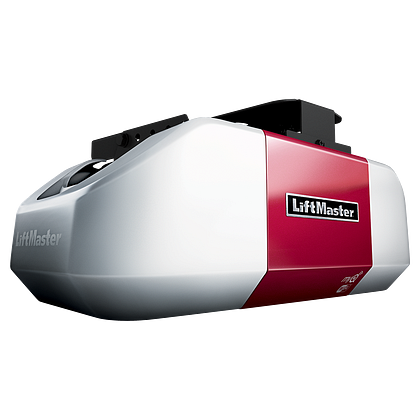
You may wish to choose your garage door opener by brand. At Best Overhead Door, we have all the top brands, including LiftMaster, Chamberlain and Genie. An important feature to look for when considering models is if they include a battery backup option. This way you can ensure your garage door continues to operate even during power outages.
For an estimate on a new garage door opener for your home or business in the Portland Metro or Vancouver, WA, areas, contact Best Overhead Door now.
Related Posts
How to Choose a Garage Door Dealer
Can Your Garage Door Be Hacked?
How Do Garage Doors Improve Home Safety?
Can Your Garage Door Be Hacked?

Your garage door is a major entry point into your home, so it is only natural to wonder — can garage doors be hacked? Are garage door openers secure? You may have heard stories about criminals using loose garage door opener remotes to get into unsuspecting people’s homes. If this is true, what can you do to stop your garage door from being hacked?
Can Garage Door Openers Be Hacked?
The truth is that if you have an older garage door, it can indeed be hacked. The original mechanism for garage door openers was a series of dipswitches set in random directions. This created a unique code that the garage door opener would respond to when a remote with the corresponding code was activated. The problem was that this type of system was child’s play for a criminal to hack. They could do this in many ways. Another common way is for a thief to break into your car and to use the remote on your visor. If you park outside, either lock your remote in the glove box or buy a mini remote that you can leave on your keychain.
They could use a brute force approach, or simply driving through a neighborhood with a remote set to a particular code and firing it at every door until they found one that opened. Or, they could use a “code grabber,” a small electronic device that would allow them to intercept a remote’s signal and steal the code for their own use to open the garage door at a more convenient time — for them, not for you. So how can this type of garage door hacking be prevented?
Modern Garage Door Openers and the Rolling Code
Fortunately, if you have a new garage door opener, you don’t have to worry about it. Eventually, garage door opener manufacturers caught on to the fact that criminals were having a very easy time bypassing their system and getting into people’s homes through their garage doors, so they invented what is called a rolling code system.
The rolling code system or LiftMaster’s® Security+ 2.0®, safeguards garage access with every click, a new code is sent to the Garage Door Opener, ensuring the door does not inadvertently open. Along with the built-in PosiLock® that electronically protects against forced openings and they Alert-2-Close, signals when a door is being closed by MyQ®, will assure you the safest garage door opener on the market. If you have a keycode, that stays the same unless you change it. This renders the code grabbers and loose remote brute force approach useless because even if a criminal got the correct code, it would be different the next time they tried to use it.
Upgrade to a Security+ 2.0 Garage Door Opener Today
If you have an older garage door opener without a rolling code system, you are vulnerable. Fortunately, if you are in the Portland, Oregon, metro area or the Vancouver, WA, area, Best Overhead Door can help. We have a wide range of high-quality garage door openers with reliable security systems based on rolling codes. We also offer smart garage door opener technology, like LiftMaster’s MyQ® system, which allows you to control your garage door from anywhere you can get a wireless signal. It also alerts you whenever anyone opens or closes your garage door at any time for added safety and security.
For an estimate on a modern, safer, rolling code garage door opener, contact Best Overhead Door now.
Related Posts
How Do Garage Doors Improve Home Safety?
Do Garage Doors Need to Be Inspected?
Does My Garage Door Need Regular Maintenance?
Does My Garage Door Need Regular Maintenance?

Many homeowners choose to forego routine inspections and maintenance for their garage doors because they can function many years without noticeable problems. This lack of maintenance can lead to inconveniences, like being stranded inside or outside of your garage — and can lead to costly emergency repairs or frequent technician visits. As the primary entrance for most homes, the garage door is estimated to operate over 1,800 times per year for average homes.
To ensure your garage door is always in top-notch condition, garage door professionals recommend having a garage door tune-up at least once per year. Having regular garage door maintenance can improve safety conditions, reduce repair costs and increase the life expectancy of the garage door opener and garage door parts and hardware.
Best Overhead Door Preventative Maintenance
When you trust the trained professionals at Best Overhead Door, LLC for your annual routine maintenance, you’re guaranteed affordable and comprehensive services that will keep your garage door in safe operational condition. For our customers, we offer a special annual garage tune-up rate of only $79 — which is much less expensive than having emergency repair services performed. When our technician visits your home, they’ll perform the following checks:
- Look over the spring system and assess signs of excessive wear or rust.
- See if the springs have relaxed over time and need to be re-tensioned.
- Tighten nuts and lags or other hardware.
- Remove excess debris buildup from the photo eye sensors and tracks.
- Align the tracks, ensuring they’re straight and tight.
- Apply grease or lubricant to moving parts.
- Inspect cables, drums, shafts, bottom fixture, bearing plate and spring anchor attachment.
- Perform a 25 Point safety inspection on the door and 21 point safety inspection on the opener.
After performing a check on all systems and hardware, our technician will put your garage door through an additional cycle, noting any obvious signs of needed repair. Also, during these checks, your maintenance professional will make any necessary repair recommendations to ensure the safety and proper operation of your garage door.
Homeowner Garage Door Maintenance
When you’re between annual maintenance checks, you should be paying attention to your garage door’s daily operations and noting any unusual garage door behavior or noises. As a homeowner, you should note the following:
- Debris buildup: With access to the outside, your garage door tracks and photo-eye sensors can accumulate excess dirt and debris buildup, which can impact proper garage door functions.
- Parts maintenance: As the door moves, parts can become loose or lose lubrication. As needed, make sure to tighten or replace any loose or missing parts and keep the chain and springs well-lubricated to prevent rust buildup.
- Unusual noises: Note if your garage door begins making loud noises aside from the normal operating sounds, such as rattling, grinding or shaking.
6 Benefits of Regular Garage Door Maintenance
You receive numerous benefits when you schedule regular garage door maintenance. Here are the top six benefits:
- Prevents significant repairs: Routine door maintenance can help you avoid major repairs. Service technicians can detect minor problems and provide a repair solution before they become significant. Addressing these problems early saves you money in the long run.
- Maximizes your door’s life span: A garage door can last a minimum of 15 years with proper maintenance. Maintaining your door ensures you get the maximum amount of years from it before you must replace it. When you repair the minor issues, you keep it in good condition.
- Ensures everyone’s safety: Broken garage doors can cause injuries if they become stuck or fall. Routine inspections can detect any problems that would cause your door to break before it happens.
- Enhances security: Most homeowners use their garage as the main entrance to their home because it’s more convenient. But, if your door malfunctions, it can serve as an entry point for intruders. You can enhance your garage and home security by maintaining your door’s functionality.
- Keeps your system updated: Technology is constantly evolving and improving. You can incorporate these new features into your system to prevent intruders and system breakdowns.
- Increase your home’s value: When you have a well-maintained garage door, it increases your property’s curb appeal and value. You can preserve your door’s aesthetics by addressing scratches, dents, fading paint and other issues as soon as possible.
How Often Should You Service Your Garage Door?
As long as your garage door is functioning correctly and you haven’t noticed any issues, an annual maintenance visit is all you need. However, once you notice any problems, you should schedule repair services. Some signs that your door needs repairs include the following:
- Your door won’t open or close: When your door won’t open or close or only does it halfway, it may have a part that needs replacing.
- Your door is making unusual noises: If your garage door makes loud, odd noises, it needs repairs.
- Your door is off-balance: A sagging garage door or one that closes unevenly can indicate that it’s off-balance. You can test your door’s balance by turning the opener off and manually opening or closing the door halfway. If the door continues moving up or down after you let go, it’s off-balance and a professional needs to inspect it.
- Your door has a slow response time: It should only take a few seconds for your door to open or close. If your door appears to be straining or taking longer than usual to open or close, contact a professional to diagnose and solve the issue.
- Your door comes off its tracks: The rollers allow your door to open and close smoothly. If they come off the tracks, it will be dangerous and difficult for you to operate your door. If your garage door is off track, do not operate it and call a service technician immediately, as the door may pose a safety risk.
Call Best Overhead Door for Your Annual Tune-Up and Other Repair Needs
To keep your garage door in proper working condition, call the experts at Best Overhead Door to perform your routine garage door maintenance. We have nearly 30 years of garage door installation, repair and maintenance experience and guarantee all of our customers throughout Portland, OR, and Vancouver a hassle-free, reliable, affordable and friendly experience. To schedule our annual maintenance services, fill out our online form or call us at (503) 620-1205 to set an appointment with one of our team members.
In addition to annual maintenance, Best Overhead Door can repair or replace your garage door. We can service all parts of your garage door, including the springs, cables and the opener. When you entrust us with maintaining the condition of your door, you can be confident that we will keep your door in excellent condition and ensure everything functions properly.
To schedule our annual maintenance or other repair services, fill out our online form or call us at (503) 620-1205 to set an appointment with one of our team members.
Related Posts
Do Garage Doors Need to Be Inspected?
How to Tell If Your Garage Door Springs Are Broken
How To Tell If Your Garage Door Hinges Wear Out
Benefits of a Custom Garage Door

When you have the right type of garage door, utilizing the latest designs and features, you can add to your daily productivity, add curb appeal and home value. Most homeowners opt for a standard garage door to simply get the job done: reliably opening and closing the garage as they come and go.
Findings in REMODELING magazine’s 2018 Cost vs. Value Report show that replacing a garage door not only improves a home’s curb appeal, the project generates the best return-on-investment (ROI) when it comes to recouping cost at resale. The report indicates that spending $3,470 for an upscale garage door replacement can yield an estimated $3,411 at resale – a 98.3 percent return on investment.
With a custom garage door, you can achieve that high return and let your home positively stand out in your neighborhood. Benefits of a custom garage door also include:
- Size Options: With stock doors, your garage has to adhere to the available garage door sizes. But custom doors can be manufactured to fit any size or shape. Your door can be fitted to allow for extra storage or be crafted large enough to let a recreational vehicle maneuver in and out of the garage with ease.
- Design and Material Flexibility: While white, aluminum or steel garage doors are traditional and help your home blend in, a custom door can be manufactured from wood or steel and designed with custom colors, hardware and styles to help your home be bold and stand apart. With Clopay® customization options, you can craft a stunning wood door with Knotty Alder, Spanish Cedar, White Oak, Ironwood or African Mahogany, incorporating windows if desired and available in seven popular stains and colors.
- Added Insulation: Garages aren’t typically constructed with the same insulation requirements as living spaces, so precious heat or cool air can easily escape through your garage door, costing you extra in monthly bills. Standard garage doors are flimsy aluminum-wrapped panels that don’t feature added insulation. With Clopay custom garage doors, each is hand-crafted with four or five-layer construction and is insulated with polystyrene.
- Warranties: Most custom garage doors will feature warranties or guarantees from the installation and manufacturing companies. Many garage installers will offer guarantees on workmanship or labor to perform future repairs as needed. At Clopay, they’re proud of their work and stand behind it by offering a five-year construction guarantee, a two-year warranty on stains and a one-year warranty on paint for all of their custom garage doors.
- Unique Opening Mechanics: Did you know that you can have your garage door open on a different mechanical lift — having the door open like an airplane hangar or swing open vertically? Most standard doors are limited to running on a single track, while custom doors can operate with a bit of added flare.
Design and Install a New Custom Garage Door With Best Overhead Door, LLC
To fully revamp the exterior of your home, invest in a new custom Clopay door. With the help of the design specialists at Best Overhead Door, any design you dream up can be fully executed and hand-crafted by artisans at Clopay using the finest materials. For nearly 30 years, Best Overhead Door has been the premier garage door company in the Portland Metro area and Vancouver, WA — achieving superior quality and service results for all of our garage door products. To begin designing your custom garage door today, speak to one of our specialists at (503) 620-1205 or complete our online form to schedule a consultation.
Related Posts
How to Choose the Perfect Garage Door for Your Home
How to Paint & Maintain Your Custom Carriage House Garage Door
Home Improvement Projects With the Best ROI
What to Do if Your Garage Door Is Off-Balance
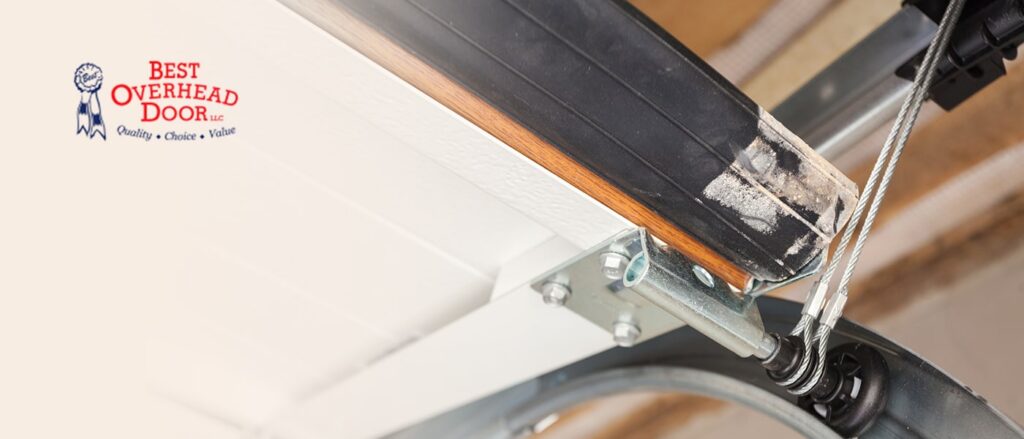
Garage doors were created to have even and smooth operations when opening and closing, but too often, due to lack of proper maintenance and spring wear, garage doors can become off-balance. The balance of your garage door is managed by the tension of torsion or extension springs. These springs make raising and lowering garage doors easy. When a garage door is off-balance, it means the springs either don’t have enough tension to counterbalance the door’s weight or they are exerting too much pressure.
The garage door opener strains when it is off-balance, which will drastically shorten its life. Operating the door when it fails or the power goes out can also be hazardous. This can cause serious injury or death. Signs your garage door is off-balance include:
- Door closes hard
- Odd sounds may happen during the operation
- The garage door takes a long time to open or close
- The garage door won’t open at all
- There is visual sagging on one side of the door
Performing a Balance Test
If you’re unsure if your garage door is balanced, there is a simple test you can perform to evaluate the quality of your door:
- Close the door from the inside.
- Detach the garage door from the opener using the red manual release rope.
- Move the door open and closed manually.
- Then lift the door halfway and release. If it stays in one place, it is properly balanced. If it closes or snaps open, the door is off-balance.
What Can Cause Your Garage Door to Be Off-Balanced?
Over time, general wear and tear have an effect on your garage door’s springs. Factors that might damage your springs are weather, lack of lubrication and dust or dirt. Your garage door could also be off the tracks, or there may be an issue with the springs. When the garage door moves, the springs must adjust to balance the weight. If they don’t, this will cause your garage door to be off-balance.
If one spring is damaged or becomes loose, that side of the door will not be in-balance, causing the two sides to move at different speeds. You will hear a noise when this starts to happen. The more they are out of sync, the more noise it often makes.
If you start seeing the signs of wear and tear on the springs, it is a good idea to replace them as soon as possible, before the springs break. The best method to realign garage doors is by calling in a professional. These springs are under a lot of tension, so they require expert skill to replace or adjust.
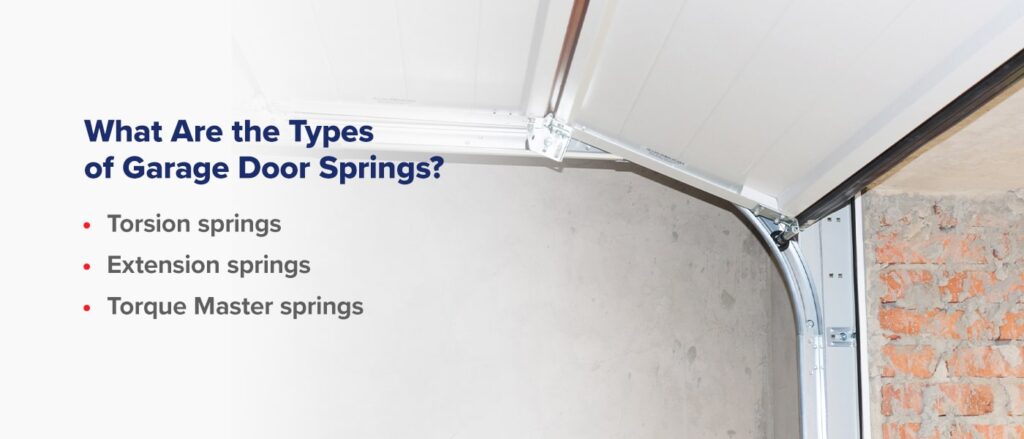
What Are the Types of Garage Door Springs?
There are different types of springs, depending on what kind of door you have. But we can break them down into three main types:
- Torsion springs: This type of spring is generally best suited where torque is applied from two directions. A clothespin also has a torsion spring. Although these are a lot smaller, the principle is the same. A garage door torsion spring is usually located at the top of the door.
- Extension springs: The extension springs are located on both sides of the door and are responsible for the balance. They stretch and shrink depending on the weight of the door. Not all garage doors have them, but most residential ones do. The springs are coiled up, and they have a hook or loop on both ends. Variations of them are also commonly used on trampolines.
- Torque Master springs: The Wayne Dalton garage door has a spring inside a tube above the door when it is closed. These springs are made exclusively by Wayne Dalton for their garage door range. The spring is used for safety purposes to prevent the door from dropping uncontrollably.
Performing a Balance Test
If you’re unsure if your garage door is balanced, there is a simple test you can perform to evaluate the quality of your door:
- Close the door from the inside.
- Detach the garage door from the opener using the red manual release rope.
- Move the door open and close it manually.
- Raise the door halfway and release it. If it stays in one place, it is properly balanced. If it closes or snaps open, the door is off-balance.
When the Garage Door Is Off-Balance
After performing a balance test at home and finding the door is unbalanced, you should call a professional garage door repair company immediately. Do not attempt to try using the garage door until the balance is fixed to avoid unnecessary opener or part breakages. Also, it is not recommended for homeowners to attempt repairing the garage door springs.
As you learned, different types of springs are responsible for raising and lowering your garage door — extension and torsion springs are the most common. Extension springs are considered the more dangerous of the two because they can snap and become dangerous projectiles. You’ll find these springs on the side of the door running along the tracks. Torsion springs will be running horizontally above the door.
Regardless if the issue is caused by your torsion springs or your extension springs, a professional is the best option when a garage door needs fixing. They have the tools, equipment, and knowledge to safely remove and replace your garage door springs. With an off-balance garage door, other components might also be damaged, and a technician will be able to quickly identify and repair those parts.
Risks of Not Fixing an Off-Balanced Garage Door
Once the springs start to deteriorate or one component has an issue, a chain reaction occurs. To compensate for the worn part, the rest of the mechanical components in your overhead door opener take the strain. Eventually, whole sections will need to be replaced instead of just one item.
The strain can also cause the door to act erratically and even drop when you least expect it. This can be dangerous if there is anything or anyone under the door when this happens. The best advice is to call in a professional as soon as you notice any signs of damage or strain on the door.
Call the Experts at Best Overhead Door, LLC
If you’re ever unsure about your garage door repairs, rely on the proven experience at Best Overhead Door. For nearly 30 years, we have safely, affordably and reliably fixed and installed garage doors throughout Portland, Oregon, and Vancouver, Washington. For all of our customers, we even offer emergency after-hour services in the following areas:
- Beaverton, Oregon
- Lake Oswego, Oregon
- Portland, Oregon
- Sherwood, Oregon
- Tigard, Oregon
- Tualatin, Oregon
- Wilsonville, Oregon
- Vancouver, Washington
We can visit your home, chat on the phone or have a video conference if you prefer. To streamline the process for you, we even bring our showroom to you with samples and brochures and can offer a free estimate.
In addition to our repair expertise, we also offer a wide selection of high-quality Clopay® garage doors designed with the best materials available and tested to withstand variable climates and conditions. To learn more about our maintenance plans or schedule services, complete our online contact form or call us at (503) 620-1205 to speak to a specialist.
Related Posts
Do Garage Doors Need to Be Inspected?
How to Tell If Your Garage Door Springs Are Broken
How To Tell If Your Garage Door Hinges Wear Out
How Often Should Your Garage Door Be Serviced?
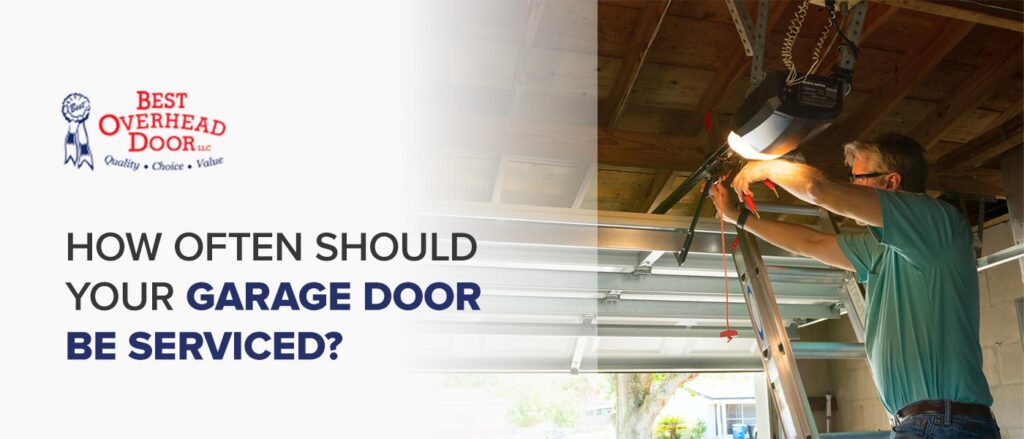
Your garage is most likely the primary way your family enters your home — homeowners use their garage door 1,500 or more times per year. Most homeowners make the mistake of only having their garage door inspected when a part or component breaks. To keep your garage door in proper working condition, professionals recommend having regular garage door service on your door once every year.
Benefits of Regular Garage Door Maintenance
Regularly scheduled maintenance for your garage provides numerous benefits to ensure this convenient feature lasts.
Cost Efficiency
Your garage door will most likely show signs of use years after installation. You may notice more minor issues such as loud creaking or the pin pad not working. These smaller problems are routine for technicians and typically take only a few hours to fix.
When you regularly schedule residential garage door maintenance checks, professionals can assess these problems and look for any potential significant issues from your garage door. Fixing these complications now saves you a considerable amount of money down the road when they turn into much more significant matters without the proper care. Schedule regular maintenance to save money by avoiding having to replace your entire garage door.
Appearance
Regular residential garage door maintenance can restore your garage door to look brand-new. With every annual tune-up, your garage door gets a refresh as technicians make necessary repairs and replacements. Professionals can also ensure your sensors are clean enough to continue working.
Home Value
A well-maintained garage door can increase the value of your home. If you plan to move in the next few years, you can benefit from regularly scheduled door maintenance appointments. These technician visits allow your door to undergo significant and minor repairs that enhance its appearance and mobility. These changes can extend the door’s life, making your home more desirable for potential buyers.
Security
Any technician’s top priority during a maintenance appointment is ensuring that a garage door provides as much safety as possible. Since families use garage doors as entrances to their homes, safety features are crucial at all times.
During a regular maintenance visit, professionals check the tracks that attach the door to the inside of the garage. They assess that the tracks fully support the weight and motion of the door so it will not become uneven over time. These steps ensure you and your family are safe as you pass through the garage threshold daily.
Annual Garage Door Tune-Up
When you call the professionals at Best Overhead Door for your annual maintenance check, we’ll send a trained and knowledgeable technician to your home to perform a visual inspection. They will have your garage perform a cycle to check for any obvious signs of wear or damage. After seeing a cycle, the technician will clear dirt and debris from the photo eye sensor or in the rollers and tracks that can prevent proper door functionality.
At this time, the technician will inspect all parts for signs of excessive wear and tear, tighten any loose lags, screws or nuts and adjust any misaligned parts.
These garage door parts include:
- Sections
- Garage door springs
- Tracks
- Cables
- Bearings
- Rollers
- Drums
- Spring anchor bracket
- End bearing plates
- Center bearing
- Hinges
- Torsion tube
- Top and bottom fixtures
- Horizontal and vertical tracks
Our annual maintenance includes properly lubricating all moving parts and checking the balance and operation of the garage door. Then we test the garage door opener and adjust the limits and force settings as needed while performing a safety check making sure it will be trouble-free for a long time.
A garage door annual maintenance contract is excellent for gaining peace of mind.
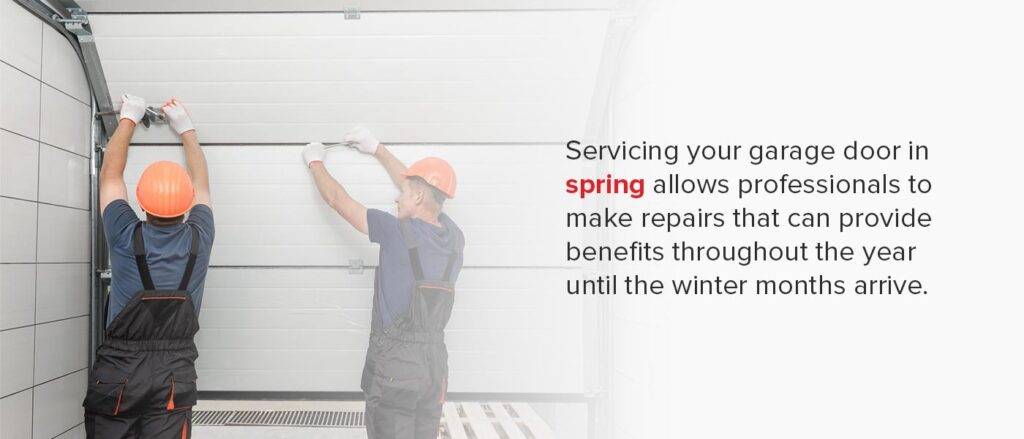
When Is the Best Time to Service Your Garage Door?
After the harsh cold of the winter seasons, you can start to schedule garage door services in spring. These warm months with longer days give technicians more time to assess any repairs or maintenance your door needs after handling months of heavy snowfall.
The environment can have a lasting impact on the longevity of your garage door. Servicing your garage door in spring allows professionals to make repairs that can provide benefits throughout the year until the winter months arrive. You can then start the cycle of regular maintenance. But if you notice any concerns with your garage door any time of year, it’s best not to wait to schedule maintenance services.
What to Look for When Checking Your Garage Door
During your annual maintenance visits, you should listen and note any unusual garage door sounds or mishaps. As a homeowner, look for and perform the following:
- Unusual sounds: While doors can be noisy, note if your door is making odd sounds like creaking, rattling or grinding.
- Door balance: Disconnect the door from the opener and see if it will stay halfway open by itself. Only a professional should make a spring adjustment.
- Debris buildup: As needed, remove dirt and buildup from your tracks and rollers.
- Lubricate Parts: Keep the garage door opener chain or screw, bearings, rollers, hinges and springs well-lubricated to ensure proper functionality and prevent rust buildup.
- Tighten hardware: As the garage door moves, parts can become loose or fall out. Check hardware and tracks occasionally to ensure nothing needs tightening.
- Maintain door quality: In addition to a reliable garage door, you also want to maintain the look of your door. For wood doors, check them often for water damage and warp. Also, look for cosmetic fixes like chipped or peeling paint. If you have a steel door, look for rust that can be sanded, primed and painted. As needed, wash the garage door with a mild, all-purpose cleaner.
For Your Annual Garage Door Service, Trust Best Overhead Door
To guarantee your garage door is continuously operating smoothly, trust the professionals at Best Overhead Door, LLC with your annual garage door tune-up. Our company has over 30 years of experience repairing and maintaining garage doors for residents in the Portland Metro area and Vancouver, WA. For our customers’ convenience, we also offer emergency 24-hour services. Schedule your garage tune-up today by completing our online form or calling us at (503) 620-1205.
Related Posts
Does My Garage Door Need Regular Maintenance?
Do Garage Doors Need to Be Inspected?
How to Paint & Maintain Your Custom Carriage House Garage Door
Do Garage Doors Need to Be Inspected?

For most of us with garages, the only time we give much thought to our garage door is when it breaks down. As long as it is opening and closing on command and not making an excessive amount of noise or behaving erratically, we assume everything is fine. But do garage doors need to be inspected? The answer is yes, and here’s why.
The Importance of an Annual Garage Door Safety Inspection
A garage door system has many moving parts, and moving parts are designed to wear out. Even if your garage door seems to be working fine, you could have a worn-out torsion spring, frayed cable or another failing part, which could be an accident just waiting to happen. If you have a situation where some part of your garage door system snaps while you’re using it, it could create a safety issue. Checking warning labels on your garage door is a great first step to keeping your garage door operating properly, but a professional inspection is the best way to make sure your garage door is ready for the upcoming seasons.
With an annual inspection, we can identify any worn-out or failing parts and replace them before they become a serious problem. This could potentially help you avoid a very costly repair that could follow should those parts fail suddenly and without warning.
Regular garage door maintenance can also help extend the life of your door. Garage doors that are improperly maintained have to work harder, putting more stress on the system and shortening its lifespan.
How often do garage doors need to be serviced? It couldn’t hurt to call for a maintenance inspection at the beginning of every season, but you should at least call for a professional maintenance check once a year.
Signs You Made Need a Garage Door Inspection
Often, your garage door will “tell” you something might be wrong. It’s better to have a professional service technician check out the issue before it becomes a significant and expensive door repair.
Examples of the many signs that call for an inspection include:
1. Unusual Noises
Your garage door will make “normal” mechanical sounds during opening and closing. However, if the noise is louder than usual or you hear popping, groaning or grinding, it could indicate a problem that requires further investigation.
2. Failure to Open or Close Completely
If the door gets stuck during raising or lowering, there could be a problem with the track, springs or alignment that needs attention.
3. Slow Movement
Is your garage door opening faster or slower than usual? This likely means that key components like the rollers, tracks or hinges need oil. Lubrication is part of the annual inspection and service process. However, you may need to do it sooner if you’re experiencing performance issues.
4. Reverses Direction
Garage door systems have a built-in safety mechanism that causes a closing door to reverse direction when encountering an object in its path. If your door suddenly changes direction when nothing is blocking it, there could be a problem with the motion sensors that trigger this feature. A service technician can get to the bottom of the issue.
5. Rusted Springs
The springs play a crucial role when raising or lowering a garage door. As they age, they can develop rust that impacts their performance and makes them unsafe. An overhead door inspection will reveal the extent of the damage and whether it’s time for a spring replacement.
6. Crooked Appearance
Does your door look crooked or uneven? It could mean that one of the cables has loosened from the drum. This can occur due to the door opening or closing too quickly, which could result from a malfunctioning opener, or if it strikes an object during operation. A garage door professional can perform a drum inspection and pinpoint the exact cause and remedy the situation.
Best Overhead Door for Annual Garage Door Maintenance Inspections in Portland, OR, Vancouver, WA, and the Surrounding Areas
Because we want your garage door to operate safely and efficiently at all times, we offer a very affordable annual garage door inspection and tune-up. When we get to your house for your tune-up, we will take you down through our complete garage door inspection process and general garage door safety for homeowners.
Our Garage Door Saftey Inspection Checklist includes:
- Re-tensioning your torsion springs
- Tightening any loose nuts or other parts
- Clearing any debris from your rollers
- Tracks or under the door
- Lubricating all moving parts
- Making sure your door is properly
- Aligned and adjusted
- Inspecting all parts for wear to see if they need replacement
- Checking the surrounding component for safety hazards
- And more!
We will also perform a garage door opener inspection to make sure it is adjusted correctly as well as your photo eye sensor system to make sure it reverses in response to an object under the door to avoid damage or injury.
Once we make sure your door is in optimal working condition and have installed any replacement parts you may need and request, we can give you tips on how to maintain your garage door health yourself so it lasts for years to come.
If you haven’t had a tune-up or inspection of your garage door in over a year, there’s no time to waste. Contact us at Best Overhead Door to request an inspection/tune-up appointment today.
Related Posts
Can Your Garage Door Be Hacked?
Does My Garage Door Need Regular Maintenance?
How to Choose a Garage Door Dealer
How to Paint & Maintain Your Custom Carriage House Garage Door
Instructions for Painting and Maintaining Your Best Custom Wood Carriage House Doors
To the Homeowner:
Please note that our custom wood doors are made to our high standards with top quality products. We DO NOT provide a finish on our custom wood doors. The finish warranty is the responsibility of the painting company you choose and the finish should match the quality of our doors to maintain the beauty and integrity of your investment. Below are instructions that we recommend to you, the homeowner, to pass on to your painting contractor. We recommend that you NOT use dark stains or colors. These absorb heat and can cause excessive cracks and bows in the wood.
Warranty:
Best Overhead Door, LLC warranties our custom wood doors for one-year parts and labor. We DO NOT warranty the finish. That is the responsibility of the company YOU choose to finish your door. We require that each custom wood door is completely finished to the standards below before we will install the door. Not doing so voids the warranty on the door entirely. Delays in finishing that allow the wood surfaces to be exposed to moisture or contaminants, improper storage or transportation or allowing the surfaces to be damaged or exposed will void the warranty.
Some coatings are NOT recommended. Oil paint, Alkyd paints, Wood Shake or Wood Shingle paints, Vinyl acetate acrylic co-polymer, Vinyl acetate (PVA), or Vinyl Acrylic paints.
Preparation:
Preparation is a critical step when you paint a garage door. Whether or not you know how to repaint a garage door, before you start, all surfaces must be clean and free of any dust, oil or other contaminants. Any scars, scratches, etc. that occur while the doors are transported or after storing or handling must be properly sanded out to the original condition. A light sanding of all surfaces with a very fine grit sandpaper is recommended to ensure the best finish possible. If you try to repaint a garage door without the proper preparation first, the paint will not go on evenly and will not look right.
Priming:
All surfaces must be primed before applying the finish coats. These include the interior and exterior surfaces and all edges, six (6) surfaces in all. Certain woods require special primers/paint to prevent tannin stains from bleeding through the finish coats.
Please consult with your painter or paint company when selecting your paint products for the appropriate products. Remember, you have an exceptional door that deserves an exceptional finish. It may be tempting to attempt to paint without priming, as it can be very time-consuming, but there is no point in trying to refinish a garage door without priming first. The paint may not adhere to the door, and you may damage the surface of the door in some cases as well.
Painting:
Painting is the most important stage of this process, so it’s important to take great care to make sure you do it correctly. We recommend a high-quality exterior grade 100% Acrylic Latex finish Paint. Apply primer. Then apply an exterior grade, paintable clear caulk around the edges of all trim boards. Then, apply 2 (two) finish coats according to manufacturer’s label and allow proper drying times between coats. Please follow the paint and primer manufacturer’s label instructions exactly. Both your paint supplier and your garage door dealer can help you determine the right color and type of paint for your garage door. Make sure you have a paint you are confident you will be happy with so you will get the custom garage door you want in the end.
Finishing with Stains or Clear Coats:
Even if you know how to refinish a garage door, you’ll want to take special steps if you are using stain instead of paint. This is because you may find using the wrong stain can be a problem much more difficult to correct than using the wrong paint. For stains, select stains that are appropriate for the type of wood used for your door. Be sure to consult your painting professional or supplier to determine if the stains and varnishes are compatible with the woods used. First, stain all 6 surfaces of each panel (if using a stain) and allow proper drying time according to manufacturer’s specifications. After staining add an exterior grade, paintable clear caulk around the edges of all trim boards. Then apply the first coat of varnish to the outside and edges of each section and allow recommended drying time. The back of the door panels does not need to be. This allows the door to “breath” should any moisture get into the door. Varnish should be Exterior Alkyd type (Marine type varnish). Sand all varnished surfaces and edges with 320 grit sandpaper (smooth face finish only) and clean all dust from the door. Apply the second coat and allow the door to dry according to manufacturer’s instructions. Doors are ready to hang. If NOT using a stain, apply a third coat of varnish and allow the door to dry. Doors are now ready to hang.
How to maintain and refinish your wood door:
Please annually inspect your door. This inspection includes all surfaces and moving parts. Improperly aligned rollers or tracks need to be repaired to help avoid wear on the wood surfaces that will affect your door. If repainting your door, you will need to have the surfaces sanded and re-primed following the same steps as listed above. If your door is stained and varnished or varnished only, the steps needed depend on the wear shown. Please consult your painting professional or paint company and follow the steps recommended by them. Following these steps can greatly extend the service life of your custom wood door and help maintain the beauty of your home’s exterior. If you’re not sure when to refinish a garage door, you can always consult with your local garage door dealer, who is likely to have experts on staff who can advise you. Generally, it is a good idea to refinish whenever you notice significant wear on your garage door surface.
For More Information, Contact Best Overhead Door Today
Best Overhead Door has decades of experience providing garage door service in Oregon, and we urge you to take advantage of our knowledge. When you order a high-quality Clopay® garage door from Best Overhead Door, we can customize it so it comes in the right color or stain to match your home’s exterior décor and/or your overall style.
Over time, however, that finish may wear down and require repainting to protect your garage door and restore a cohesive, appealing look to your home’s exterior. If you have any questions on how to get a new Clopay garage door or how and when to refinish your current door, give us a call today at (503) 620-1205 or contact us online now.
We are available for emergency and 24/7 calls at (503) 707-0848. You can also schedule service or request an estimate online. We serve the Portland metro area as well as Vancouver, WA. We look forward to helping you with your garage door needs.
Related Posts
Home Improvement Projects With the Best ROI
Does My Garage Door Need Regular Maintenance?
Benefits of a Custom Garage Door
How to Choose a Garage Door Dealer
How to Choose a Garage Door Dealer
There are a variety of sources you can turn to to purchase or obtain garage door products, the most popular of which is the door dealer professional, such as an International Door Association (IDA) Dealer. IDA Garage door dealers are often the most reliable and dependable source for several reasons. These include experience, knowledge and – most importantly – the fact that IDA Dealers make their living by selling, installing and servicing door systems.
Safety: A Primary Concern
A garage door is often the largest moving object in a home or commercial business facility. An improperly installed door and operator system can exert tremendous force when the door closes. This could lead to the entrapment of children or adults and subsequent injury – or worse. Therefore, selecting the right person to install and service your door and/or operator is an extremely serious decision. It is not one that should be taken lightly!
Selecting Your Dealer
There are thousands of door dealers in business today. What can you do to assure yourself of selecting the right one? We’ve provided these five checkpoints for you to use:
- Experience
Experience is a simple way to identify a garage door dealer you can trust to provide you with the right garage door. A garage door dealer that has been in business for decades has the technical knowledge and experience needed to ensure your garage door is installed and functioning properly. Of all the five checkpoints, this is perhaps the easiest to validate. How long has the company been in business? If a new company, do the principals have experience in the door and operator industry? How much?
- Workmanship
This may be the most important checkpoint. And it is also easy to verify. Does the door dealer have satisfied customers? If so, do they have letters of recommendation from their customers? Depending on the project, you may want to talk to a customer or two. If you look online and can’t find any positive testimonials about this dealer, it’s not necessarily a red flag as some companies don’t feature testimonials on their website. However, if the dealer cannot put you in touch with any satisfied customers, that’s probably a sign you should look somewhere else.
- Code and Regulatory Compliance
There are numerous requirements pertaining to safety and the installation of a garage door system. Federal, state, and local codes and regulations must be followed. Ask the dealer you select about how they comply with the codes in your city. This one is a deal breaker. Federal, state and local regulations are created for the safety and protection of homeowners and should be followed at all times. If your dealer cannot show that they comply with all federal, state and local regulations, you should walk away immediately.
- Insurance Coverage
It is important to you that the door dealer carry proper insurance on their business and employees. One checkpoint is to ask for a copy of the company’s Certificate of Insurance. If they don’t have one or hesitate to comply with your request, it could be a negative signal. If the dealer tries to explain to you that they are not required to carry insurance for some reason, it may be best to walk away. Whether there is truth to that or not, you can generally expect that most reputable garage door dealers will carry the proper insurance and would be willing to comply with your request.
- Financial Integrity
Depending on the size of your project, financial integrity of a door dealer can be very important. Although this is a sensitive issue, a dependable, honest door dealer won’t mind telling you about the basic financial integrity of their company. The important thing is transparency. While you shouldn’t necessarily expect a garage door company to open their books for you, they should still be open and honest about most matters. If you’re not comfortable with the way your dealer behaves or responds to your inquiries, go somewhere else.
Selecting the right door dealer is as simple as asking a few questions. The most important deals with the issue of reliability. Is the dealer dependable, trustworthy, and safety-conscious? These questions take only moments to answer, and yet they can help you avoid tremendous problems in the future.
Choose Best Overhead Door for Garage Doors in Oregon
If you’ve been looking for garage door dealers in Tualatin, Oregon, or surrounding areas, Best Overhead Door has everything you need. With over 30 years of experience and countless testimonials from satisfied customers, you can be confident you’re choosing a garage door dealer you can trust. In addition, Best Overhead Door is a Clopay® Master Authorized garage door dealer.
Many consider Clopay garage doors among the top garage doors in the country for their attractiveness, durability and style, and Best Overhead Door has a wide range of them to choose from. Our installers all go through the same strict training process, so you know we will install your door correctly the first time. If you don’t want to spend any more time worrying about how to choose a garage door dealer in Oregon, contact Best Overhead Door today.
Give us a call today at (503) 620-1205 or contact us online. You can also schedule service or request an estimate. For emergencies or after-hours service calls, please call us at (503) 707-0848.
Related Posts
Can Your Garage Door Be Hacked?
Does My Garage Door Need Regular Maintenance?
How Do Garage Doors Improve Home Safety?
How to Choose the Perfect Garage Door for Your Home
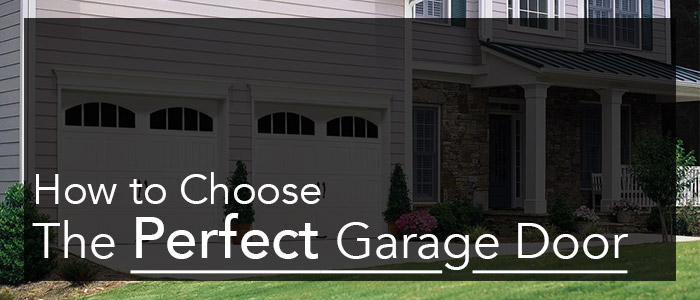
When you envision taking your home’s curb appeal up a notch, chances are you envision a gorgeous, expensive landscape or an upgrade to the front entrance. You may not give much thought to replacing your garage doors, but a recent study proves that might be the first thing to consider. Among all home remodeling projects that cost less than $5,000, replacing garage doors made the top five for having the highest return on investment. In fact, garage doors can increase the total value of your home by 4 percent.
But curb appeal and an increase in your home value aren’t the only two reasons to replace your garage door. If you have living space above your garage, or use your garage as a work or storage space, protection from extreme temperatures and weather conditions is important. Older garage doors, with years of wear and tear, may not be giving you the optimal amount of protection.
Attached garages impact energy costs, regardless of whether your garage is heated or air-conditioned. Replacing your garage door gives you the opportunity to get a sturdier door with a higher level of insulation, or R-value. You’ll also reap the benefits of energy savings from keeping the cold air out in the winter and the cool air inside in the summer. In addition to having an impact on temperature, a new garage door can also do a better job of keeping moisture out of your garage.
In addition to keeping moisture out, new garage doors can also help you keep unwanted visitors out. Research shows 9 percent of burglaries that occur at residential properties in the United States gained access through the garage. Assuming you choose to upgrade your garage door opener along with your doors, you have the opportunity to purchase the latest in garage door security technology, too — choose from keypads, motion sensors and other features that help keep you and your loved ones safe. As a result, your home insurance company may offer a benefit for installing new garage doors with these features.
Garage doors can last 30 years or more if you take care of them properly, so choosing a garage door for your home isn’t something that should be taken lightly. Once you’ve decided this is a project to take on, where do you start? Do you know what to look for in a garage door for your home? We’ve gathered all your tips for choosing the best garage door in this blog post.
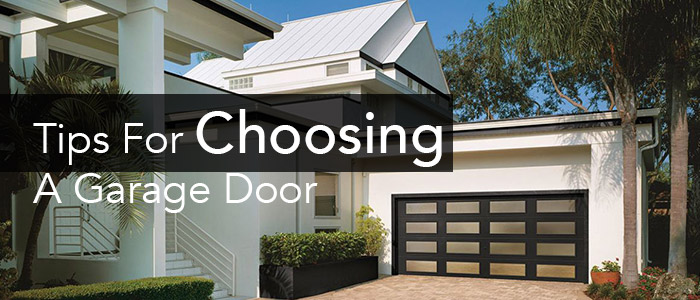
Determine What Size Garage Doors You Need
To determine the size of your door, you must first measure the opening width then the height. If there is a high spot in your floor, you want to measure it at that point as most garage doors are made of steel and need to sit level in the opening. You add different sizes of bottom astragal to help seal the bottom.
If you’re installing new tracks and a new opener, you’re going to need to consider a few additional measurements. On each side of each opening, you need a minimum of 3¾ inches for the vertical tracks. Don’t forget — that means doubling it to a minimum of 7½ inches for any side space between two doors. Then, you need to consider the headspace, or the measurement of the space between the top of the door opening and the ceiling. For a standard track, you need 12” and if you need less, you’ll need a Low Headroom Track (you can get away with as little as 3’). If you have a tall ceiling you may also consider a High-Lift track, where your door goes straight up the ceiling before it turns and goes along the top of the ceiling. This saves space for things like a car lift or even room to make extra shelves for storage.
Lastly, you need to measure the backspace, or the distance between the door opening and the back wall of the garage. This measurement needs to be the height of your garage door, plus 18 inches. Or height of door plus 3’ for a garage door opener.
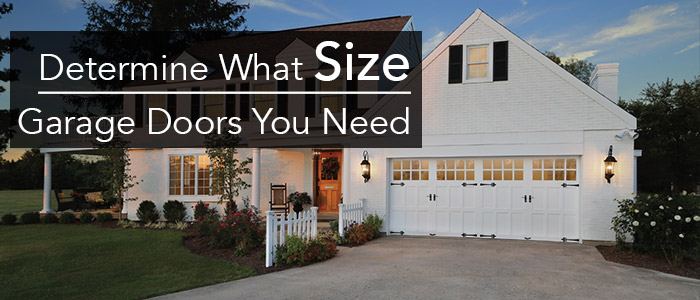
Do I Need an Insulated Garage Door?
The No. 1 reason you use your garage is likely to be “to park my car.” Depending on the additional uses, you may want to invest in a door with more insulation or made of a particular material that will be tough for any intruders to break into.
Consider the following questions: Does your garage double as your workshop? Do you use it for storage? If so, what kind of things do you store? Is it an attached garage? If so, does it double as an entryway? Is it a standalone garage? If so, will it be doubling as a shed to store garden and lawn care accessories? These are just a few things to consider as you’re thinking about the use of your garage space.
In addition, you may live in a very cold or very warm climate where insulation may be important. Insulation in your garage door can help protect your cars and other valuable belongings protected from extreme temperatures. Insulation is especially important to consider if you have an attached garage, as these garages have a significant impact on the energy efficiency of the home. Furthermore, if you have living space above the garage, additional insulation in garage doors can help regulate the temperature in that room without breaking the bank.
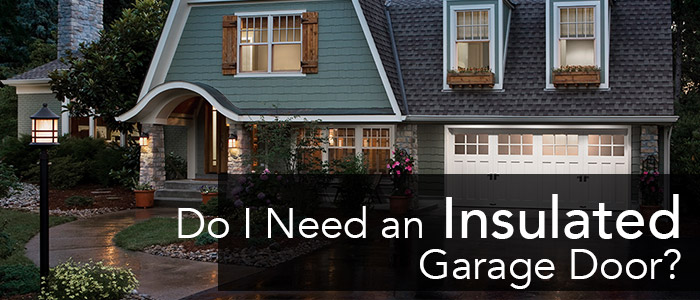
Do You Need a Wind-Rated Door?
Two of the features you’ll want to consider are insulation and stability — specifically, if you could benefit from having a reinforced garage door. If you live in an area where hurricanes are common, your building codes may require you to have garage doors with a WindCode rating. This rating assures you your door can withstand heavy winds and storms, and is less likely to buckle under the pressure of a bad storm. The door and its tracks are made with some additional features that won’t interfere with aesthetics, but will make the garage door more durable in a storm.
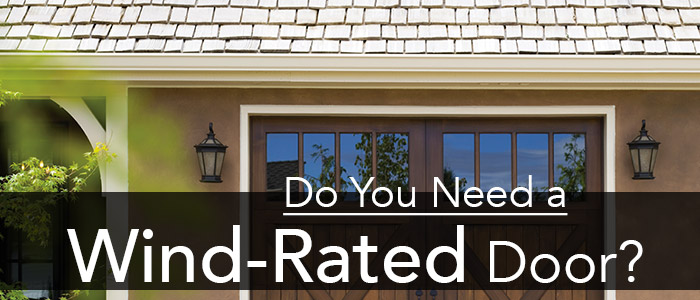
Select a Material
Climate also plays a role in the type of materials that would work best for your garage doors. What are garage doors made of, anyway? You have a few choices — natural wood, fiberglass, steel and composite, aluminum and glass and vinyl. Here is some background information on each of these materials.
- Steel doors are the most popular and come with a variety of styles, insulation, window designs and paint options. Different window placements can make for a great modern look. With the flexibility, you can find a door for every budget. The toughness makes them a great fit for people in areas where high winds or where security are a concern.
- Aluminum and glass garage doors can add a modern flair to your home. Choose from solid aluminum or glass panel doors, depending on the amount of privacy you desire. Resistant to rust and corrosion, these doors are built to last
- Natural wood is a favorite among many. It offers a beautiful, rustic and unmatched appearance. You can even customize a door to fit the look of your home. However, they do require a little more maintenance, as wood is prone to splitting and cracking. Depending on the finish you choose, you may also need to re-stain or repaint after a certain amount of time.
- Fiberglass, on the other hand, is resistant to rust, denting, splitting and cracking and offers durability and a standard level of insulation that’s tough to beat. Unfortunately, with fiberglass, the cost can be quite a bit higher.
- Vinyl garage doors are durable and low-maintenance. They do have some customized styles to choose from. They are every resistant to rust and are a great option for the homes on the coast.
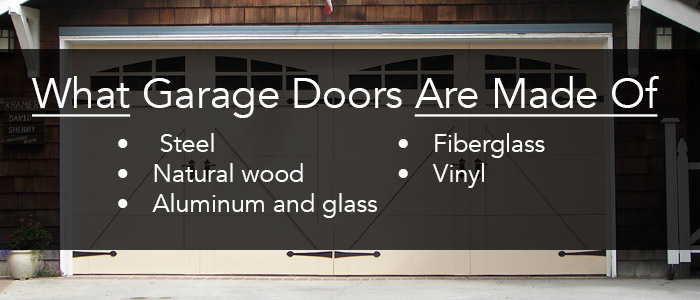
Set Your Budget
Unless you have access to unlimited funds, you’re going to need to set a budget. Try to set a budget range, so you have some flexibility, as your decisions regarding features, materials, insulation, etc., will influence the cost. It’s important to know what you can afford to spend so you can prioritize if you can’t afford to get absolutely everything you want.
Choose From Styles of Garage Doors to Match Your Home
When you’ve reviewed the options of what materials garage doors are made of and have made a choice, it’s time to choose from the many styles of garage doors. While you can choose whatever style garage door you prefer, we recommend choosing one that matches the style of your home.
- Modern home styles look best with modern and contemporary garage doors. These doors usually bring together elements of metal, glass and maybe even wood, to create a fresh, clean, up-to-date look that complements your home. An AVANTE™ or a MODERN STEEL™ door looks great on this style of home.
- Craftsman or mission-style homes, among others, are a perfect match for “barn-style” garage doors, also known as carriage-house garage doors. These doors usually feature windows, and sometimes two-tone paint, as well as unique hardware. The RESERVE® WOOD, CANYON RIDGE®, COACHMAN® or GRAND HARBOR® collections are perfect for this style of home.
- Traditional homes are a perfect match for traditional, raised-panel garage doors. This simple, traditional type of garage door complements a variety of home styles and provides flexibility when it comes to color and insulation options. Try the CLASSIC™ WOOD or CLASSIC™ collection doors for these homes.
- Historical homes and homes with unique flair may be the best fit for custom garage doors. Depending on your home’s style and your personal preferences, custom garage doors may provide the uniqueness that flatters your home. The level of customization available varies from brand to brand and will come with a higher price tag.
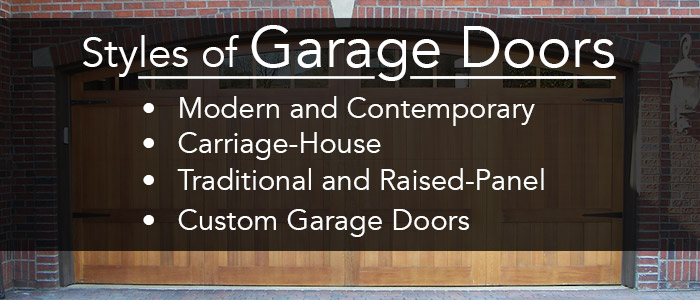
Pick the Right Color
Now that you’ve selected your material and the style of garage door, it’s time to give some thought to the color. Some people prefer to match the color of their home as closely as they can, while others choose another color altogether. Regardless of what you decide to do, make sure the color you choose complements the color of your home. We mentioned new garage doors can have a positive impact on your property value and curb appeal — don’t ruin that by choosing an offbeat color combination.
Local dealers are a great resource when it comes to choosing a color that will match or complement the color of your home. Clopay also has a Color Blast® program that gives you the opportunity to choose from a wide variety of Sherwin-Williams® paint color options that are specially formulated to adhere to steel, aluminum, vinyl and plastic. Solar reflective paint maximizes energy efficiency, and the color finish is backed by a five-year warranty — no paint for five years? That’s a win.
Consider Additional Garage Door Features
While the style of garage doors you choose will dictate some of the look and feel, there are additional features available with most styles that can add some unique flair and function to your garage doors.
- Insulation is important. While there are some materials that naturally insulate better than others, you always can add insulation to your garage doors. Clopay’s Intellicore® insulation technology is one step ahead of the rest, offering an injectable insulation foam that expands to fill the entire space. This insulation not only protects your garage from extreme temperatures, but also from noise — boasting R-values up to 20.4 and a noise reduction of up to 16 decibels. Choose from single, double or triple layers of insulation — the higher the number of layers, the higher the R-values.
- Windows are a decorative feature that are appealing to many. Even one strip of windows along the top of a garage door can add character — and light to filter into a garage that may be an otherwise dark space. The downside of adding windows is that they take away from the insulation. However, if you live in an area where extreme temperatures aren’t a concern, the aesthetics of windows just might be a feature worth considering.
- WindCode-rated doors are important to consider because they not only protect your garage from extreme climates, they also give you additional protection against intruders. The additional security features in place on these doors make them a sturdier option — without sacrificing the look. If you live in an area that is prone to hurricanes, your local codes may require a certain type of feature to ensure your garage doors can stand the weather. If that’s the case, WindCode-rated doors are an easy way to comply, while still getting the style you want.
- Hardware and handles may be small, but they are a big deal when it comes to garage doors. Whether you’re a minimalist and believe less is more, or you like the look of having hardware to add extra visual interest, you have options. Give some thought to what you prefer, and know that if you like hardware and handles, it’s available without getting those carriage-house garage doors.
- Garage door openers have come a long way. Maybe you already have a traditional garage opener you’re planning on keeping, or perhaps you were just thinking about buying a standard opener for your new door. Battery backup is one basic feature that isn’t available on many older models. This feature is great, because you never have to worry about being stuck in your garage during a power outage. On the other hand, if you crave the latest technology, you may want to spend some time looking into Wi-Fi and Bluetooth-enabled garage door openers — that’s right, no more waiting until you’re in that magical range. Now, you can control your garage door from an app on your smartphone.
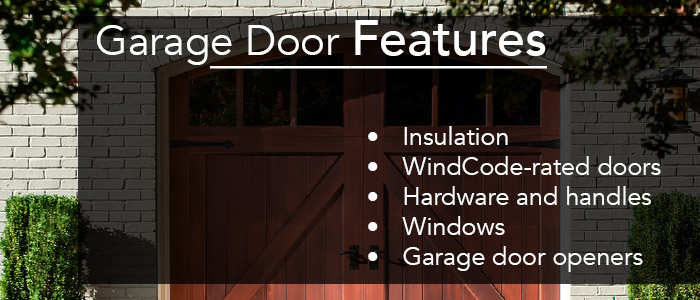
Don’t Forget About Maintenance and Care
Choosing and installing your new garage doors is only the beginning. Once the new doors are part of your home, maintenance and care kick in. When you’re considering maintenance and care, it’s important to fully understand the details of your garage doors’ warranty. How long is the warranty? What does it cover? Are there any restrictions to the warranty? Do you need to do anything to activate the warranty once you’ve purchased the garage doors? The last thing you want to do is accidentally void the warranty by doing — or not doing — something simple.
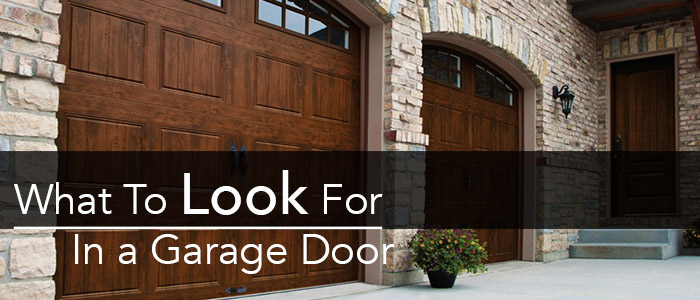
In addition to the warranty, don’t forget to ask what level of routine maintenance is recommended to keep your garage doors in their best working condition. It’s important to make sure your garage doors are working properly, so research what needs to be checked, and how frequently. Also, learn what you can about your new doors and opener and how everything works — that way, in between maintenance, you can conduct a visual inspection to make sure everything looks good and is working the way it should.
Finally, if you’ve chosen a painted or stained door, eventually you’ll need to repaint or re-stain. Before you purchase, ask about the process of painting — is it something you can do yourself? If so, are there guidelines? Is there a timeline for how long the paint or stain will last? You want to make sure you fully understand what you need to do so you don’t end up using the wrong type of paint or missing an important guideline that puts you back in the market for a new garage door.
Best Overhead Door — Your Partner for Selecting the Perfect Garage Door
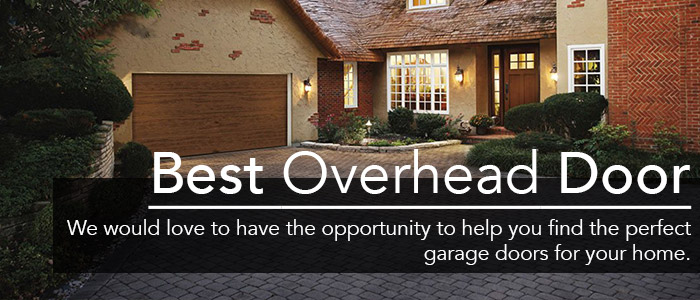
At Best Overhead Door, we know you wish you could see the new doors on your home before they’re installed, just to be sure they’re exactly what you want. That’s why we developed an online design tool that does just that. Our online lookbook gives you the opportunity to see all the styles of garage doors in one place. Then, once you’ve narrowed it down to a few favorites, use our EZDoor™ Design Tool to upload a photo of your garage and try them on. You can change everything, from the style to the color, and even the hardware. This tool is sure to give you a true vision of how your new doors will make your home look.
At Best Overhead Door, we provide customers throughout the entire Portland metro area and Vancouver, Wash., with quality garage door services. Whether you are building, remodeling, retrofitting or repainting your home or business facilities, we would love to help you. If you use one of our online tools and would like to get a quote — or just want to talk to one of our garage door experts as you’re deciding what garage doors are best for you — call us at (503) 620-1205 or fill out our online contact form. You can also request an estimate through our online form, or reach us on weekends and evenings by calling (503) 707-0848 and we will be happy to assist you. We would love to have the opportunity to help you find the perfect garage doors for your home.
Related Posts
Home Improvement Projects With the Best ROI
Benefits of a Custom Garage Door
Tips for Keeping Your Garage Organized and Clean Year-Round

